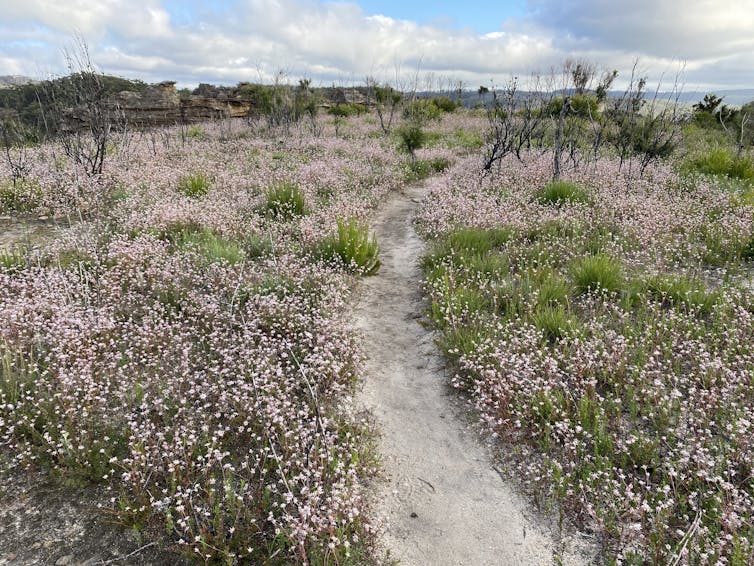inbox and environment news: Issue 603
October 29 - November 4, 2023: Issue 603
Fledgling Magpie Being Fed
The Largest Spotted Gum In The World: Old Blotchy
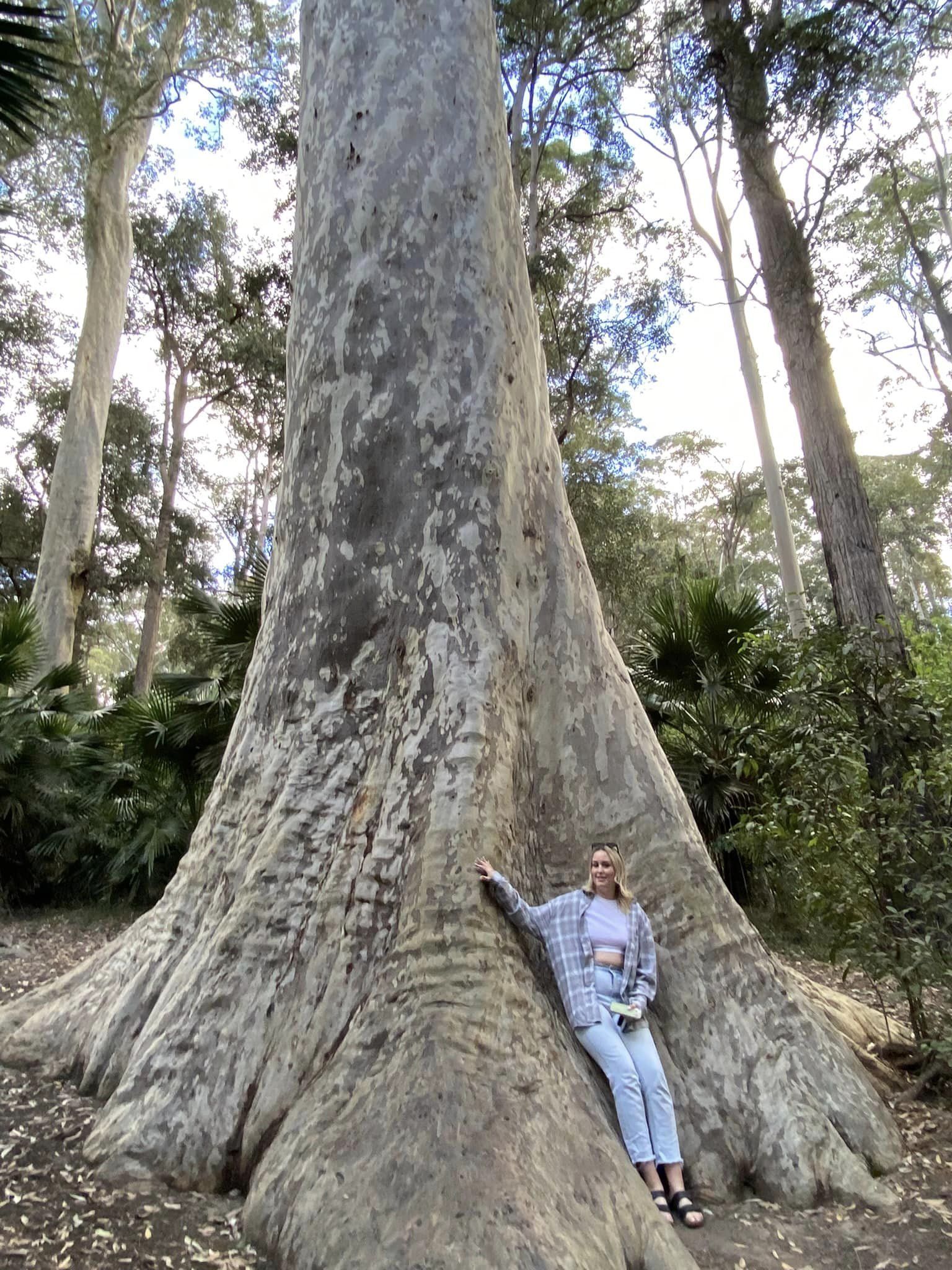
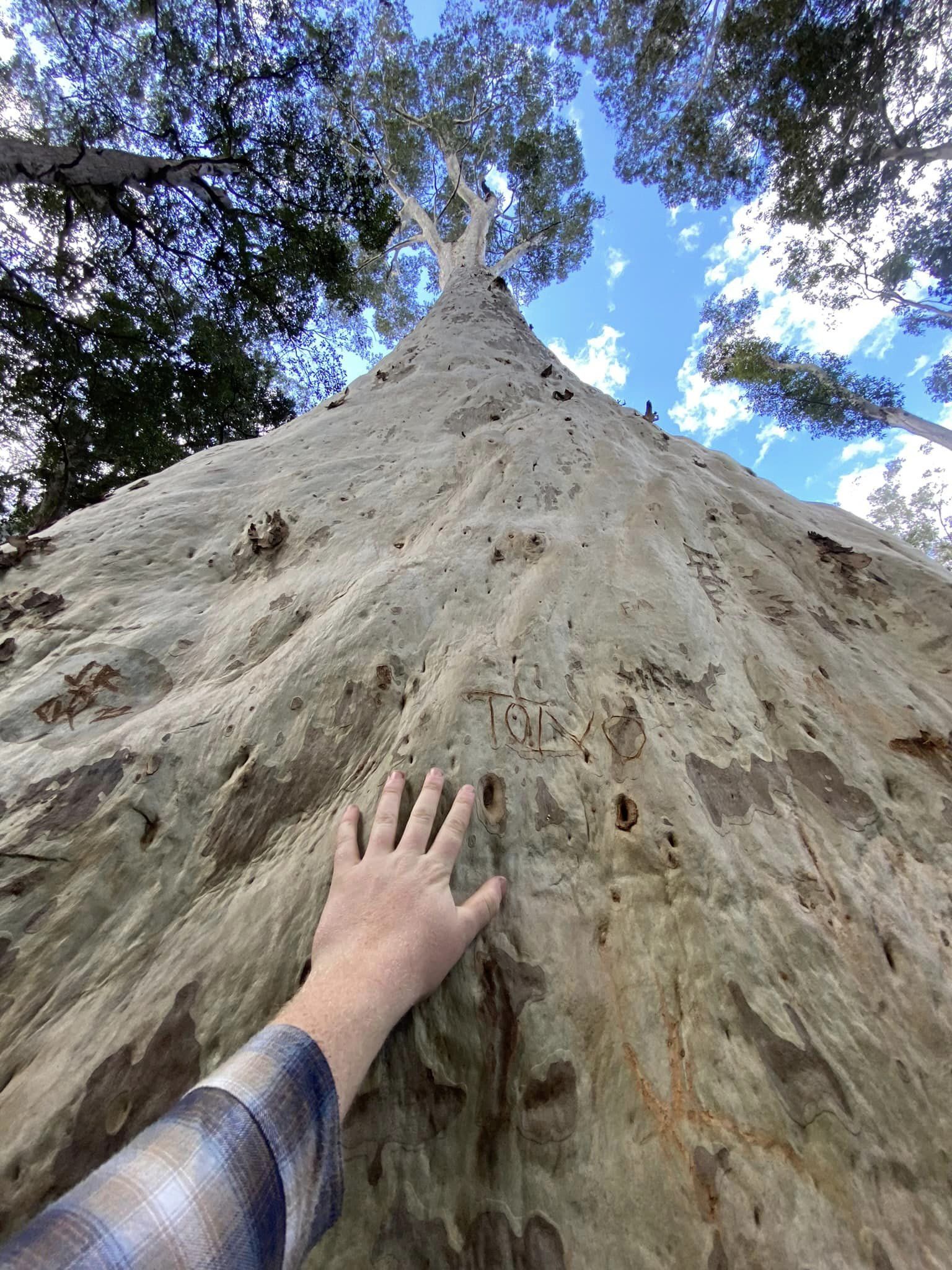
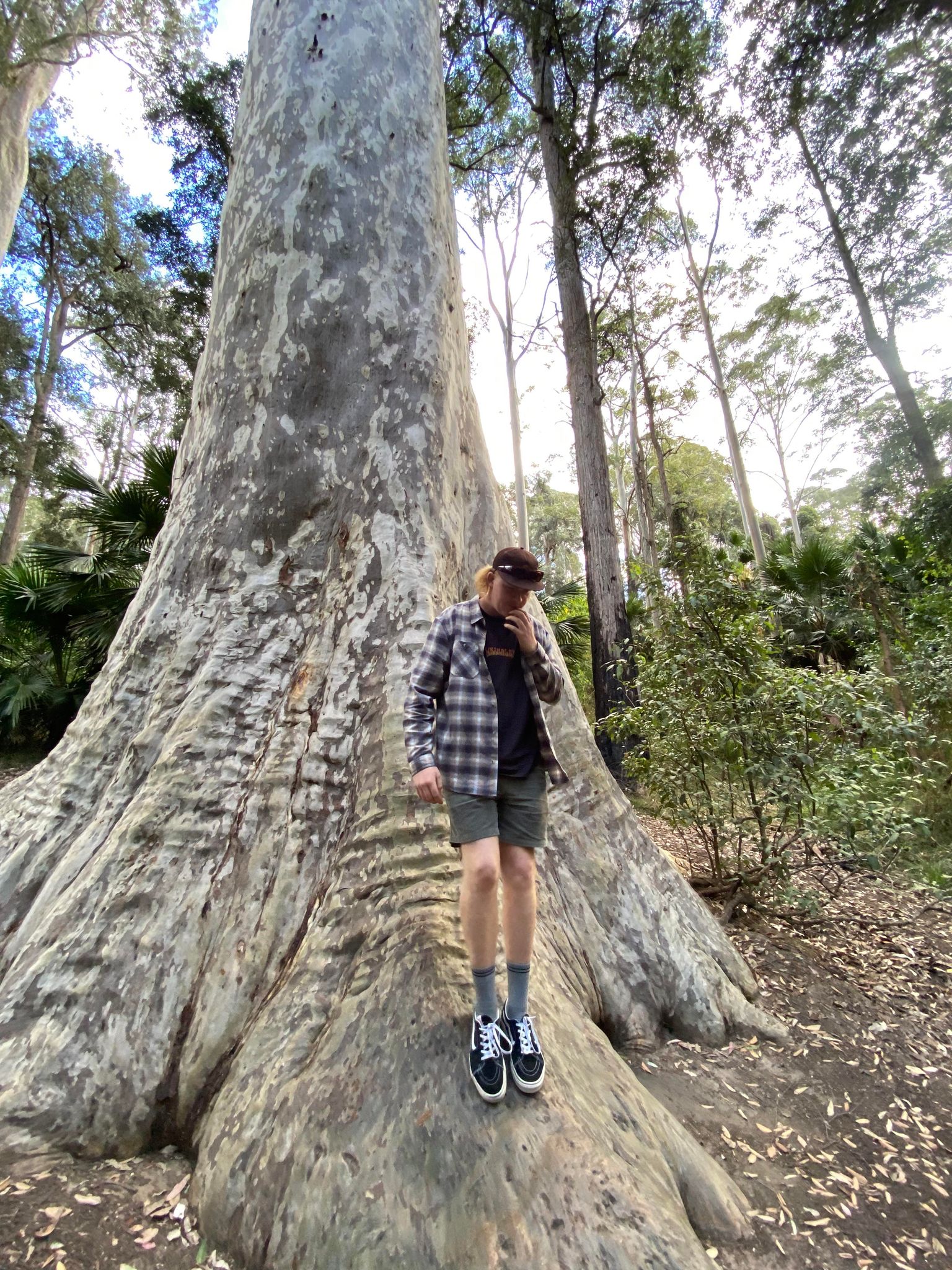
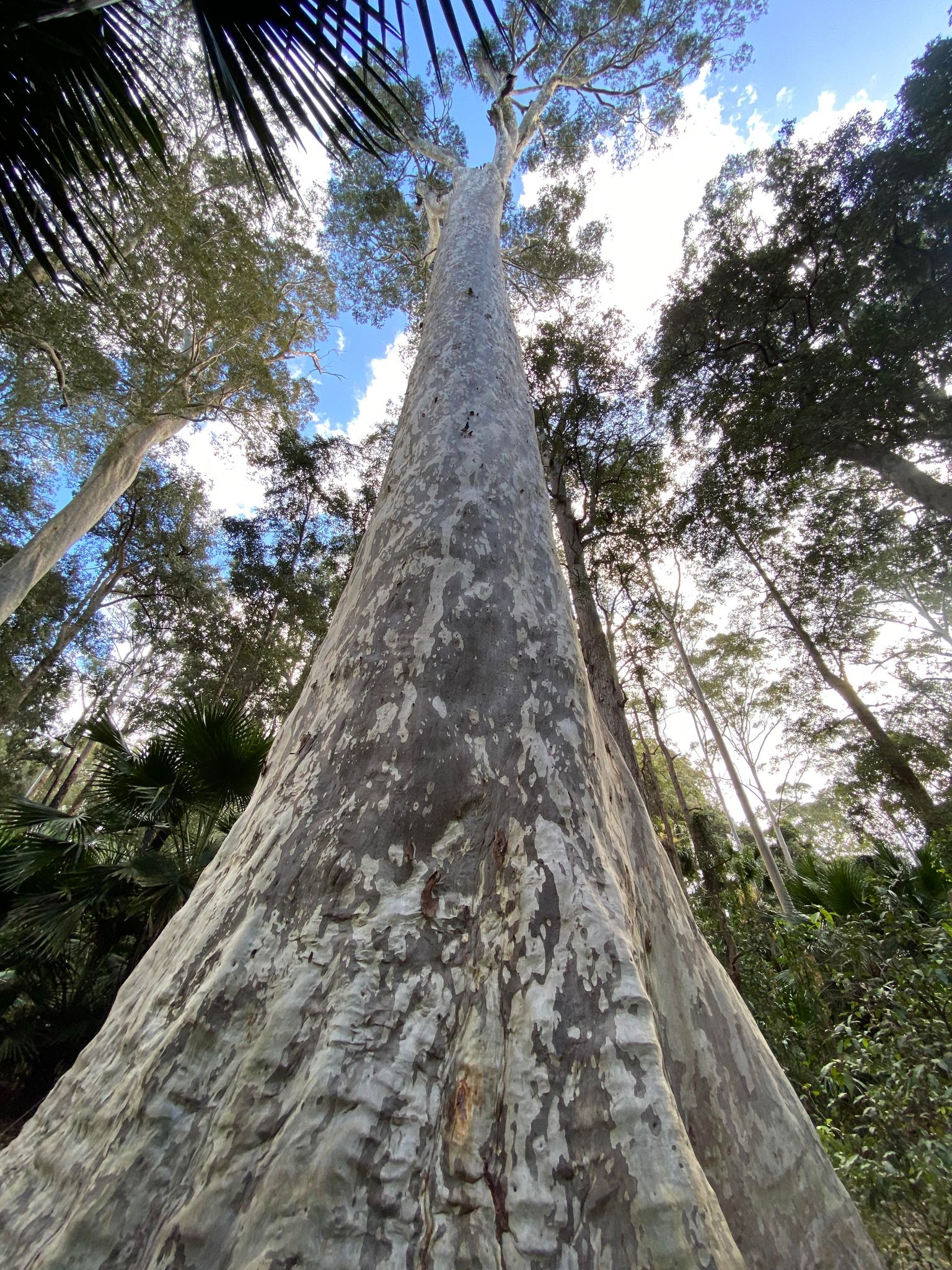
Please Look Out For Wildlife During This Spring Heat

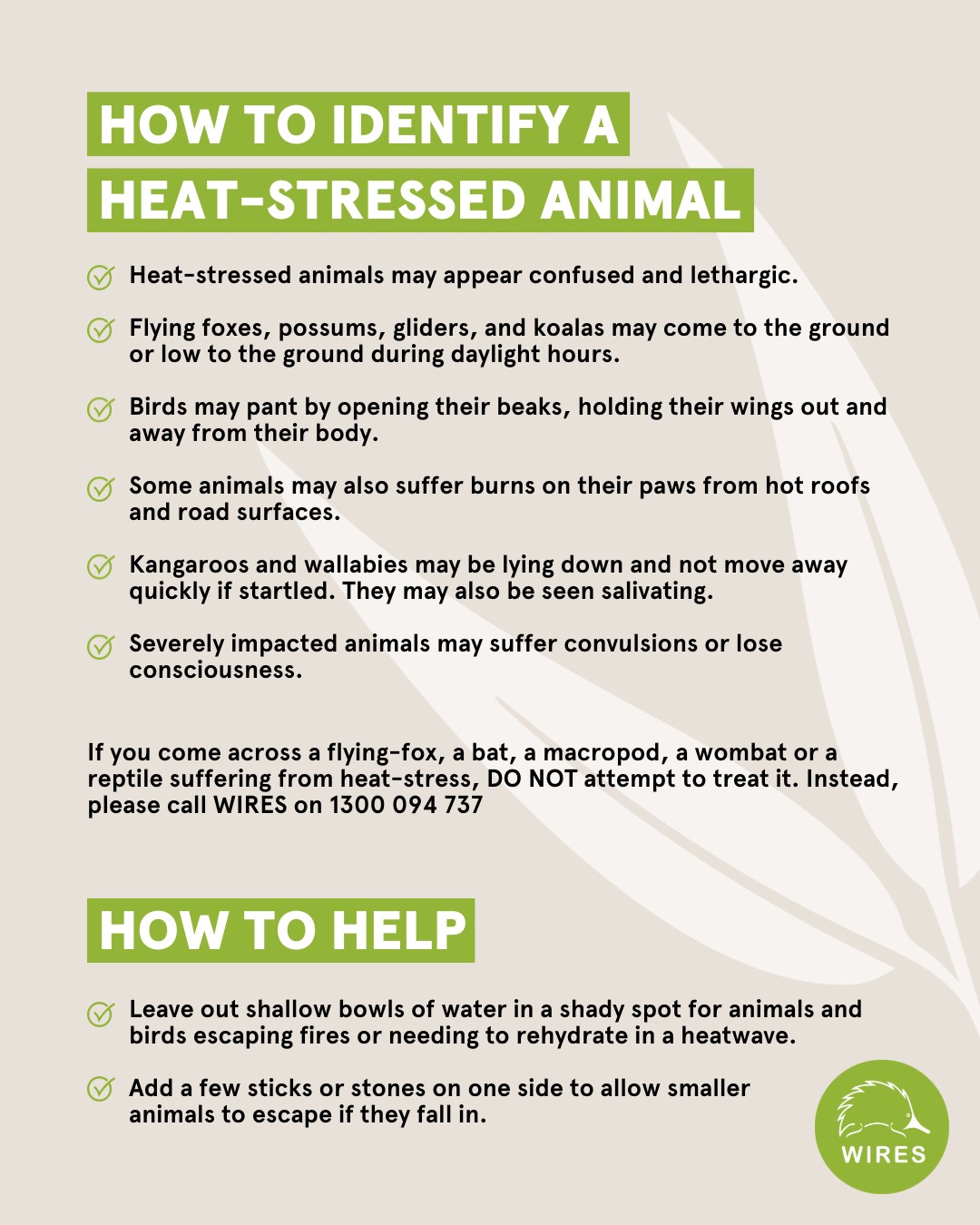
AER Releases Social Licence For Electricity Transmission Directions Paper
- What expectations should be held of transmission businesses in undertaking community engagement
- What outcomes need to be achieved from engagement
- When and how social licence issues can be factored into regulatory tests for the approval of and recovery of cost for new transmission development
- What evidence is needed to justify transmission network expansion and associated expenditure.
- clearly identify the information that is the subject of the confidentiality claim
- provide a non-confidential version of the submission in a form suitable for publication.
Bushwalk Fundraiser
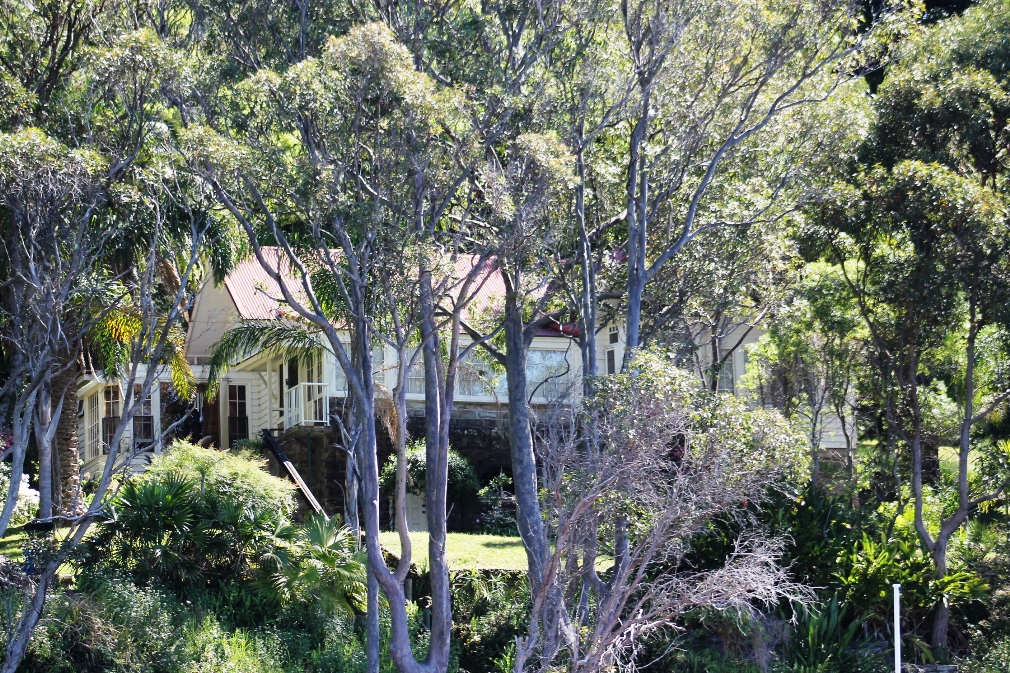
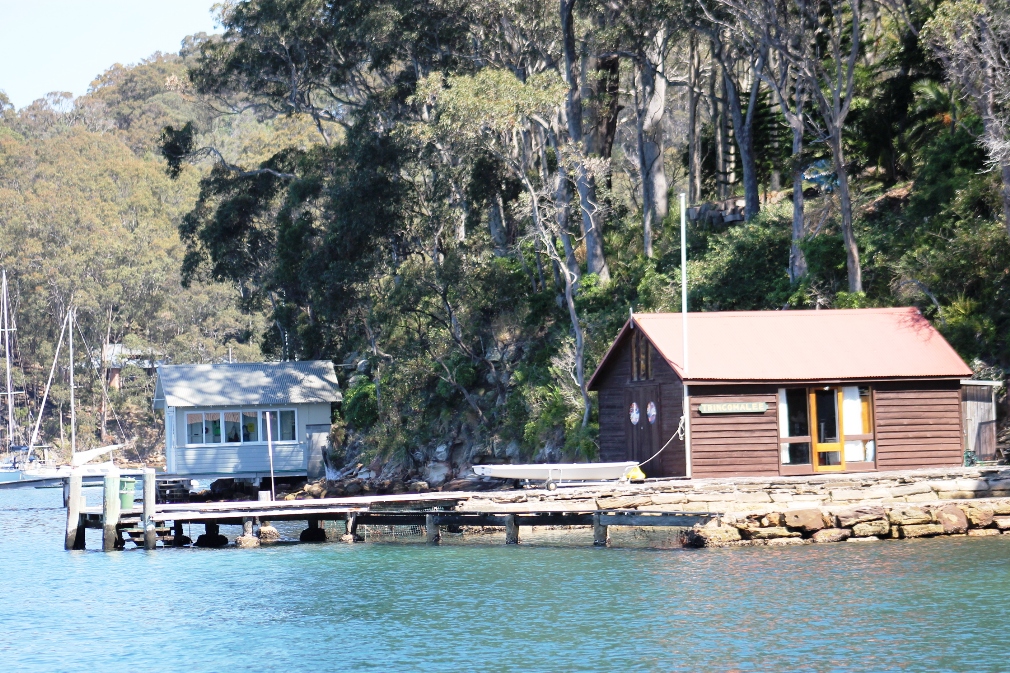
- Friday 10 November
- Friday 8 December
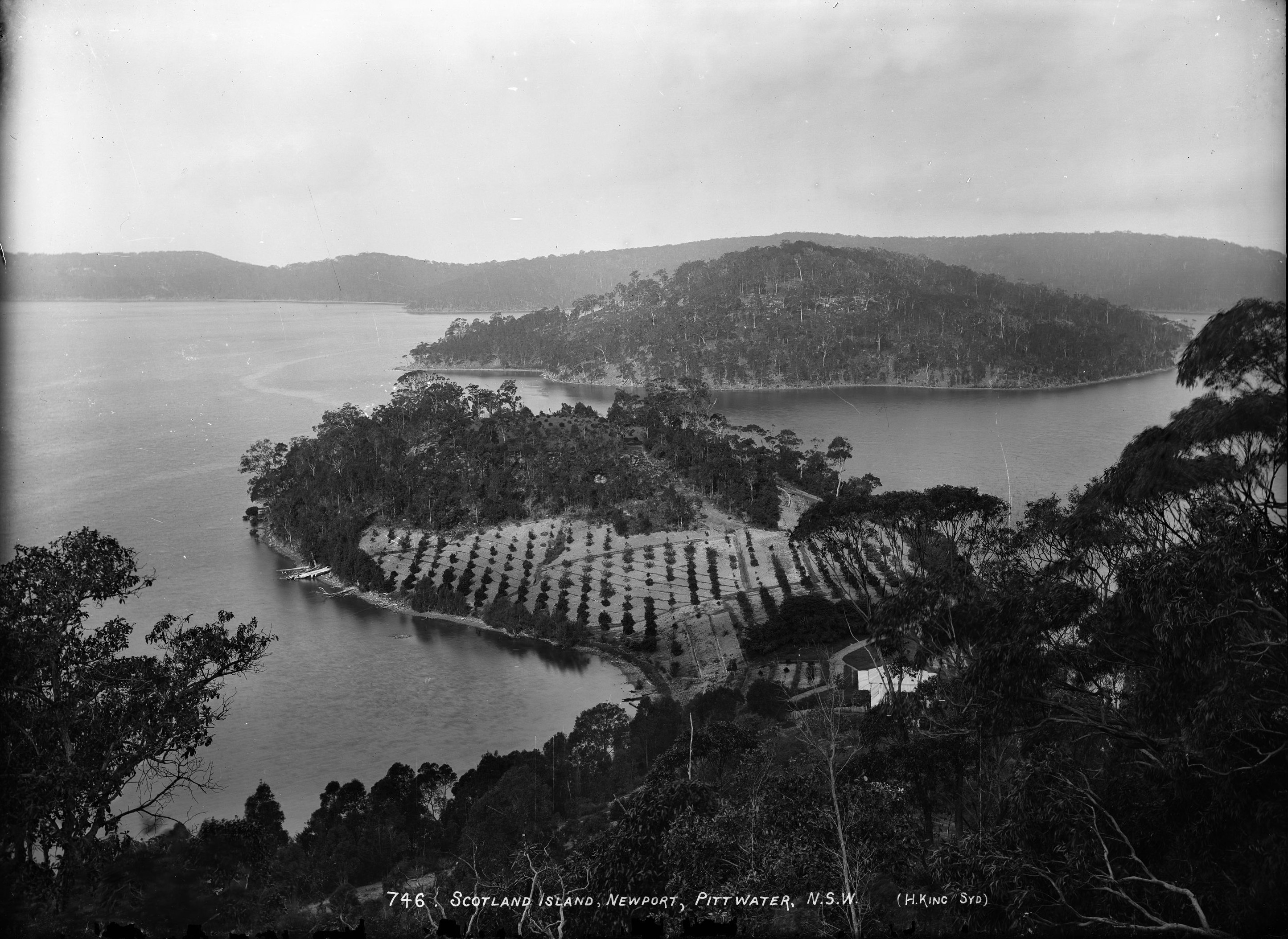
'Scotland Island, Newport, Pittwater, N.S.W.', photo by Henry King, Sydney, Australia, c. 1880-1886. and section from to show cottage on neck of peninsula at western end with no chimneys through roof. From Tyrell Collection, courtesy Powerhouse Museum
𝗞𝗶𝗺𝗯𝗿𝗶𝗸𝗶 𝗥𝗲𝘀𝗼𝘂𝗿𝗰𝗲 𝗥𝗲𝗰𝗼𝘃𝗲𝗿𝘆 𝗖𝗲𝗻𝘁𝗿𝗲 𝗶𝗻𝘃𝗶𝘁𝗲𝘀 𝘁𝗵𝗲 𝗰𝗼𝗺𝗺𝘂𝗻𝗶𝘁𝘆 𝘁𝗼 𝗼𝘂𝗿 𝗢𝗽𝗲𝗻 𝗗𝗮𝘆 𝟮𝟬𝟮𝟯 𝗮𝘁 𝗧𝗵𝗲 𝗛𝗨𝗕 - 𝗞𝗶𝗺𝗯𝗿𝗶𝗸𝗶.
Highlighting the four resident not-for-profit organisations: Peninsula Seniors Toy Recyclers, Bikes4Life, Boomerang Bags Northern Beaches - Kimbriki, Reverse Garbage and their dedicated volunteers.
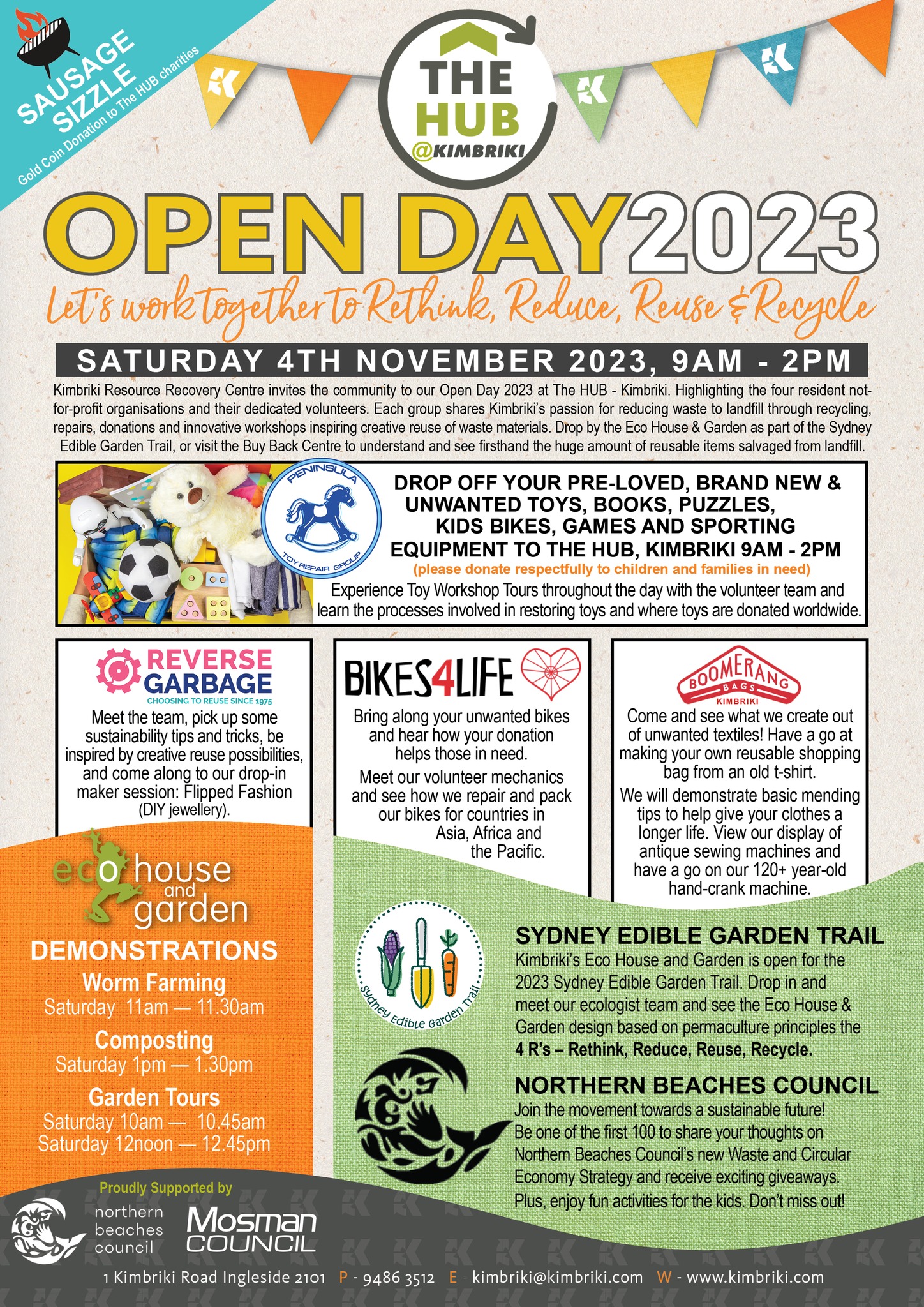
Palmgrove Park Avalon: New Bushcare Group Begins
 Palmgrove Park Avalon is a remnant of the Spotted Gum forest that was once widespread on the lower slopes of the Pittwater peninsula. This bushland’s official name and forest type is Pittwater and Wagstaffe Endangered Ecological Community, endangered because so much has been cleared for suburban development. Canopy trees, smaller trees and shrubs, and ground layer plants make up this community. Though scattered remnant Spotted Gums remain on private land, there is little chance of seedlings surviving in gardens and lawns. More information HERE
Palmgrove Park Avalon is a remnant of the Spotted Gum forest that was once widespread on the lower slopes of the Pittwater peninsula. This bushland’s official name and forest type is Pittwater and Wagstaffe Endangered Ecological Community, endangered because so much has been cleared for suburban development. Canopy trees, smaller trees and shrubs, and ground layer plants make up this community. Though scattered remnant Spotted Gums remain on private land, there is little chance of seedlings surviving in gardens and lawns. More information HERE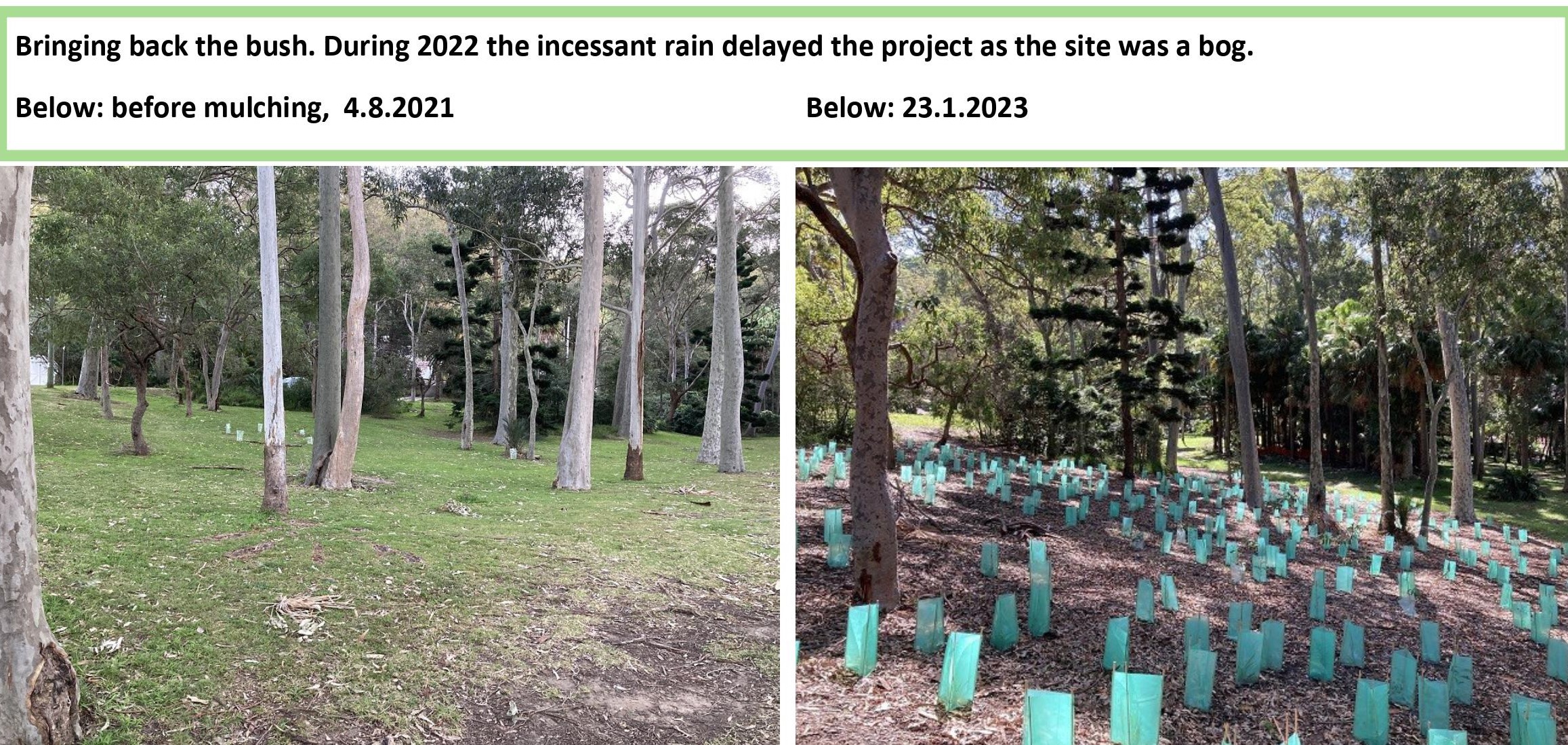
PNHA Guided Nature Walks 2023
Our walks are gentle strolls, enjoying and learning about the bush rather than aiming for destinations. Wear enclosed shoes. We welcome interested children over about 8 years old with carers. All Welcome.
So we know you’re coming please book by emailing: pnhainfo@gmail.com and include your phone number so we can contact you if weather is doubtful.
The whole PNHA 2023 Guided Nature Walks Program is available at: http://pnha.org.au/test-walks-and-talks/
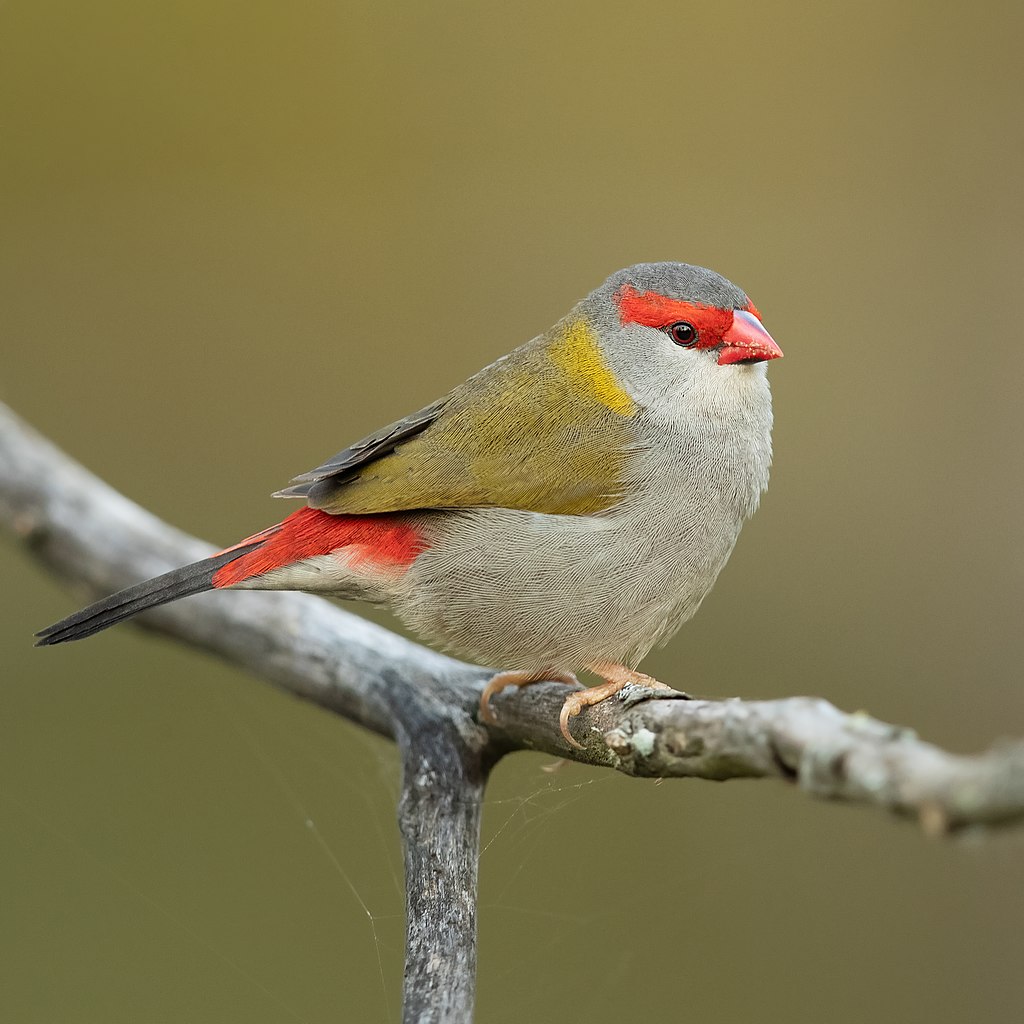
Red-browed finch (Neochmia temporalis). Photo: J J Harrison
Report Fox Sightings
%20(1).jpg?timestamp=1675893929686)
Marine Wildlife Rescue Group On The Central Coast
A new wildlife group was launched on the Central Coast on Saturday, December 10, 2022.
Marine Wildlife Rescue Central Coast (MWRCC) had its official launch at The Entrance Boat Shed at 10am.
The group comprises current and former members of ASTR, ORRCA, Sea Shepherd, Greenpeace, WIRES and Wildlife ARC, as well as vets, academics, and people from all walks of life.
Well known marine wildlife advocate and activist Cathy Gilmore is spearheading the organisation.
“We believe that it is time the Central Coast looked after its own marine wildlife, and not be under the control or directed by groups that aren’t based locally,” Gilmore said.
“We have the local knowledge and are set up to respond and help injured animals more quickly.
“This also means that donations and money fundraised will go directly into helping our local marine creatures, and not get tied up elsewhere in the state.”
The organisation plans to have rehabilitation facilities and rescue kits placed in strategic locations around the region.
MWRCC will also be in touch with Indigenous groups to learn the traditional importance of the local marine environment and its inhabitants.
“We want to work with these groups and share knowledge between us,” Gilmore said.
“This is an opportunity to help save and protect our local marine wildlife, so if you have passion and commitment, then you are more than welcome to join us.”
Marine Wildlife Rescue Central Coast has a Facebook page where you may contact members. Visit: https://www.facebook.com/profile.php?id=100076317431064
- Ph: 0478 439 965
- Email: marinewildlifecc@gmail.com
- Instagram: marinewildliferescuecc

Watch Out - Shorebirds About
.JPG.opt1460x973o0,0s1460x973.jpg?timestamp=1663629195339)
Possums In Your Roof?: Do The Right Thing
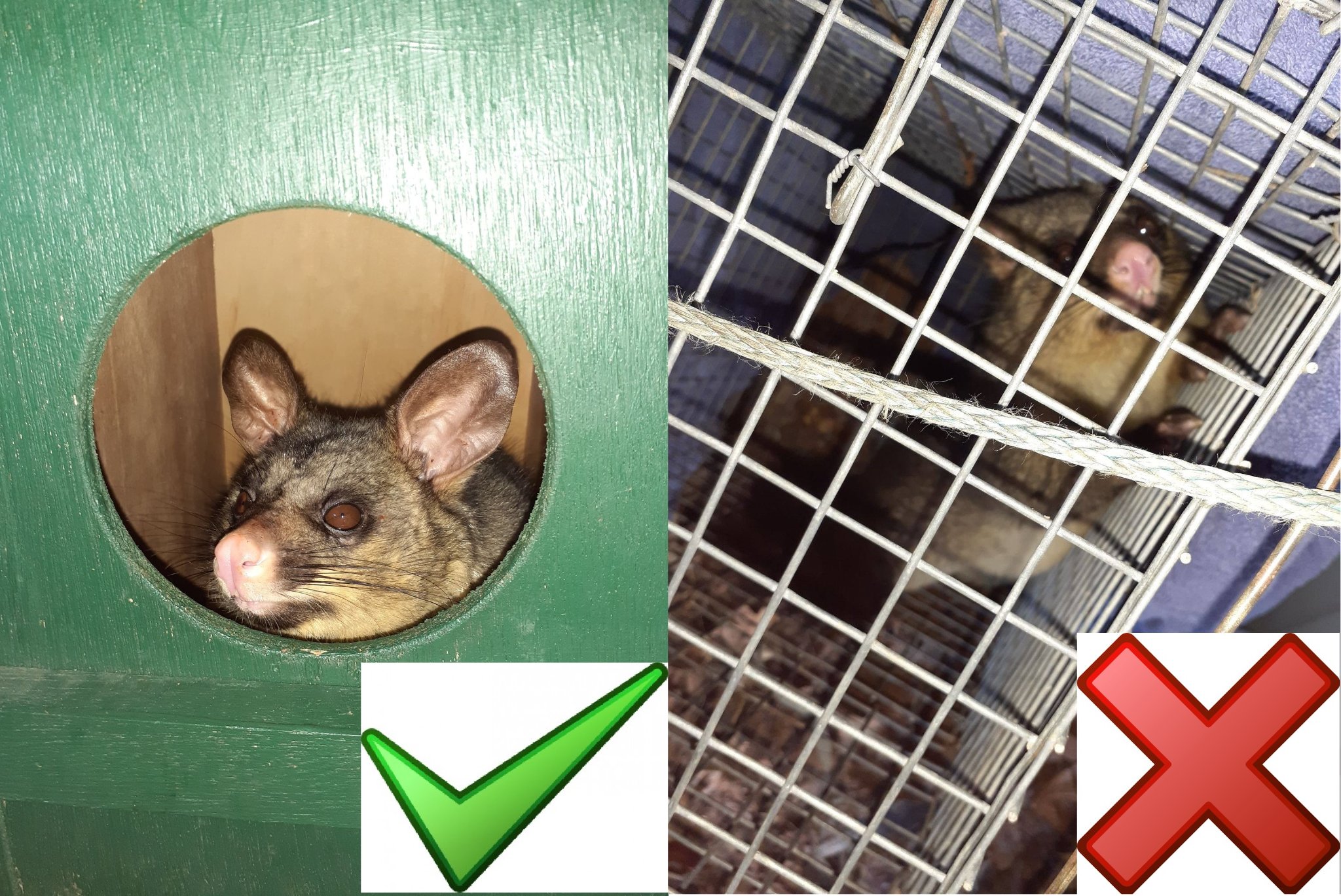
Aviaries + Possum Release Sites Needed

Bushcare In Pittwater
Where we work Which day What time
Avalon
Angophora Reserve 3rd Sunday 8:30 - 11:30am
Avalon Dunes 1st Sunday 8:30 - 11:30am
Avalon Golf Course 2nd Wednesday 3 - 5:30pm
Careel Creek 4th Saturday 8:30 - 11:30am
Toongari Reserve 3rd Saturday 9 - 12noon (8 - 11am in summer)
Bangalley Headland 2nd Sunday 9 to 12noon
Bayview
Winnererremy Bay 4th Sunday 9 to 12noon
Bilgola
North Bilgola Beach 3rd Monday 9 - 12noon
Algona Reserve 1st Saturday 9 - 12noon
Plateau Park 1st Friday 8:30 - 11:30am
Church Point
Browns Bay Reserve 1st Tuesday 9 - 12noon
McCarrs Creek Reserve Contact Bushcare Officer To be confirmed
Clareville
Old Wharf Reserve 3rd Saturday 8 - 11am
Elanora
Kundibah Reserve 4th Sunday 8:30 - 11:30am
 Mona Vale
Mona Vale Mona Vale Beach Basin 1st Saturday 8 - 11am
Mona Vale Dunes 2nd Saturday +3rd Thursday 8:30 - 11:30am
Newport
Bungan Beach 4th Sunday 9 - 12noon
Crescent Reserve 3rd Sunday 9 - 12noon
North Newport Beach 4th Saturday 8:30 - 11:30am
Porter Reserve 2nd Saturday 8 - 11am
North Narrabeen
Irrawong Reserve 2nd Saturday 2 - 5pm
Palm Beach
North Palm Beach Dunes 3rd Saturday 9 - 12noon
Scotland Island
Catherine Park 2nd Sunday 10 - 12:30pm
Elizabeth Park 1st Saturday 9 - 12noon
Pathilda Reserve 3rd Saturday 9 - 12noon
Warriewood
Warriewood Wetlands 1st Sunday 8:30 - 11:30am
Whale Beach
Norma Park 1st Friday 9 - 12noon
Western Foreshores
Coopers Point, Elvina Bay 2nd Sunday 10 - 1pm
Rocky Point, Elvina Bay 1st Monday 9 - 12noon
Friends Of Narrabeen Lagoon Catchment Activities

Gardens And Environment Groups And Organisations In Pittwater
Biodiversity Can Rebound After Bushfires But Recovery Lags In Severely Burnt Areas: UNSW
October 23, 2023
by Ben Knight, UNSW Media
Extreme fires drove biodiversity declines despite overall resilience after the 2019-2020 Black Summer bushfire season in NSW, a new study suggests.
The Black Summer Bushfires burnt an unprecedented area of over 5 million hectares of eastern Australia, with severe economic, environmental, and human impacts. Now, a study conducted by UNSW Sydney researchers shows plant and animal life has struggled to rebound in locations subjected to the most severe fires.
The study, published in the journal Global Change Biology, analysed differences in species diversity in the aftermath of the 2019-2020 bushfire season in New South Wales. The researchers found that up to 18 months post-fire, biodiversity can recover after fires of low to high severity (when fires burnt the understorey and scorched or partially consumed the canopy) – and did increase a year and a half after the Black Summer Bushfires. However, areas burnt by fires of extreme severity (when fires completely consumed the canopy) experienced reduced levels of biodiversity compared to unburnt and other less severe burnt regions.
Associate Professor Will Cornwell, senior co-author of the study from the School of Biological, Earth & Environmental Sciences, says the findings highlight the fire adaptations of Australian fauna and flora, but also that these adaptations have limits.
“Fire can have both positive and negative effects on biodiversity, and the context is crucial,” A/Prof. Cornwell says. “For example, many Australian species can persist, even with very high severity fires, but some species may struggle when extreme fire severity occurs over large scales.”
Simon Gorta, lead author of the study and a PhD candidate at the UNSW Centre for Ecosystem Science, says the research will help scientists and conservation managers understand which animal and plant species may be impacted by future fires, and identify the areas most needing monitoring and management.
“Our findings illustrate the extent and severity that fires can reach under extensive drought and above-average temperatures, conditions typical of climate change projections,” Mr Gorta says. “As we grapple with the effects of these events on lives and property, we should also be concerned about how our wildlife and ecosystems respond, and how this can be better managed.”
Differing post-fire recovery regions
For the study, the researchers used tens of thousands of wildlife observations of multiple groups of invertebrates, plants, and vertebrates collected by citizen scientists as part of the Environment Recovery Project and the iNaturalist platform to investigate how biodiversity has recovered after the fires and how the type of fire is essential for determining recovery trajectories.
“This initiative was critical, as long-term biodiversity monitoring data covering multiple groups of organisms, such as plants, insects, birds, and more, especially at the scale of these mega-fires, does not exist outside of citizen science data,” Mr Gorta says. “These data allow us to draw conclusions about the overall effects of these events and determine conservation and management approaches for post-fire recovery.”
Overall, the researchers discovered species diversity increased in burnt regions compared to before the fires in both burnt and unburnt parts. But, compared to unburnt regions, species diversity significantly decreased in areas exposed to extreme fire severity.
“The increase in species diversity, or richness, in burnt areas was greater than the increase after fires in unburned areas, which suggests they can recover well if fires are not too severe,” A/Prof. Cornwell says. “But pushing them into this high severity zone has the opposite effect on biodiversity.”
“Many Australian species can persist, even with very high severity fires, but some species may struggle when extreme fire severity occurs over large scales.”
The researchers say they’re not sure whether or when diversity in the extreme severity regions will fully recover.
“We don’t have the data yet to know whether diversity will bounce back – a lot will depend upon whether they burn again with the same intensity in upcoming fire seasons,” A/Prof. Cornwell says. “It implies that in the immediate post-fire aftermath, we need to focus our efforts on supporting recovery in areas that were subject to the highest severity burns.”
In addition to the findings at the biodiversity scale, the study also identified how species with post-fire recovery mechanisms can drive response patterns, particularly for plant species. For example, plants with limited resprouting capacity after severe fires in rainforests are particularly vulnerable to increasingly frequent and intense fires.
“The study highlighted adaptations such as fire-cued flowering, which is a key part of the life cycle of many Australian native plants, potentially increased the detectability and attractiveness of plants in the post-fire environment,” says Dr Mark Ooi, co-author of the study. “This provides both an understanding of the post-fire patterns we see and highlights some of the challenges in surveying biodiversity after these events.”
The researchers plan to conduct further studies monitoring different post-fire impacts, including which species are most at risk. They say the efforts of citizen scientists to capture observations represent not only a critical data resource but also reflect the willingness of the public to participate in science to protect the environment.
“Fire seasons are only going to worsen under the current climate projections,” Mr Gorta says. “We need amateur scientists to help grow the dataset further so we can continue to monitor and manage the environmental impacts of wildfires in a rapidly warming and fire-conducive climate.”
Simon B. Z. Gorta, Corey T. Callaghan, Fabrice Samonte, Mark K. J. Ooi, Thomas Mesaglio, Shawn W. Laffan, Will K. Cornwell. Multi-taxon biodiversity responses to the 2019–2020 Australian megafires. Global Change Biology, Oct. 2023. https://doi.org/10.1111/gcb.16955
Sea-Lovers Urged To Help To Save Sea Turtles This Nesting Season
.jpg?timestamp=1697895535957)
.jpg?timestamp=1697895565175)
- walk your local beach early in the morning, as sea turtles generally nest during the night.
- keep your eyes peeled for any tracks in the sand, which are usually 80–100 cm wide and can sometimes be mistaken for tire tracks.
- take your phone with you so you can quickly call NSW TurtleWatch or NPWS if you see any signs of turtles, tracks or a nest.
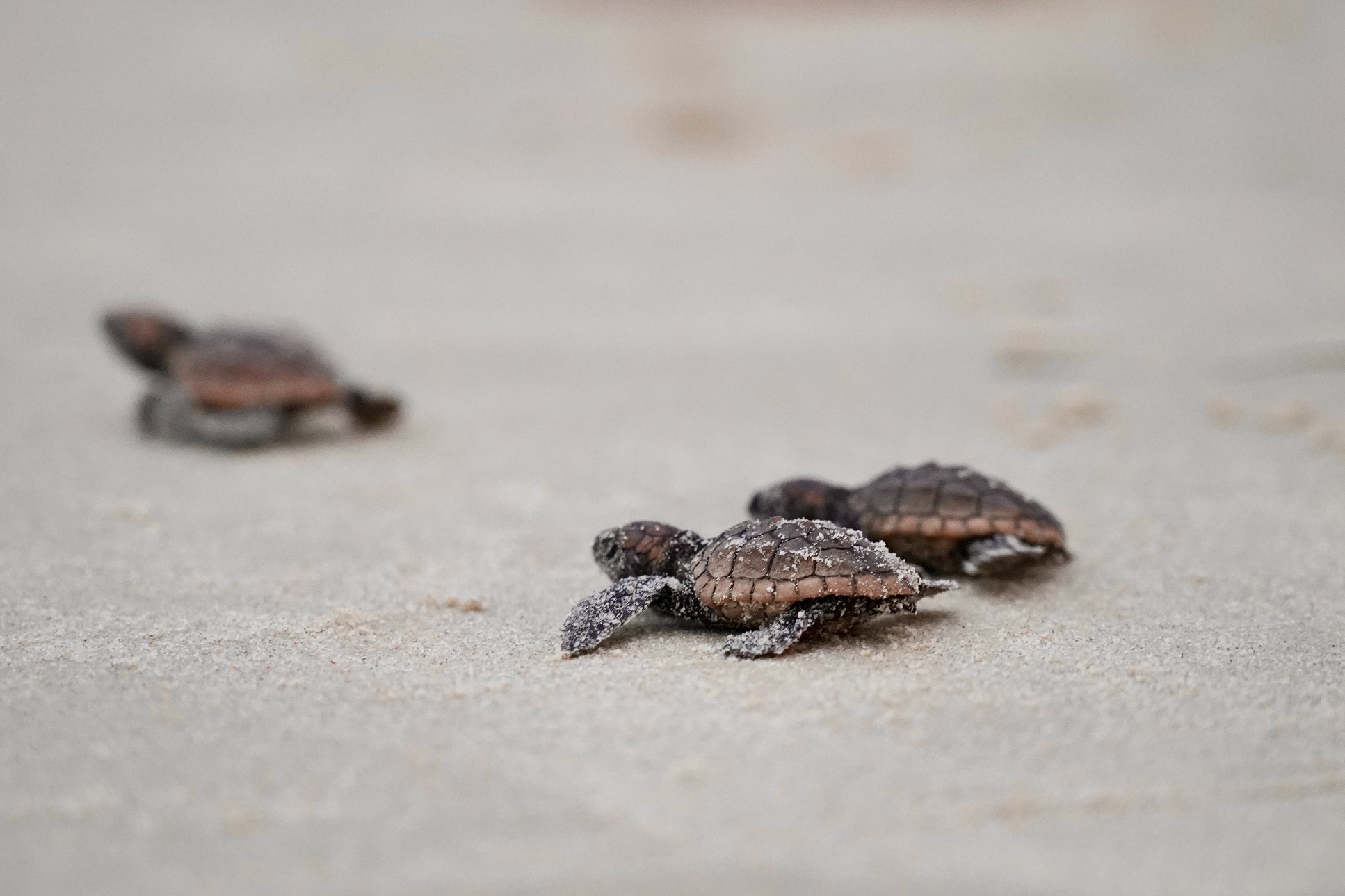
$16 Million For Crown Reserve Improvements
- Maintaining or increasing public access, amenity and use of a reserve.
- Supporting social cohesion and participation in community life.
- Enabling people with accessibility requirements or living with a disability to be included.
- Delivering a service or infrastructure to enable Aboriginal people to access, care for or protect and manage land.
- Conserving heritage values and/or natural values of a reserve.
- Creating employment or business opportunities.
Funding To Make Apartment Buildings Ready For EVs
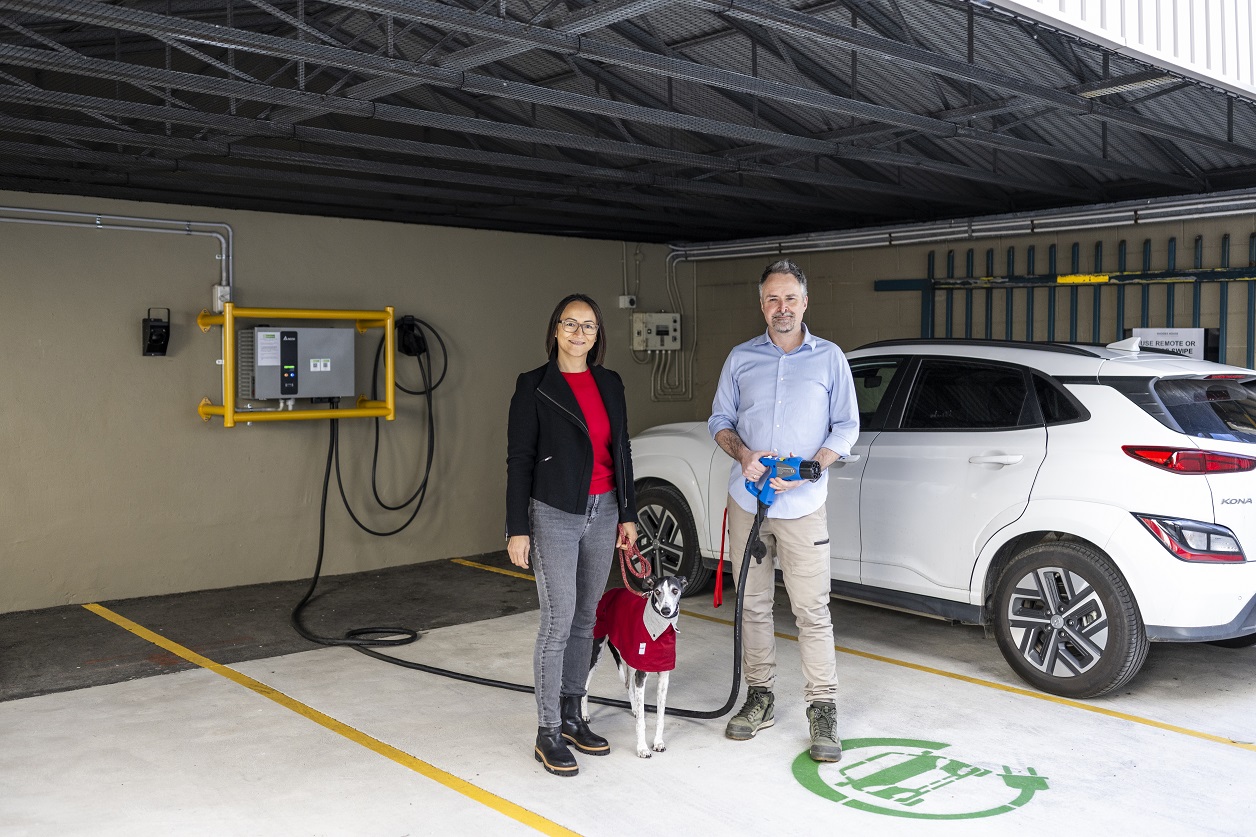
Have Your Say On 10-Year Trout Cod Recovery Roadmap
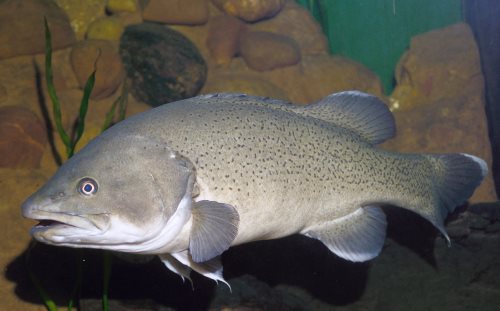 The Trout Cod (Maccullochella macquariensis) or bluenose cod, is a large predatory freshwater fish of the genus Maccullochella and the family Percichthyidae, closely related to the Murray cod. It was originally widespread in the south-east corner of the Murray-Darling river system in Australia, but is now an endangered species.
The Trout Cod (Maccullochella macquariensis) or bluenose cod, is a large predatory freshwater fish of the genus Maccullochella and the family Percichthyidae, closely related to the Murray cod. It was originally widespread in the south-east corner of the Murray-Darling river system in Australia, but is now an endangered species.$6 Million For Tamworth To Investigate Recycling Industrial Water
- Diversifying water sources to reduce demand on the town's water supply.
- Improving long-term water security for the region, including during droughts.
- Unlocking economic growth for agricultural businesses so they can expand operations without putting more pressure on Tamworth’s water network.
- Addressing water salinity issues that impact water quality and the environment.
Digital Safety Upgrades For NSW National Parks Bushwalkers
New Hope For Rare Australian Bird
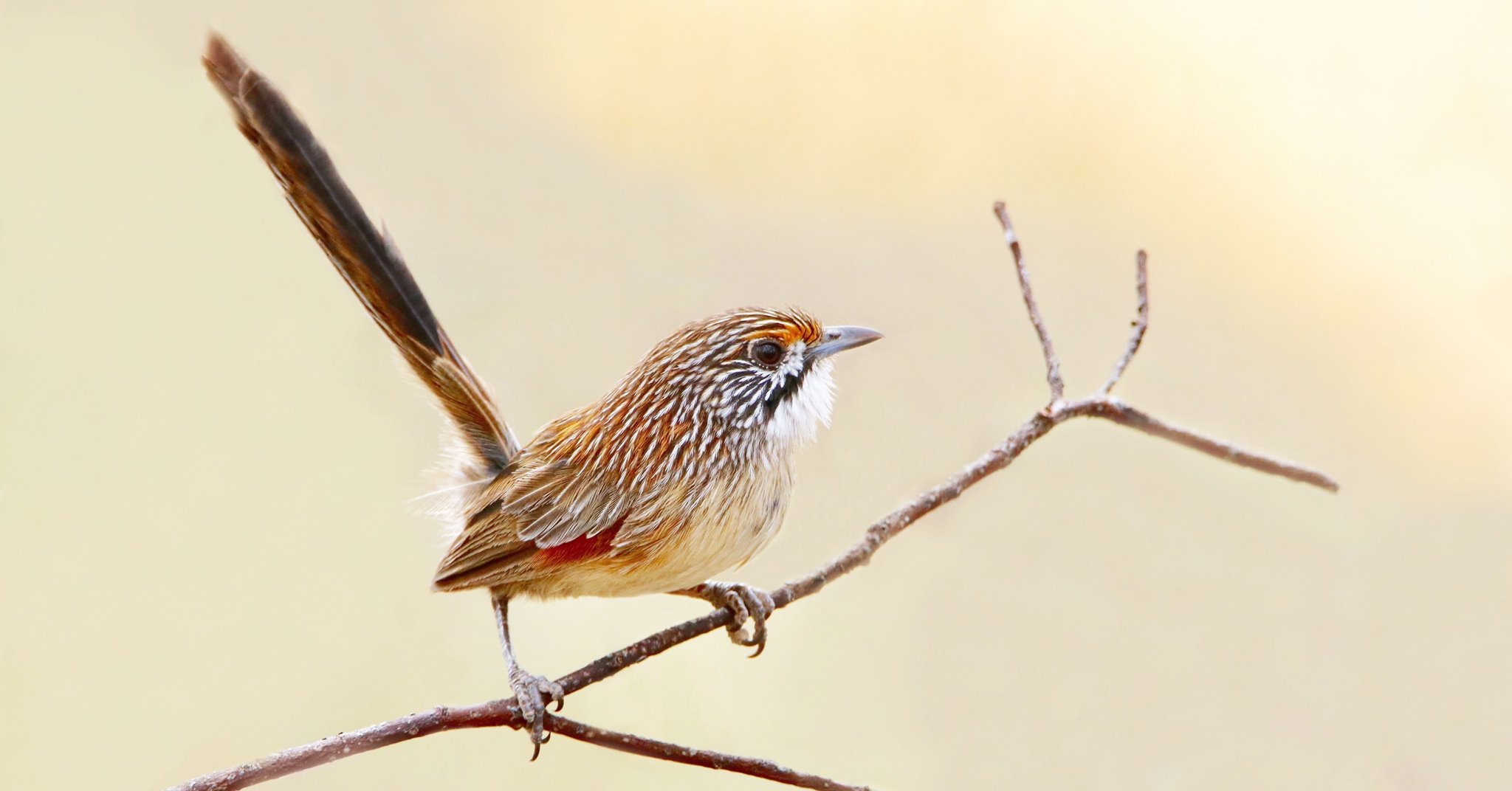
$1.5 Million For NSW Bushfire And Natural Hazards Research Centre Climate And Weather Research
2 biggest threats to wombats revealed in new data gathered by citizen scientists
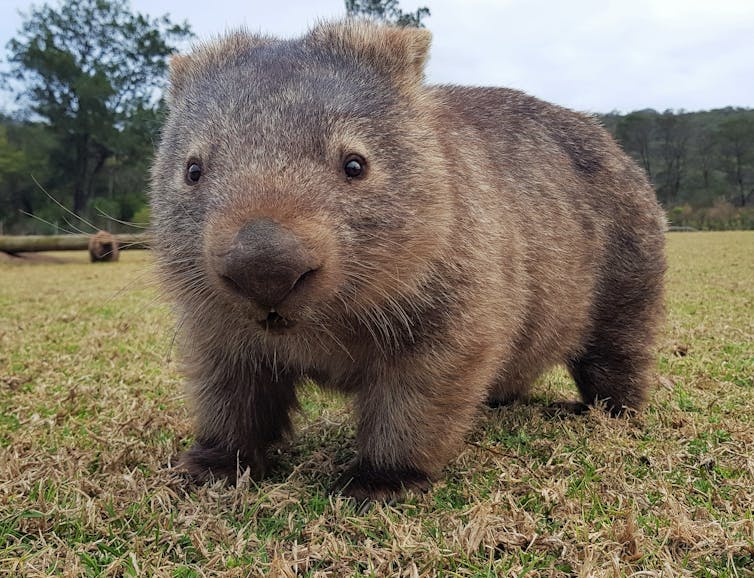
Launched in 2015, WomSAT (Wombat Survey and Analysis Tool) is a citizen science project and website that allows “wombat warriors” to report sightings of wombats, their burrows, and even their cube-shaped poops.
The project initially aimed to uncover information on all things wombat from across Australia, particularly threats. Its ultimate aim is to support conservation, informed by an enhanced understanding of wombat biology.
WomSAT also aims to educate the wider community by using the hashtag #WombatWednesday to spread the word. The project has resulted in raising the profile of wombats in the broader community.
People have jumped onboard to support the charismatic species, and thousands of posts have been shared via social media.
To date, citizen scientists across Australia have reported more than 23,000 wombat sightings to WomSAT. These sightings have recently been analysed and the findings published in Australian Mammalogy and Integrative Zoology.
Importantly, the data have given us new insights into where to find two of the biggest threats: Australia’s wombat roadkill hotspots, and the worst areas for sarcoptic mange (a disease related to scabies).
Making Our Roads Safer For Wombats
Wombats are large, mostly grass-eating native Australian marsupials. They play an essential role in maintaining biodiversity as ecological engineers. Through their burrowing, they maintain soil health and create habitat to support other plants and animals.
There are three species of wombats: the critically endangered northern hairy-nosed wombat (Lasiorhinus krefftii), the threatened southern hairy-nosed wombat (L. latifrons), and the bare-nosed or common wombat (Vombatus ursinus).
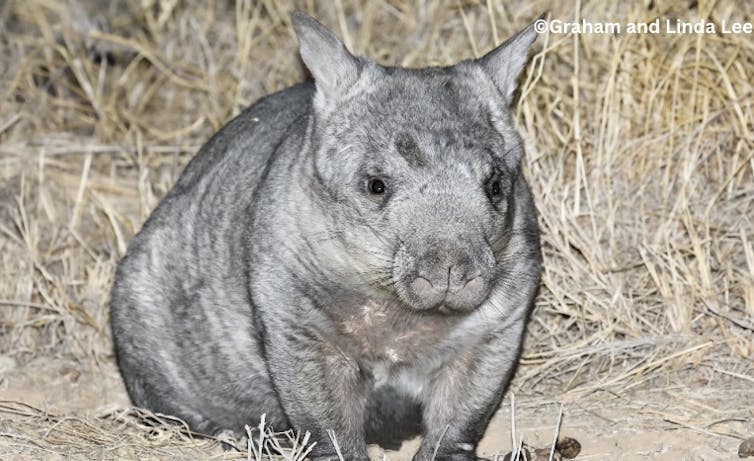
Like most Australian native animals, wombats are under threat on many different fronts – habitat destruction, changed fire regimes, competition from introduced species, and even direct persecution by humans, as they are deemed pests by some. The bare-nosed wombat is particularly impacted by roadkill and sarcoptic mange.
The new data reported to WomSAT have identified roadkill hotspots and factors affecting wombat vehicle collisions. Several areas were identified as roadkill hotspots, including Old Bega Road and Steeple Flat Road in southern New South Wales. Most wombat roadkill deaths occurred in winter, and sadly most appeared otherwise healthy.
Having better data and identifying these roadkill hotspots will ultimately reduce road risks for people and wombats. We can target these hotspots using mitigation strategies such as reduced speeds, signage and barriers to prevent wombat crossing and avoid collisions.
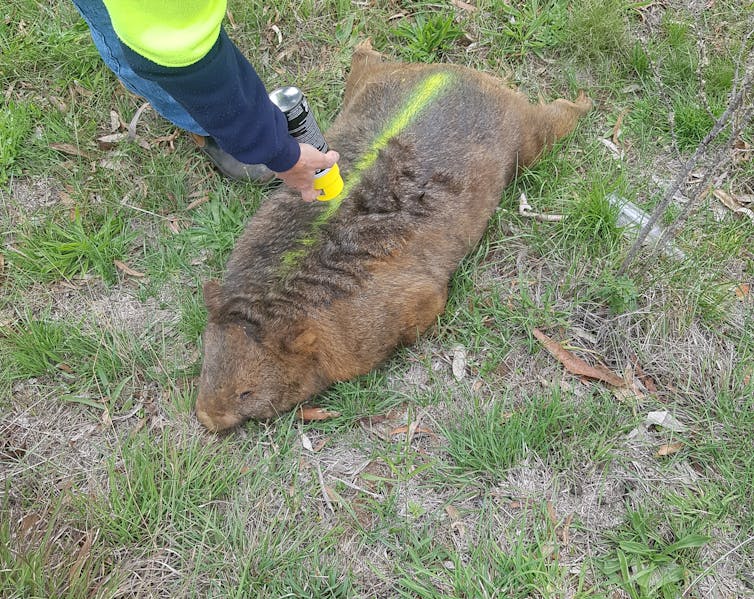
Mangy Marsupials
WomSAT data have also revealed that wombat populations in closer proximity to urban areas have more wombats with sarcoptic mange. Mange is a disease caused by the Sarcoptes scabiei mite.
In people this mite causes scabies. But in wombats, the disease is fatal if left untreated. The mites cause disease by burrowing into the skin of wombats, causing extreme itchiness and discomfort. Eventually it leads to large open wounds, and the wombat dies from secondary infections.
For sarcoptic mange reports, the season was not statistically significant, but rainfall was. This could potentially be because scabies mites thrive in more humid environments, but more research is needed.
Interestingly, our field research has also indicated that rainfall contributes to higher occurrence of sarcoptic mange in specific populations we have monitored over several years.
Overall, roadkill events and sarcoptic mange are two of the biggest threats to bare-nosed wombats. As we continue to track both over time, it will help us to better understand and mitigate these threats.
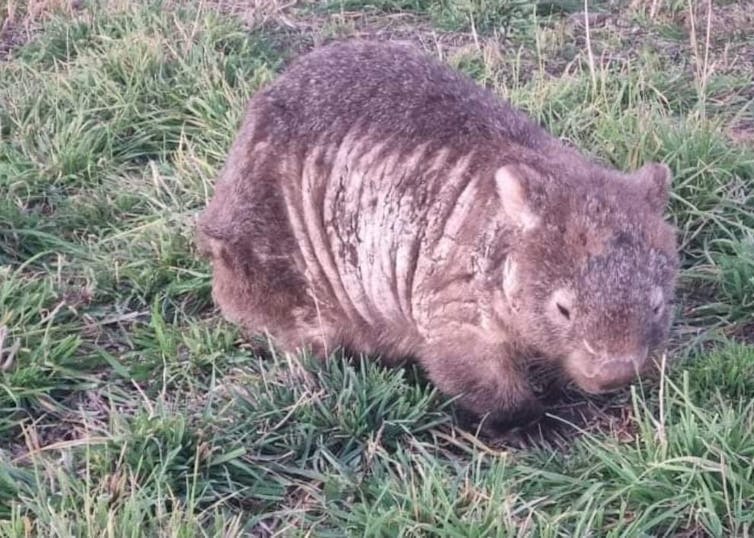
You Can Become A Wombat Warrior Too
Recent upgrades to WomSAT will now allow GPS location data embedded in photos taken using smartphones. Importantly, this means users can upload wombat sightings when they come back into phone signal or internet range.
Users can also now upload information where wombats are not found, which provides important information on wombat distribution and abundance.
Another new feature on WomSAT will assist wildlife carers to directly monitor and record treatment of wombats with sarcoptic mange in the field. In the past, treatment regimes have rarely been recorded. This will benefit the wider wildlife care network by highlighting areas where wombats are currently being treated, as well as new areas where wombats require treatment.
In the longer term, the resource will also help to support the development of better treatment regimes by recording treatment methods and tracking wombats (through photographs) to help monitor their recovery.
Regardless of the level of experience with wombats, everyone can get involved and become a wombat warrior. You can do so by reporting sightings of wombats and their burrows to the WomSAT website via a mobile phone or computer.
Ongoing reporting to WomSAT will provide more insights into these amazing marsupials. It can be used to assist with determining wombat distribution and abundance patterns, as well as help manage the threats they face.![]()
Julie Old, Associate Professor, Biology, Zoology, Animal Science, Western Sydney University and Hayley Stannard, Senior lecturer, Charles Sturt University
This article is republished from The Conversation under a Creative Commons license. Read the original article.
Cleaning up Australia’s 80,000 disused mines is a huge job – but the payoffs can outweigh the costs
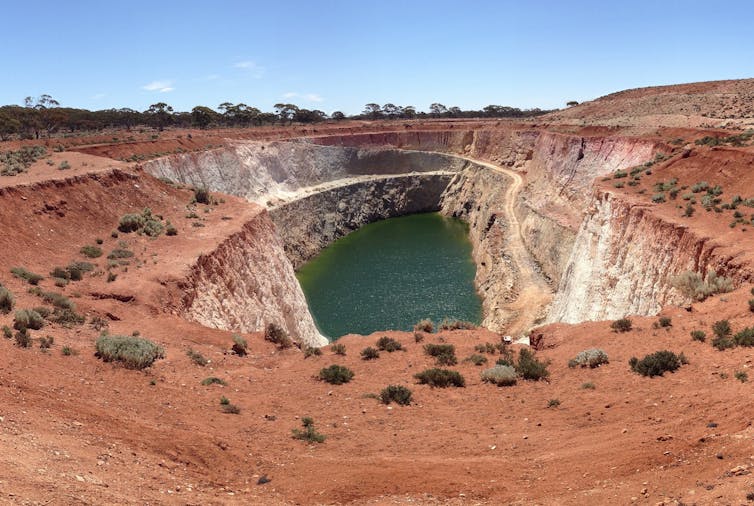
Newly announced closures of Glencore’s copper and zinc mines in Mt Isa will add to a huge number of former mines in Australia. A 2020 study by Monash University’s Resources Trinity Group found more than 80,000 inactive mine sites across the country.
Globally, a 2023 study estimates the mining footprint at around 66,000 square kilometres. Abandoned mines account for much of this area.
It’s estimated the US has about 500,000 abandoned mines and Canada at least 10,000. The UK and China have at least 1,500 and 12,000 old coalmines, respectively.
Abandoned mines can pose extreme environmental, health and safety risks. Unreclaimed coalmines, for example, continue to emit greenhouse gases.
Land is a scarce resource. Restoration enables sustainable and dynamic use of former mining land. It opens up golden opportunities – environmental, social and economic.
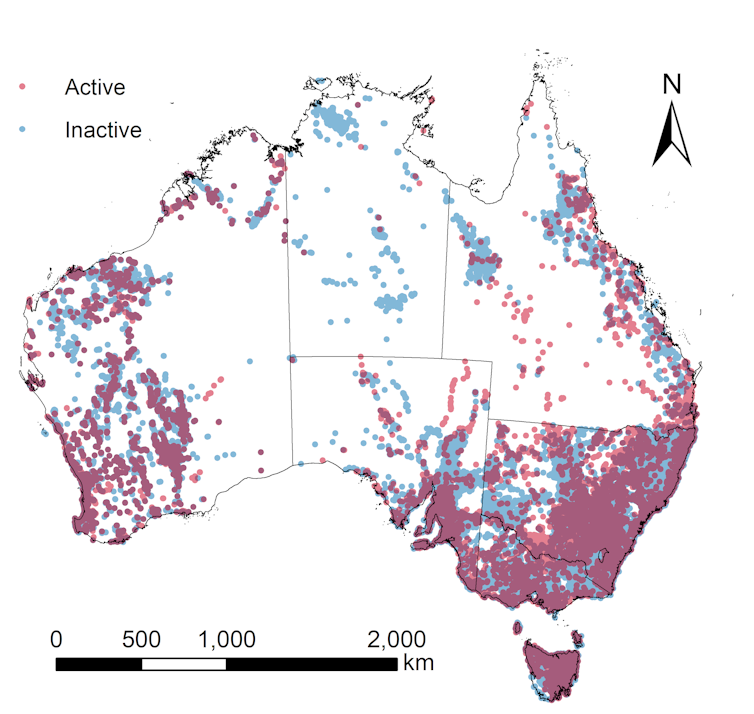
Environmental Benefits
Carbon farming
Mine leases generally lock up vast land areas. This land presents a commercially viable, yet neglected, opportunity for carbon farming.
For example, replanting abandoned leases could earn carbon credits under the Australian government’s Carbon Farming Initiative. It can help “hard to abate” industries such as mining move towards net zero emissions.
Sustainable and renewable energy
Abandoned mines can also be used to produce and store renewable energy. Examples range from providing sites for solar farms to Green Gravity’s energy storage technology.
Green Gravity uses a system of weights in a mine shaft to store energy from renewable sources. This energy is used to raise the weights. The energy can later be released when the weights are lowered under the pull of gravity.
Another example is the former Kidston gold mine’s pumped storage hydro project. This system uses two water reservoirs in former open pits. Renewable energy is used to pump water into the higher reservoir. Releasing this water into the lower reservoir generates hydropower energy as needed.
For abandoned deeper mines, tapping into geothermal energy could even make it viable to resume mining.
Water security
Abandoned mines or quarry pits can store large amounts of drinking, harvested and recycled water. This will help increase water security, especially when located near urban areas or industry corridors.
Disaster prevention
Another option is renaturalisation. This depends heavily, though, on location and mine type.
For example, Indonesia has plans to restore forest on former mine sites to help reduce floods. These reforested areas will help retain floodwaters.
Biodiversity restoration
Nature-based approaches to mine rehabilitation include reforestation and phytoremediation, which uses plants to clean up contaminated environments. These approaches tackle mines’ legacy of pollution and add ecological value.
Restored land allows for native species to be reintroduced. It can also provide bridges between patches of habitat to enhance biodiversity. In Victoria, this has been done with a former quarry at Royal Botanic Gardens Cranbourne.

Social Benefits
Improving urban liveability
Renaturalised mines can be valuable communal and green spaces. Particularly when done in urban areas, it can provide residents with better air quality, microclimates and quality of life as these sites support recreational and cultural activities. All Nations Park is another example of a quarry restoration just seven kilometres from the Melbourne CBD.
Education and tourism opportunities
Restored mining land opens up educational, architectural and tourism opportunities. These range from hotels such as the InterContinental Shanghai Wonderland – most of it is underground – to eco-tourism and education centres, such as the Eden Project in the UK.
Economic Benefits
Critical minerals
Critical minerals are vital for batteries, electric vehicles and electrification needs. These minerals can be extracted from inactive mines and tailings storages.
Mine waste processing could contribute billions of dollars a year to the economy and support regional jobs.
Job creation
Several large regions in Australia, including the Pilbara and Bowen Basins, face similar rehabilitation challenges. But each company is responsible for its own mine closure and rehabilitation. Current mining business models are not well suited for rehabilitation.
However, the scale of the rehabilitation work required in a major mining region would support an entire regional industry. It could provide many local jobs after mines close.
There are synergies between the many uses of restored mine sites. For example, Royal Botanic Gardens Cranbourne not only restores biodiversity, but has also created an attractive space for people to gather, along with jobs and education opportunities.
So What Are The Obstacles?
A mine’s rehabilitation costs may total hundreds of millions of dollars. These costs are often many times greater than what governments hold in rehabilitation bonds, which operators must provide as financial security before mining begins. Nevertheless, the financial and environmental consequences of inaction dwarf such costs.
Globally, the costs of mine rehabilitation and closure liabilities run into billions of dollars. However, investments in green infrastructure have reached trillions of dollars. Some of these funds could be directed into rehabilitation and clean-up efforts, with the benefits of:
- providing capital to “kick off” and refine the collaborative work needed to deliver multiple benefits – as well as mining companies, this work involves many other organisations and individuals
- creating clear financial accountability for rehabilitation
- generating business opportunities and sites for testing new sustainability practices and developing “gold standards” for restoring and repurposing mine sites.
A co-operative investment approach enables all partners to understand their shared responsibilities before any long-term expenses affect them individually.
Strong governance, initial funding and collaborative development are needed to achieve environmental, social and economic outcomes that add value to mine rehabilitation.
Acknowledgements: David Whittle, Alec Miller, Tim T. Werner and a number of Monash University staff and students over the years who have contributed to the research base.![]()
Mohan Yellishetty, Co-Founder, Critical Minerals Consortium, and Associate Professor, Department of Civil Engineering, Monash University and Peter Marcus Bach, Senior Research Scientist, Eastern Switzerland University of Applied Sciences, and Adjunct Research Fellow, Monash University
This article is republished from The Conversation under a Creative Commons license. Read the original article.
How Australian companies can fudge their numbers to show social and environmental progress

What’s the easiest way to improve a company’s social and environmental performance? The unfortunate answer, from our analysis of Australian public companies, is to change the way you measure it. In particular, by changing what you said last year to make this year’s performance look better.
Reporting on environmental, social and governance (ESG) performance is increasingly important to the fortunes of listed companies – under pressure from investors, regulators and other stakeholders.
In some cases, executive pay is tied to these metrics.
Our study, which examined reports from the top 500 companies listed on the Australian Securities Exchange (ASX) over the past 15 years, suggests progress can be little more than sleight of hand, facilitated by the lack of clarity around how ESG performance is measured and reported.
Our final data set includes those companies that report on both their ESG performance and their executive remuneration practices. This numbered about 215 individual companies.
Of these, roughly one in six made adjustments to past reported ESG performance, particularly around social measures such as gender diversity or workplace safety. The average size of the adjustments was also significant, at 28% of the original value reported.
About 55% of companies tied a proportion of their chief executive’s bonus to ESG metrics. These companies were twice as likely to make one or more adjustments to past reported ESG numbers. In fact, 33.5% of all adjustments were of an ESG measure that was included in the chief executive’s bonus. The average size of these adjustments was also larger, at 36% of the original value.
This occurred across all industries but was most common in two areas: the financial sector and the materials sector, which covers mining and chemical, construction and forest products.
Linking Executive Pay To Improvements
If retrospective changes were the result of previous mistakes or improvements in measurement systems, there should be no bias in the direction of changes to past performance (that is, it could go up or down). But we found a significant bias towards making past performance look worse, thereby making the current year’s look better.
Fuelling this seems to be the practice of tying executive bonuses to a simple improvement, rather than to a stipulated target. For example, executives might be rewarded for increasing the proportion of female or Indigenous employees or cutting injury rates, rather than hitting specific targets for these metrics.
We found about 17% of bonus pay is typically attributed to ESG targets. For the average chief executive in our study, this translates to around $200,000 in extra income. It’s not surprising that retrospective changes making current-year performance seem better were more likely to occur when greater weighting was given to these targets in the chief executive’s contract.
The Case Of Commonwealth Bank
The restatement of ESG measures is illustrated by the case of the Commonwealth Bank of Australia, which has been criticised for vague performance targets.
Over the past few years it has tied about 10-15% of the chief executive’s bonus to relatively intangible metrics. In its 2020 report, for example, “people measures” covering “culture, wellbeing, talent and capability” comprised 9% of the chief executive’s bonus.
Thees metrics have persistently changed retrospectively, as shown by employees’ “safety and wellbeing” results.
For example, the bank’s 2017 annual report showed 1.1 injuries per million hours worked (this is a standard measure, known as the “lost time injury frequency rate”).
However, in its 2018 annual report, the bank revised the 2017 figure from 1.1 to 1.6, which meant the 2018 report showed injury rates as having decreased relative to the previous year.
The stated reason for the change was that the updated 2017 figure includes injury claims received after the year-end reporting date, as well as expanding the scope to include New Zealand employees when calculating this metric.
In its 2019 annual report, the 2018 figure was then revised up from 1.1 to 1.4. This meant the report showed no increase in injury rates for 2019.
In its 2020 report, the 2019 figure was revised upward to 1.6. If we compare the final adjusted figures for 2019 and 2018, there was actually an increase in rates between the two years.
This practice is persistent up to the 2023 reporting period, and it’s likely legitimate that some injury claims are indeed filed after the year-end reporting date. However, if this is the case, we might wonder why an incomplete number from a current report is being compared with a complete one from a previous report.
In response to queries from The Conversation, a spokesperson for Commonwealth Bank confirmed this is indeed how these figures are collated, but denied that there is pressure to compile the data in a way that gives the impression of constant improvement.
Of course, safety and wellbeing are important issues, but the discretionary nature of these metrics means retrospective changes can make it look like improvements have occurred. Therefore, we advise users of this information to exercise caution when comparing performance to adjusted numbers, particularly as little information is typically given to explain why the adjustment was made.
For example, Commonwealth Bank’s 2023 annual report features a change to the way full-time equivalents are calculated, but without explaining how or why the previous years’ figures were adjusted.
Manipulating Vs Managing
As per the adage “what gets measured gets managed”, governments and investors have pushed sustainability reporting on the basis it will encourage companies to be socially and environmentally responsible.
This is partly due to a shift away from the view that companies exist purely to maximise shareholders’ wealth, and towards the idea they should be good corporate citizens with minimal negative impact on the environment and society. Some investors prefer to invest only in stocks that meet ESG performance criteria.
This creates incentives to exaggerate claims – made easier by the lack of uniformity in measuring and reporting such results.
Who Sets The Standard?
An international body to set global standards, the International Sustainability Standards Board, was established in 2021. It published its first set of ESG standards in June.
Australia is set to follow these standards, under a proposal by Treasury, with one catch: the regulations will focus only on climate-related disclosures, which will apply to Australian companies from 2024, overseen by the Australian Accounting Standards Board.
While these standards will create greater consistency in ESG disclosures, there will remain significant discretion in how ESG performance is measured – including the ability to change how ESG items are measured from year to year and to adjust previous years’ apparent performance.
Currently, ESG performance isn’t required to be audited, and just 22% of the companies we looked at had their ESG performance audited. Last month, the International Auditing and Assurance Standards Board issued a draft sustainability assurance standard that will require auditors to provide assurance of reported ESG figures.
Treasury has also said Australia will follow this standard, and expects auditors to provide reasonable assurance on all climate disclosures by 2027. Hopefully, these audits will also consider the legitimacy of revisions or changes in measurement. But regardless of this improvement in accountability regarding environmental performance, companies’ reporting on social metrics will still be unregulated.
The irony is striking. What was conceived as a mechanism to drive positive environmental and social change may instead act as an incentive to manipulate sustainability performance.![]()
Helen Spiropoulos, Associate Professor, University of Technology Sydney and Rebecca L. Bachmann, Lecturer in Accounting, Macquarie University
This article is republished from The Conversation under a Creative Commons license. Read the original article.
Pushing water uphill: Snowy 2.0 was a bad idea from the start. Let’s not make the same mistake again

Last night ABC’s Four Corners investigated the problem-plagued Snowy 2.0 pumped hydro power station, focusing on a bogged tunnelling machine, toxic gas and an unexpected volume of sludge.
While these specific problems are new, we have criticised this project since 2019 and outlined six key problems even earlier elsewhere.

How Did We Get Here?
In March 2017, then-Prime Minister Malcolm Turnbull announced the project, lauding it as a game changer for our clean-energy revolution.
In his memoir, Turnbull dubbed Snowy 2.0 “the single most important and enduring decision of the many I made on energy”.
Alas, Snowy 2.0 has not gone well. The warning signs were there from the start. Both the government-appointed Snowy Hydro Board and federal government were warned they had greatly under-costed it, underestimated the construction time and failed to recognise the damage it would do to the Kosciuszko National Park.
In August this year, the government bumped up funding for Snowy 2.0 to A$12 billion – triple the October 2018 figure, when the final decision was made to go ahead, and six times what Turnbull first claimed it would cost in March 2017. That’s before counting the new transmission lines through the controversial HumeLink and VNI West transmission projects. When complete, Snowy 2.0 plus transmission could cost upwards of $20 billion – over ten times the figure Turnbull claimed.
Energy minister Chris Bowen put the Snowy failures and blowouts down to poor execution. Was it still worthwhile? Yes, he said. But Bowen also admits to being swayed by the sunk cost – the government has already spent over $4 billion on it.
Snowy Hydro’s new CEO Dennis Barnes has claimed that while costs have blown out, the public benefits have increased as well.
To date, nothing has been released to substantiate claims of extra benefit despite requests by journalists and by the Senate. All that has been released is a one-page press release and a highly redacted report.
What Are The Lessons Here?
Pumped hydro is essentially a hydroelectricity plant with the ability to pump water back up to the top reservoir. You use cheap power to pump it uphill, and run water back down through turbines to generate power as needed.
The technology isn’t new. It had a previous burst of popularity in developed nations in the 1970s. But since then, there’s been very little pumped hydro built except in China.
Since the 1970s, Australia has had three pumped-hydro generators supplying the National Electricity Market, two in New South Wales and one in Queensland. Data on their generation shows they have only a minor role in energy storage.
None of these are comparable to Snowy 2.0, which would be vastly bigger than any we’ve built before. Snowy 2.0 has by far the longest tunnels – 27 kilometres – of any pumped-hydro station ever built.
Even our smaller pumped-hydro projects are proving harder to complete than expected. The depleted Kidston gold mine in Queensland is being converted to a 250 megawatt pumped-hydro station. The project is much simpler and smaller than Snowy 2.0 and has had extensive policy and financial support by federal and state governments. But it too is running over budget and late, although not remotely close to the same extent as Snowy 2.0.
These projects present hard and expensive engineering problems. They do not deliver economies from learning because each is different from the other.
By contrast, chemical batteries are increasingly standardised. They’re attracting huge investment in research and production. They improve the capacity of existing transmission. They’re made in factories so become cheaper as the industry scales, they have much lower capital outlays per unit of storage, so you get a much quicker payback. And you can resell them easily.
How Did We Make Such An Expensive Mistake?
One simple explanation is that it was a political decision. The original Snowy Hydro scheme is famed as a nation-building project in post-war Australia. Snowy 2.0 was framed in the same way. Then there’s the need to be seen to “do something”, with economic and technical merit a distant third place.
But there’s another factor – a failure to acknowledge the pace of technology change in ever-better solar panels and wind turbines as well as in battery storage. Apparently insurmountable problems are being solved quickly, such as rapid manufacturing and installation of solar panels, the ability to harness low quality winds, and producing batteries able to service different markets at different points in the grid.
Given the pace of change, it would seem sensible to make the most of cheaper solutions which can be built quickly and don’t lock us in or out to technologies for the long term.
In practice, that means we should focus first on Australia’s huge potential for solar on warehouse and factory rooftops close to our cities. It’s easy to store rooftop solar surpluses for local use. We should make the most of the enormous local potential before reaching for complex, risky, expensive and distant alternatives.
By analogy, don’t try to summit the mountain before climbing its foothills. From base camp, we are bound to find the mountain looks quite different to how we imagined it from a great distance.
Energy expert Ted Woodley contributed to this article.![]()
Bruce Mountain, Director, Victoria Energy Policy Centre, Victoria University
This article is republished from The Conversation under a Creative Commons license. Read the original article.
Increasing melting of West Antarctic ice shelves may be unavoidable – new research

The rate at which the warming Southern Ocean melts the West Antarctic ice sheet will speed up rapidly over the course of this century, regardless of how much emissions fall in coming decades, our new research suggests. This ocean-driven melting is expected to increase sea-level rise, with consequences for coastal communities around the world.
The Antarctic ice sheet, the world’s largest volume of land-based ice, is a system of interconnected glaciers comprised of snowfall that remains year-round. Coastal ice shelves are the floating edges of this ice sheet which stabilise the glaciers behind them. The ocean melts these ice shelves from below, and if melting increases and an ice shelf thins, the speed at which these glaciers discharge fresh water into the ocean increases too and sea levels rise.
In West Antarctica, particularly the Amundsen Sea, this process has been underway for decades. Ice shelves are thinning, glaciers are flowing faster towards the ocean and the ice sheet is shrinking. While ocean temperature measurements in this region are limited, modelling suggests it may have warmed as a result of climate change.
We chose to model the Amundsen Sea because it is the most vulnerable sector of the ice sheet. We used a regional ocean model to find out how ice-shelf melting will change here between now and 2100. How much melting can be prevented by reducing carbon emissions and slowing the rate of climate change – and how much is now unavoidable, no matter what we do?
Rapid Change Is Locked In
We used the UK’s national supercomputer ARCHER2 to run many different simulations of the 21st century, totalling over 4,000 years of ocean warming and ice-shelf melting in the Amundsen Sea.
We considered different trajectories for fossil fuel burning, from the best-case scenario where global warming is limited to 1.5°C in line with the Paris Agreement, to the worst, in which coal, oil and gas use is uncontrolled. We also considered the influence of natural variations in the climate, such as the timing of events such as El Niño.
The results are worrying. In all simulations there is a rapid increase over the course of this century in the rate of ocean warming and ice-shelf melting. Even the best-case scenario in which warming halts at 1.5°C, something that is considered ambitious by many experts, entails a threefold increase in the historical rate of warming and melting.
What’s more, there is little to no difference between the scenarios up to 2045. Ocean warming and ice-shelf melting in the 1.5°C scenario is statistically the same as in a mid-range scenario, which is closer to what existing pledges to reduce fossil fuel use over the coming decades would produce.
The worst-case scenario shows more melting than the others, but only from around mid-century onwards, and many experts think this amount of future fossil fuel burning is unrealistic anyway.
The results imply that we are now committed to rapid ocean warming in the Amundsen Sea until at least 2100, regardless of international policies on fossil fuels.
The increases in warming and melting are the result of ocean currents strengthening and driving more warm water from the deep ocean towards the shallower ice shelves along the coast. Other studies have suggested this process is behind the ice shelf thinning measured by satellites.
How Much Will The Sea Level Rise?
Melting ice shelves are a major cause of sea-level rise, but not the whole story. We can’t put a number on how much sea levels will rise without also simulating the flow of Antarctic glaciers and the rate of snow accumulating on the ice sheet, which our model didn’t include.
But we have every reason to believe that increased ice-shelf melting in this region will cause the rate at which sea levels are rising to speed up.
The West Antarctic ice sheet is already contributing substantially to global sea-level rise and is losing about 80 billion tonnes of ice a year. It contains enough ice to cause up to 5 metres of sea-level rise, but we don’t know how much of it will melt, and how quickly. Our colleagues around the world are working hard to answer this question.
Courage And Hope
There are some consequences of climate change that can no longer be avoided, no matter how much fossil fuel use falls. Substantial melting of West Antarctica up to 2100 may now be one of them.
How do you tell a bad news story? The conventional wisdom is that you’re supposed to give people hope: to say that there’s a disaster behind one door, but we can avoid it if only we choose a different one. What do you do when your science tells you that all doors lead to the same disaster?
Kate Marvel, an atmospheric scientist, said that when it comes to climate change, “we need courage, not hope … Courage is the resolve to do well without the assurance of a happy ending”. In this case, courage means shifting our attention to the longer term.
The future will not end in 2100, even if most people reading this will no longer be around. Our simulations of the 1.5°C scenario show ice-shelf melting starting to plateau by the end of the century, suggesting that further changes in the 22nd century and beyond may still be preventable. Reducing sea-level rise after 2100, or even slowing it down, could save many coastal cities.
Courage means accepting the need to adapt, protecting coastal communities where it’s possible to do so, and rebuilding or abandoning them where it’s not. By predicting future sea-level rise in advance, we’ll have time to plan for it – rather than wait until the ocean is on our doorstep.

Don’t have time to read about climate change as much as you’d like?
Get a weekly roundup in your inbox instead. Every Wednesday, The Conversation’s environment editor writes Imagine, a short email that goes a little deeper into just one climate issue. Join the 20,000+ readers who’ve subscribed so far.![]()
Kaitlin Naughten, Ocean-Ice Modeller, British Antarctic Survey; Jan De Rydt, Associate Professor of Polar Glaciology and Oceanography, Northumbria University, Newcastle, and Paul Holland, Ocean and Ice Scientist, British Antarctic Survey
This article is republished from The Conversation under a Creative Commons license. Read the original article.
How to beat ‘rollout rage’: the environment-versus-climate battle dividing regional Australia
Peter Burnett, Australian National UniversityThis article is part of a series by The Conversation, Getting to Zero, examining Australia’s energy transition.
In August, Victoria’s Planning Minister Sonya Kilkenny made a decision that could set a difficult precedent for Australia’s effort to get to net-zero emissions by 2050.
In considering the environmental effects of the proposed $1 billion Willatook wind farm 20km north of Port Fairy in southwest Victoria, the minister ruled that the developers, Wind Prospect, had to build wider buffers around the wind turbines and observe a five-month ban on work at the site over each of the two years of construction.
Her reason? To protect the wetlands and breeding season of the brolga, a native crane and a threatened species, and the habitat of the critically endangered southern bent-wing bat.
The decision shocked many clean energy developers. Wind Prospect’s managing director Ben Purcell said the conditions imposed by the minister would reduce the planned number of 59 turbines by two-thirds and make the project “totally unworkable”.
Kilkenny acknowledged that her assessment might reduce the project’s energy output. However, she said “while the transition to renewable energy generation is an important policy and legislative priority for Victoria”, so was “protection of declining biodiversity values”.
The military uses the term “blue on blue” for casualties from friendly fire. In the environmental arena we now risk “green on green” losses, and agonising dilemmas as governments try to reconcile their responses to the world’s two biggest environmental problems: climate change and biodiversity loss.
The Green Vs Green Dilemma
The goal of achieving net zero by 2050 requires nothing less than an economic and social transformation. That includes extensive construction of wind and solar farms, transmission lines, pumped hydro, critical mineral mines and more.
Australia needs to move fast – the Australian Energy Market Operator says 10,000km of high-voltage transmission lines need to be built to support the clean energy transition – but we are already lagging badly.
The problem is that moving fast inflames what is often fierce opposition from local communities. They are especially concerned with the environmental impacts of vast electricity towers and lines running across land they love.
In southern New South Wales, organised groups are fighting to stop the construction of a huge infrastructure project, HumeLink, that seeks to build 360km of transmission lines to connect Snowy Hydro 2.0 and other renewable energy projects to the electricity grid.
Locals say the cities will get the power, while they pay the price. “No one should minimise the consequences of ‘industrialising’ Australia’s iconic locations – would we build power lines above Bondi Beach?” the Snowy Valleys Council asked in a submission to a parliamentary inquiry.
Clean energy developers are caught in a perfect storm, at loggerheads with environmentalists and landholders alike over environmental conditions, proper consultation and compensation, while grappling with long regulatory delays and supply chain blockages for their materials.
They see a system that provides environmental approval on paper but seemingly unworkable conditions and intolerable delays in practice. Does the bureaucracy’s left hand, they wonder, know what its right hand is doing?
Net zero, nature protection and “rollout rage” feel like a toxic mix. Yet we have to find a quick way to deliver the clean energy projects we urgently need.
What Is To Be Done?
The major solution to climate change is to electrify everything, using 100% renewable energy. That means lots of climate-friendly infrastructure.
The major regulatory solution to ongoing biodiversity loss is to stop running down species and ecosystems so deeply that they cannot recover. Among other things, that means protecting sensitive areas, which are sometimes the same areas that need to be cleared, or at least impinged upon, to build new infrastructure.
To get agreement, we need a better way than the standard project-based approval processes and private negotiations between developers and landowners. The underlying principle must be that all citizens, not just directly affected groups, bear the burden of advancing the common good.
As tough as these problems look, elements of a potential solution, at least in outline, are on the table.
These elements are: good environmental information, regional environmental planning and meaningful public participation. The government’s Nature Positive Plan for stronger environmental laws promises all three.
The Albanese Government’s Plan
Australia lags badly in gathering and assembling essential environmental information. Without it, we are flying blind. The government has established Environment Information Australia “to provide an authoritative source of high-quality environmental information.” Although extremely belated, it’s a start.
The Nature Positive Plan may also improve the second element – regional planning – by helping it deal with “green on green” disputes through its proposed “traffic light” system of environmental values.
Places with the highest environmental values (or significant Indigenous and other heritage values) would be placed in “red zones” and be protected from development, climate-friendly or not.
Development would be planned in orange and green zones, but require biodiversity offsets in orange zones.
The catch is that most current biodiversity offsets, which commonly involve putting land into reserve to compensate for land cleared, are environmental failures.
The government has promised to tighten these rules, but advocates ranging from former senior public servant Ken Henry to the Australian Conservation Foundation are pushing for more. A strict approach would make offsets expensive and sometimes impossible to find, but that is the price of becoming nature-positive.
The Need For Regional Planning
Good regional planning – based, say, on Australia’s 54 natural resource management regions – would deal with a bundle of issues upfront. That approach would avoid the environmental “deaths of a thousand cuts” that occur when developments are approved one by one.
But regional planning will only succeed if federal and state governments allocate significant resources and work together. Australia’s record on such cooperation is a sorry one. Again, Environment Minister Tanya Plibersek is attempting a belated fresh start, but this will be a particularly rocky road.
The third element – meaningful public participation – involves restoring trust in the system. This requires transparency, proper consultation, and the public’s right to challenge decisions in the courts.
Meaningful consultation requires time, expertise, and properly funded expert bodies that can build a culture of continuous improvement. Again, Australia’s record to date has been piecemeal and poor.
These reforms – better information, planning and public participation – will take time. In the meantime, the precautionary principle suggests a three-pronged approach to keeping us on track for net zero.
One, work proactively with developers to find infrastructure sites that avoid environmentally sensitive areas.
Two, speed up regulatory approvals. Fund well-resourced taskforces for both, as the gains will vastly outweigh the costs.
Three, be generous in compensating landowners where development is approved. Fairness comes at a cost, but unfairness will create an even higher one.
All this makes for a political sandwich of a certain kind. Why would government even consider it?
The answer lays bare the hard choice underlying modern environmental policy. We can accept some pain now, or a lot more later. The prize, though, is priceless: a clean energy system for a stable climate, and a natural environment worth passing on to future generations.![]()
Peter Burnett, Honorary Associate Professor, ANU College of Law, Australian National University
This article is republished from The Conversation under a Creative Commons license. Read the original article.
Himalayan communities are under siege from landslides – and climate change is worsening the crisis
Ashutosh Kumar, Indian Institute of Technology Mandi; Eedy Sana, Indian Institute of Technology Mandi, and Ellen Beatrice Robson, Durham UniversityThree-quarters of annual rain in the Himalayas arrives in the monsoon season from June to September. Within this rainy period are sudden and extremely intense cloudbursts, which often “pop” over a relatively small area (akin to a cloud bursting open like a balloon).
As climate change is making these cloudbursts and other forms of heavy rainfall more intense and more frequent in the Himalayan foothills, the hilly slopes are becoming saturated more frequently, and thus unstable. Rainfall-triggered landslides are already happening extensively across the Himalayas, and things are likely to get worse.
From July to August 2023, the Indian Himalayas, particularly the state of Himachal Pradesh in the northern part of the country, experienced an unprecedented number of cloudbursts which triggered thousands of devastating landslides. The state’s disaster management authority reported that by the end of August, heavy rain and rainfall-triggered landslides had caused 509 fatalities, destroyed at least 2,200 homes and damaged a further 10,000. It is estimated that Himachal Pradesh’s losses from this period amount to US$1.2 billion. Much of the destruction took place during two short periods, one in mid-July and one in mid-August.
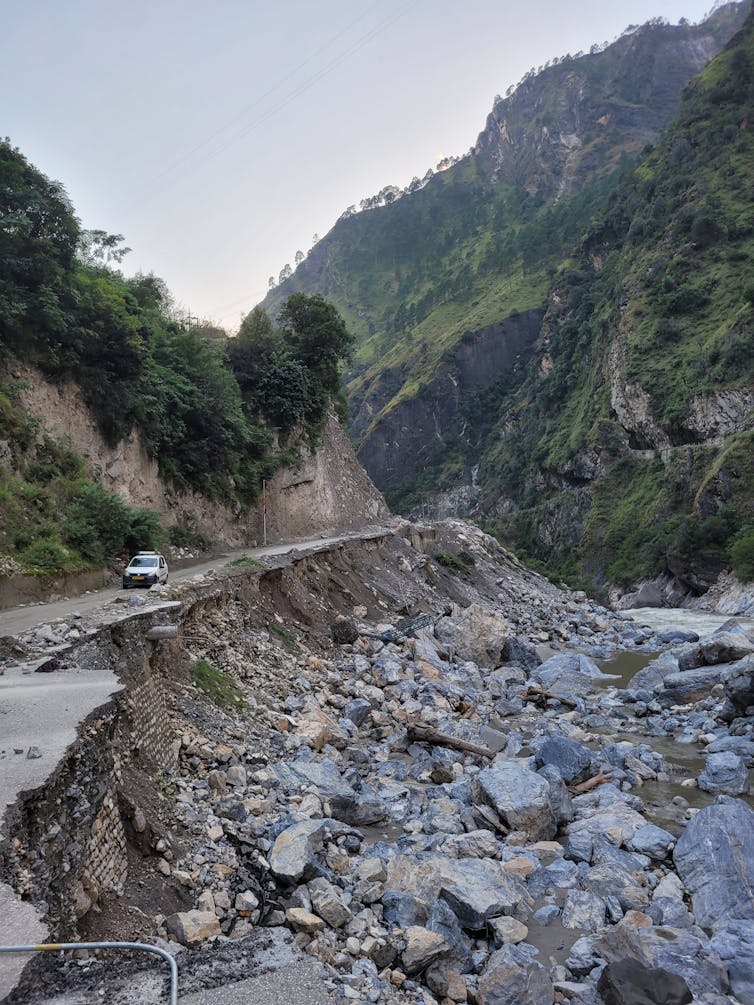
The level of damage to buildings, roads and bridges is extremely difficult to comprehend. Several sections of national and state roads have been washed away, a temple in Shimla collapsed and killed 20 people, rural dwellings largely constructed on sloped ground were washed away by rain, and houses are still sliding downhill.
Schools and hospitals have been damaged, posing an ongoing threat to lives. A school in Kullu district was closed for 52 days because the bridge which connected it to a town had been washed away. Local people have had no option but to live in tents with minimal facilities. They are hugely concerned about their safety ahead of a cold and snowy winter.
Four days of heavy rainfall in July 2023 triggered landslides that blocked around 1,300 roads including five national highways, leaving the state almost cut off from the rest of India. This had huge knock-on effects as 1,255 bus routes were suspended, 576 buses were stranded, more than 70,000 tourists had to be evacuated, and people could not access key facilities and services. This impeded emergency responders, causing critical delays in search and rescue operations as well as delivery of aid.
Across the whole of India, the summer monsoon and its related cloudbursts are decreasing. But in the Himalayan foothills, they are increasing significantly – partly because when warm moist air encounters the Himalayan barrier it rapidly lifts and cools, forming large clouds that then dump their rain. With intense rain happening more and more often in the Himalayan foothills, it is likely that 2023’s summer of disasters will occur again.
Unnecessarily Vulnerable
Although climate change may be to blame for the rise in cloudbursts, in an ideal world rainfall alone needn’t lead to disastrous landslides. But the Himalayas have been made more vulnerable by human actions.
The region has largely been deforested, removing tree roots which reinforce the ground and form a crucial barrier that stops soils washing away. And unplanned developments and haphazard construction have destabilised already fragile slopes.
Initial reports on this year’s landslides suggest the worst damages occurred along artificially cut slopes (for roads or buildings), where there has been a lack of proper provisioning for drainage and slope safety. In both India and Nepal, many of the hill roads have been haphazardly constructed, which makes landslides during rainfall more likely. Construction guidelines and building codes are outdated and have been ignored anyway, and there is little assessment of the link between urbanisation and landslide risk.
One obvious solution is to prevent rain from penetrating the ground, so the slopes avoid losing any strength. However, if the soil is entirely prevented from absorbing any rain, the water will instead run off the surface and cause greater flooding problems further downhill.
One engineering solution is to place an artificial soil layer above the natural soil to temporarily hold water in the surface when it is raining extremely hard, preventing it penetrating deeper within the slope. This “climate adaptive barrier layer” will then release water back to the atmosphere during a later drying period.
As the heavy rain intensifies, it will be hugely important for the Himalayas to implement new user-friendly and reliable construction guidelines that factor in how the climate is changing. Landslides can’t be avoided entirely, and India certainly won’t be able to reverse global warming and the increase in cloudbursts any time soon. But these preventive actions should at least make communities more resilient to the changing climate.

Don’t have time to read about climate change as much as you’d like?
Get a weekly roundup in your inbox instead. Every Wednesday, The Conversation’s environment editor writes Imagine, a short email that goes a little deeper into just one climate issue. Join the 20,000+ readers who’ve subscribed so far.![]()
Ashutosh Kumar, Assistant Professor, School of Civil & Environmental Engineering, Indian Institute of Technology Mandi; Eedy Sana, PhD Candidate, Geotechnical Engineering, Indian Institute of Technology Mandi, and Ellen Beatrice Robson, Postdoctoral research associate, Durham University
This article is republished from The Conversation under a Creative Commons license. Read the original article.
Remember the climate map from your school atlas? Here’s what climate change is doing to it

You probably saw a multi-coloured climate map at least once in school. You might have pored over it, fascinated. Was Antarctica really a cold desert? And why was so much of Russia listed as tundra?
Almost always, those maps were based on the climate classification system proposed by Wladimir Köppen. The colours are chosen to suit our imagination: Australia with its red desert centre, surrounded by a yellow or orange semi-arid fringe and more lush green climates along many coastlines and hinterland.
But these maps were made for a climate that doesn’t exist any more. Our new research shows just how fast climate change has altered these maps – and how they will continue to change.
Our web app lets you see for yourself for any country in the world and for different emission scenarios. For Australia, you can watch the hot desert area expand and the temperate areas shrink.
The climate map of the future below assumes nations meet their climate goals. It could be far worse. Or it could be better, if we finally treat climate change with the urgency it needs.

How Do You Classify A Climate?
Köppen was a 19th century Russian botanist who later retrained in meteorology. Over his career, he combined both interests, becoming fascinated by the relationship between climate and types of vegetation.
Around 1900, he proposed the influential climate classification system which now bears his name alongside his collaborator, Rudolf Geiger. It remains by far the most used classification system, as it combines different aspects of climate data into types of landscapes and vegetation types we can actually picture, from rainforests, savannahs and deserts to temperate and boreal forests, tundras, glaciers and ice sheets.
The Köppen-Geiger classification has five major climate classes: tropical, dry, temperate, cold and polar. These are divided into 30 subclasses based on the amount of rain and temperatures in summer and winter.
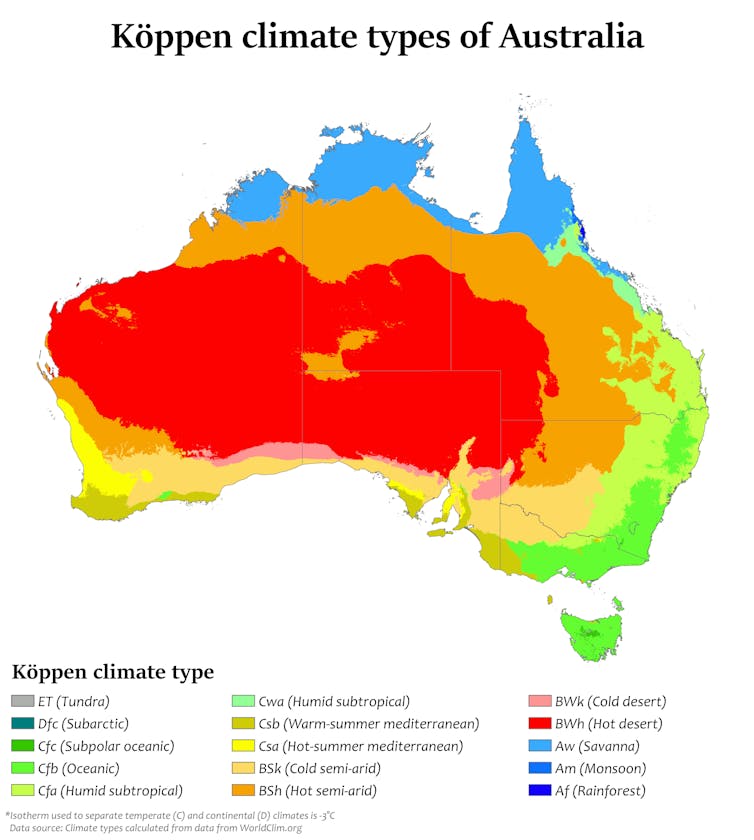
You might think it would be relatively straightforward to figure out if climate change has pushed a region into a new classification. Add the recorded global warming of 1.2°C so far and see if that changes anything.
Alas, it’s not that simple. This is because climate change can have weird regional effects. We’re getting much more rain in some areas, and much less in others. Some regions are warming faster than the global average and others are warming slower.
Climate models predict there will continue to be such differences. Plus, a degree of warming will have a greater impact at the edge of a glacier than in the Sahara.
To find out what will happen, we analysed vast databases of past weather observations and future climate projections under different socio-economic and emission pathways to redraw the Köppen map. We did so at a very fine scale, dividing the world up into square kilometres so we could observe localised changes in mountainous regions and on small islands.
Change Has Already Happened – And There’s Much More To Come
The results were surprising. In some parts of the world, climate zones have already shifted considerably since Köppen drew his first climate map more than a century ago. The fastest change has been in the last few decades. The largest changes have been in cold and polar climates, which have become less cold and sometimes drier.
Eastern Europe has been a climate change hotspot over the last century. Its continental climate of cold winters and warm summers has given way to a temperate climate with hot summers.
Several countries have already changed climate zones across more than half of their area. Hungary, for instance, has changed the most of any nation. A whopping 81% of the country has already moved into a different, more temperate climate zone. Other global hot spots include central Europe, the Middle East and South Korea.
Our projections show these regions are among those to undergo the biggest climatic shifts through to 2100. Some areas will shift climate zones more than once.
Countries at higher latitudes will see some of the largest changes. Almost a quarter (24%) of both Canada and Russia have already moved into another climate zone since Köppen’s first map. Another 39-40% of their immense landmasses will follow suit before the end of the century.
A similar story applies to Europe, where climate zones will change in between one-third and two-thirds of the area in most countries.
South Africa and neighbouring countries Eswatini and Lesotho are the fastest changing countries in the Southern Hemisphere. Their climate zones have shifted across 28% of their combined area. By 2100, an additional 44% will change.
In Australia, climate zones have already shifted across 14% of the country, with another 13% predicted during the remainder of this century.
You might wonder how it can be that climate zones don’t move in some areas. That is because each Köppen climate zone represents a specific range of temperature and rainfall conditions, and a region can move within that range.
But Köppen didn’t foresee what’s happening now. In his classification, deserts and tropical climates are at the high end of the temperature scale and cannot change - they just get hotter.

What Will This Mean On The Ground?
Changes as dramatic and rapid as this are already upending natural ecosystems. As climate change progresses, it will force significant change to our farms and infrastructure. Humanity gets half its calories from just three plants – rice, maize and wheat – and each of these has a preferred climate.
Warmer and drier climates bring more drought as well as crop loss, water shortages, ecosystem degradation, bushfires and desertification. Warmer winters, extreme heat, drought and fire have been pummelling forests the world over - from the cold high latitudes in Canada and Russia to the dry forests in the Mediterranean region, California and Australia. Even the Amazon rainforest is affected.
Of course, some changes may be beneficial for people, such as better agricultural conditions or lower heating costs in cold regions. But the overall picture is one of calamitous change.
Over the next decades, it will take all of humanity’s commitment and ingenuity to avoid a major climate catastrophe.![]()
Albert Van Dijk, Professor, Water and Landscape Dynamics, Fenner School of Environment & Society, Australian National University; Hylke Beck, Assistant Professor, King Abdullah University of Science and Technology, and Pablo Rozas Larraondo, Research fellow, Australian National University
This article is republished from The Conversation under a Creative Commons license. Read the original article.
Beyond Juukan Gorge: how First Nations people are taking charge of clean energy projects on their land
Lily O'Neill, The University of Melbourne; Brad Riley, Australian National University; Ganur Maynard, Indigenous Knowledge, and Janet Hunt, Australian National UniversityThis article is part of a series by The Conversation, Getting to Zero, examining Australia’s energy transition.
Many of the big wind and solar farms planned to help Australia achieve net zero emissions by 2050 will be built on the lands and waters of First Nations peoples. More than half of the projects that will extract critical minerals to drive the global clean energy transition overlap with Indigenous-held lands.
Australia’s Pilbara and Kimberley regions have high rates of Indigenous land tenure, while hosting some of world’s best co-located solar and wind energy resources. Such abundance presents big opportunities for energy exports, green steel and zero carbon products.
Almost 60% of Australia is subject to some level of First Nations’ rights and interests, including exclusive possession rights (akin to freehold) over a quarter of the continent. So the stakes for all players are high.
In 2020, after news Rio Tinto had legally destroyed the sacred Juukan Gorge rock shelter in order to gain access to more than $100 million worth of iron ore, we wrote an article questioning how much legal say First Nations people would have over massive new wind and solar farms planned for their Country. We asked whether the move to a zero-carbon economy “would be a just transition for First Nations?”
The Long But Hopeful Journey Back From Juukan Gorge
Much has happened in the past three years, and while more needs to be done, some signs are promising.
First, the furore and subsequent parliamentary inquiry following the Juukan Gorge incident forced the resignation of Rio Tinto boss Jean-Sebastien Jacques. Companies were put on notice that they can no longer run roughshod over First Nations communities. Research in progress indicates the clean energy industry has heard this message.
Second, in 2021 the First Nations Clean Energy Network – a group of prominent First Nations community organisers, lawyers, engineers and financial experts – was created and began to undertake significant advocacy work with governments and industry.
The network has released several useful guides on best practice on First Peoples’ Country. Again, research indicates the clean energy industry is paying attention to the work of the network.
Third, there is a question whether the Native Title Act allows large-scale clean energy developments to go ahead without native title holders’ permission. We are increasingly convinced the only way such developments will gain approval through the Native Title Act is through an Indigenous Land Use Agreement.
Moreover, Queensland and Western Australia have both implemented policies and South Australia is developing legislation that make it clear these states will require renewable energy developers to negotiate an agreement with First Nations land holders. Because these agreements are voluntary, native title holders can refuse to allow large wind and solar farms on their Country.
As always, these decisions come with caveats. Governments can compulsorily acquire land, and many of the power imbalances we observed in our earlier article persist. These include the power corporations have – unlike most Indigenous communities – to employ independent legal and technical advice about proposed projects, and to easily access finance when a community would like to develop a project itself.
Promising Partnerships On The Road To Net Zero
Are First Nations peoples refusing to have wind and solar projects on their land? No, they are not. Many significant proposed projects announced in the last few years show huge promise in terms of First Nations ownership and control.
In Western Australia the partnership between Yindjibarndi Aboriginal Corporation and renewable energy company ACEN plans to build three gigawatts of solar and wind infrastructure on Yindjibarndi exclusive possession native title. Mirning traditional owners hold equity stakes in one of the largest green energy projects in the world, the massive Western Green Energy Hub located on their lands in the great Australian Bight.
Further north, Balanggarra traditional owners, the MG Corporation and the Kimberley Land Council have together announced a landmark East Kimberley Clean Energy project aimed at producing green hydrogen and ammonia for export.
Across the border in the Northern Territory, Larrakia Nation and the Jawoyn Association have created Desert Springs Octopus, a majority Indigenous-owned company backed by Octopus Australia.
Still, much more needs to happen to provide Indigenous communities with proper consent and control. In its 2023 amendments to allow for renewable energy projects on pastoral leases, the Western Australian government could have given native title holders more control but it chose not to. And much needed reforms to cultural heritage laws in WA were scrapped following a backlash from farmers.
In New South Wales, some clean energy developers seem to be avoiding Aboriginal lands, perhaps because they think it will be easier to negotiate with individual landholders. The result is lost opportunities for partnership, much needed know-how and mutual benefit.
In the case of critical mineral deposits on or near lands subject to First Nations’ title, not nearly enough has been done to ensure these communities will benefit from their extraction.
Why Free, Prior And Informed Consent Is Crucial
To ensure the net zero transition is just, First Nations must be guaranteed “free, prior and informed consent” to any renewable energy or critical mineral project proposed for their lands and waters, as the UN Declaration of the Rights of Indigenous Peoples makes clear.
So long as governments can compulsorily acquire native title to expedite a renewable energy project and miners are allowed to mine critical minerals (or any mineral) without native title holders’ consent, the net zero transition will transgress this internationally recognised right.
The Commonwealth government has agreed in principle with the recommendations of the Juukan Gorge inquiry to review native title legislation to address inequalities in the position of First Nations peoples when they are negotiating access to their lands and waters.
The meaningful participation of First Nations rights holders is critical to de-risking clean energy projects. Communities must decide the forms participation takes – full or part ownership, leasing and so on – after they have properly assessed their options. Rapid electrification through wind and solar developments cannot come at the expense of land clearing and loss of biodiversity.
Ongoing research highlights that when negotiating land access for these projects, First Nations people are putting protection of the environment first when negotiating the footprint of these developments. That’s good news for all Australians.![]()
Lily O'Neill, Senior Research Fellow, Melbourne Climate Futures, The University of Melbourne; Brad Riley, Research Fellow, Australian National University; Ganur Maynard, Indigenous Knowledge Holder, Indigenous Knowledge, and Janet Hunt, Honorary Associate Professor, CAEPR, Australian National University
This article is republished from The Conversation under a Creative Commons license. Read the original article.
From meerkat school to whale-tail slapping and oyster smashing, how clever predators shape their world

In the 1980s a single humpback whale in the Gulf of Maine developed the “lobtail feeding method”. This unique hunting method of slapping the water’s surface appears to drive fish into dense schools, making it easier to consume them. Lobtail feeding caught on. Now many humpback whales are doing it.
Ecologists have long thought animals acted on instinct alone. But a growing body of evidence shows many animals, much like us, have complex brains and social lives.
In our new research, we argue the science of ecology can learn a great deal from the study of animal cognition and culture. Cognition is what goes on in the mind, which determines how animals perceive and respond to the world around them. Culture is the development and spread of socially learned behaviours. These are important – but generally overlooked – mechanisms influencing ecosystems.
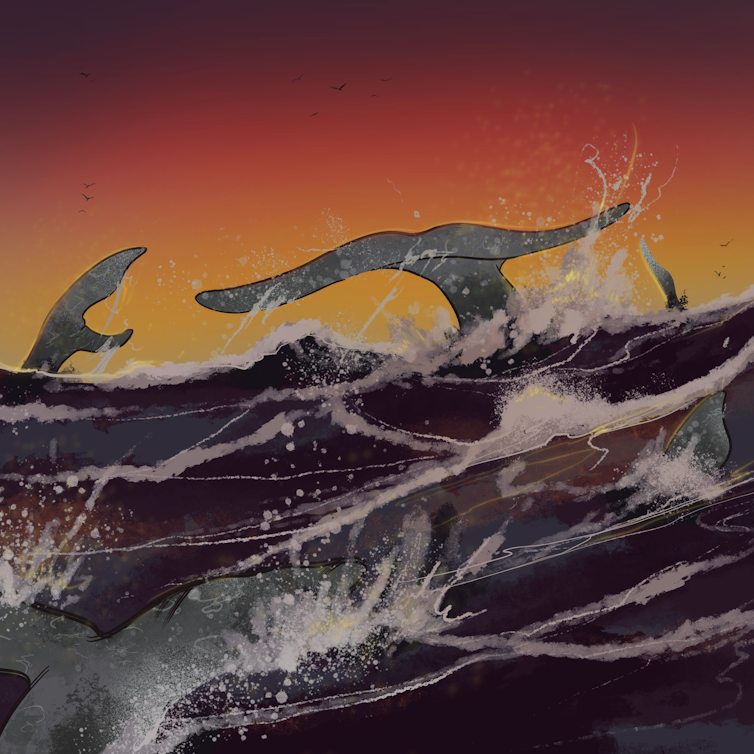
More Than Cogs In The Eco-Machine
Research shows prey are adept at learning from previous encounters with predators. They remember what predators look like, what they smell like and the locations and times they are active.
This means every time an animal encounters a predator they can gather knowledge about how to improve their chances of survival.
Predators learn as well. Meerkat pups go to meerkat “school”. Eating dangerous prey such as scorpions is challenging because scorpion toxin can be fatal. To overcome this, meerkat teach their young how to remove scorpion stingers, allowing them to safely eat them.

Animal cognition and social learning allow problems solved and lessons learned during predatory encounters to be shared with friends and family. The development of these cultural behaviours can spread across entire populations.
Shaping How Ecosystems Function
Past experience and lessons learned from friends and family inform an animal’s capacity to make complex decisions.
When wolves were reintroduced to Yellowstone National Park in 1995, elk and deer had to learn how to avoid being eaten. While initially naive, elk and deer shifted to new locations and changed the times they were active. As a result, these herbivores concentrated their foraging in specific areas, altering the variety of plants and even the physical environment.
Predator hunting cultures can also shape ecosystems. In Thailand’s Khao Sam Roi Yot National Park, long-tailed macaques use heavy rocks as stone tools to smash the shells of oysters and other shellfish open and access the food inside. Macaques can become so proficient at shellfish hunting they have driven island-wide declines.

Humans Can Erode Animal Culture
Rapid environmental changes such as urbanisation, climate change and hunting or poisoning can influence animal cognition and animal culture.
Just as trauma, such as from war, influences human cognition and culture, the targeted killing of animals can disrupt their cognition and culture. This has consequences for ecosystems.
Killing dingoes, Australia’s only mainland mammalian apex predator, disrupts their family groups. This can result in the loss of important behaviours, including pack hunting. This can then prevent dingoes from hunting prey larger than themselves, such as water buffalo and foxes and cats. In this way, the loss of pack hunting can drive changes in how ecosystems operate and highlights the importance of animal culture as a unit of nature worth conserving.
Changing Our Perceptions Of Ecology
Longstanding notions in ecology and conservation biology claim ecosystems function due to evolutionary history alone. In this view, organisms evolve traits to allow them to coexist with each other, so newly arrived species can be fundamentally disruptive. The inner lives of animals complicate this worldview.
Recognising many animals possess and act upon their awareness of time, self and others, and may even have language, invites us to reconsider ecological relationships might not be so static. Acknowledging animal cognition and culture in ecology means understanding ecological relationships are always changing and shifting.
By studying how the cognition and cultures of animals shape their ecology, we may shed light on the origins of animal intelligence and culture, their importance to life on Earth and how best to preserve non-human culture in an ever-changing world.
The research behind this article was co-authored with Dr Kaitlyn Gaynor, Dr Alexandra Carthey, Dr Arian Wallach, Dr Lauren Stanton and Dr Daniel Ramp who all substantially contributed to the ideas presented throughout.![]()
Eamonn Wooster, Postdoctoral Research Fellow, Gulbali Institute, Charles Sturt University and Erick Lundgren, Postdoctoral fellow, Aarhus University, University of Technology Sydney
This article is republished from The Conversation under a Creative Commons license. Read the original article.
Doing laundry by hand sheds just as many microfibres as machine washing – new research
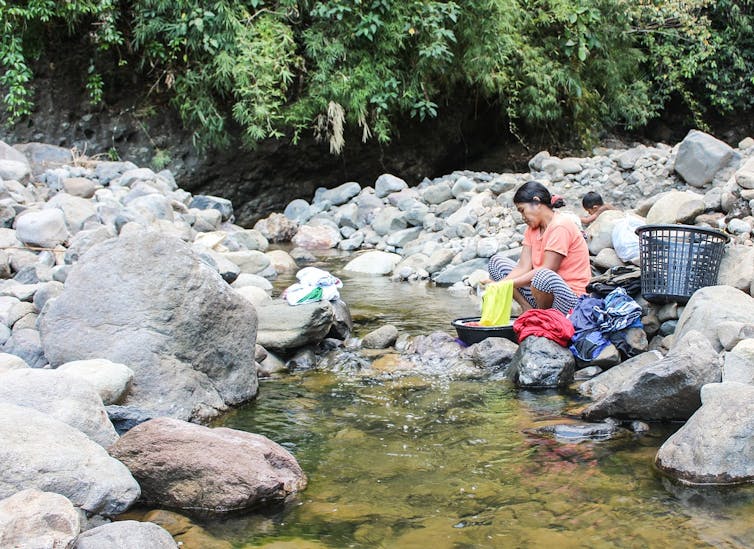
Between 6,500 and 87,000 tonnes of microfibres are shed during domestic laundering every year in the UK. Many of these minuscule fibres end up in rivers and oceans, with devastating consequences for aquatic animals and environments.
As a result, environmental advocacy groups in the UK, EU and North America are campaigning for legislation to mandate microfibre-catching filters for all new washing machines.
But microfibre pollution isn’t limited to machine washing. Our new research shows that washing clothing by hand can shed just as many microfibres as laundry washed in a machine.
This is an issue. More than half of the global population doesn’t have regular access to a washing machine and so launder “off-grid”, such as by hand. Hand washing laundry often involves a lot of scrubbing and abrasion that sheds fibres. Wastewater from hand laundering may flow directly into rivers or onto concrete and stone “laundry decks”, bypassing wastewater treatment facilities even where such facilities are available.
Resolving the microfibre pollution problem necessitates more than just installing washing machine filters. It requires changes in how textiles are designed, manufactured and traded on a global scale.
Fibres Shed From Hand Laundry
Scientific research into fibre shedding often overlooks people that hand launder their clothes, with the predominant focus being on the fibres shed by conventional electric washing machines. Although scientists from countries where many people wash by hand have observed that these methods result in fibre shedding, they have seldom received the necessary support to measure or compare the quantity of fibres shed.
Our research was conducted with colleagues from Isabela State University in the Philippines, Wollongong University in Australia and seven other universities across the UK. We held a workshop and observed hand laundering practices in the Cagayan River Valley in the northern Philippines. We then replicated the hand laundering techniques demonstrated by the local community within a laboratory.
Our experiments measured the fibres shed from both pre-washed and brand-new 100% polyester trousers purchased from a UK high street store. These trousers closely resembled the polyester clothing we found in markets in the Philippines and the garments we observed being hand laundered there.
We found that hand washing these trousers using a plastic scrub brush led to fibre shedding levels of between 6,499 and 64,500 individual fibres per garment. This is comparable to the levels reported for machine laundering. It is evident that hand laundering is not necessarily gentler on textiles than machine laundry.
Measuring ‘Sheddability’
People who hand wash their clothes employ various techniques. These are based on the textiles they are washing and the purpose an item of clothing serves. Clothing that is covered in dust or mud, like garments worn for farm work, may require vigorous scrubbing.
Our research could not recreate all of the ways people launder by hand. We were also unable to explore the impact of every textile variable on fibre shedding, including colouration method, dye type, specific knit or weave structure, and mechanical or chemical finishing.
Among the variables we did examine, our results demonstrated that the structure of the textiles had a more pronounced effect on fibre shedding than the type of fibre itself. Fibre type had no significant influence on shedding. Notably, woven textiles shed fewer fibres compared to their knitted counterparts.
It’s not just synthetic textiles that shed problematic fibres. Plant-based textiles like cotton and animal-based textiles such as wool shed fibres in similar quantities to plastic fibres. Some research even suggests that cellulose-based fibres such as cotton may impose comparable, if not more severe, consequences on organisms that ingest them when compared to synthetic microfibres.
Despite often being marketed as “biodegradable”, cotton fibres undergo modifications for use in the textile industry that alter the structure of the cellulose they are composed of. Most cottons also have chemical dyes and finishes added during processing.
As a result, cotton textile fibres do not readily biodegrade in natural surroundings. And any degradation that does occur will probably release chemicals from their production into the environment. This holds true regardless of the laundering method used for the textiles.
Solving The Microfibre Problem
Solving the issue of textile fibre shedding is complex. There is a massive global trade in used clothing, worth about US$5 billion (£4.1 billion) per year. Even when care labels and fashion designers have considered electric machine washing, potential washing machine filters and wastewater treatment, the export of used clothing takes these textiles away from that established infrastructure.
But the people we observed hand washing clothing need the affordable and durable work attire that this used clothing trade provides. This means that, to address textile fibre shedding, we require a complete rethink not only of the ways we launder our clothes, but of how clothing is made.
The fundamental problem lies not in the secondhand clothing trade, but in the design of textiles themselves. We could make headway in tackling the microfibre issue by designing low-shed fabrics to make garments that can better withstand the rigours of hand washing. Another approach is the development of new truly biodegradable fibres that will break down naturally in the environment.

In the meantime, those who pride themselves on avoiding synthetic fabrics should recognise that the microfibre problem extends beyond the materials we wear. Textile marketing should not greenwash by conflating “natural” and “biodegradable”. And relying on washing machine filters alone will not solve the problem of microfibre shedding.

Don’t have time to read about climate change as much as you’d like?
Get a weekly roundup in your inbox instead. Every Wednesday, The Conversation’s environment editor writes Imagine, a short email that goes a little deeper into just one climate issue. Join the 20,000+ readers who’ve subscribed so far.![]()
Deirdre McKay, Professor of Sustainable Development, Keele University; Kelly Sheridan, Associate Professor in Forensic Science, Northumbria University, Newcastle, and Thomas Stanton, Axa Research Fund Fellow, Loughborough University
This article is republished from The Conversation under a Creative Commons license. Read the original article.
Pittwater Reserves: Histories + Notes + Pictorial Walks
A History Of The Campaign For Preservation Of The Warriewood Escarpment by David Palmer OAM and Angus Gordon OAM
A Stroll Around Manly Dam: Spring 2023 by Kevin Murray and Joe Mills
A Stroll Through Warriewood Wetlands by Joe Mills February 2023
A Walk Around The Cromer Side Of Narrabeen Lake by Joe Mills
America Bay Track Walk - photos by Joe Mills
An Aquatic June: North Narrabeen - Turimetta - Collaroy photos by Joe Mills
Angophora Reserve Angophora Reserve Flowers Grand Old Tree Of Angophora Reserve Falls Back To The Earth - History page
Annie Wyatt Reserve - A Pictorial
Aquatic Reflections seen this week (May 2023): Narrabeen + Turimetta by Joe Mills
Avalon's Village Green: Avalon Park Becomes Dunbar Park - Some History + Toongari Reserve and Catalpa Reserve
Bairne Walking Track Ku-Ring-Gai Chase NP by Kevin Murray
Bangalley Headland Bangalley Mid Winter
Banksias of Pittwater
Barrenjoey Boathouse In Governor Phillip Park Part Of Our Community For 75 Years: Photos From The Collection Of Russell Walton, Son Of Victor Walton
Barrenjoey Headland: Spring flowers
Barrenjoey Headland after fire
Bayview Baths
Bayview Wetlands
Beeby Park
Bilgola Beach
Botham Beach by Barbara Davies
Bungan Beach Bush Care
Careel Bay Saltmarsh plants
Careel Bay Birds
Careel Bay Clean Up day
Careel Bay Playing Fields History and Current
Careel Creek
Careel Creek - If you rebuild it they will come
Centre trail in Ku-ring-gai Chase National Park
Chiltern Track- Ingleside by Marita Macrae
Clareville Beach
Clareville/Long Beach Reserve + some History
Coastal Stability Series: Cabbage Tree Bay To Barrenjoey To Observation Point by John Illingsworth, Pittwater Pathways, and Dr. Peter Mitchell OAM
Cowan Track by Kevin Murray
Curl Curl To Freshwater Walk: October 2021 by Kevin Murray and Joe Mills
Currawong and Palm Beach Views - Winter 2018
Currawong-Mackerel-The Basin A Stroll In Early November 2021 - photos by Selena Griffith
Currawong State Park Currawong Beach + Currawong Creek
Deep Creek To Warriewood Walk photos by Joe Mills
Drone Gives A New View On Coastal Stability; Bungan: Bungan Headland To Newport Beach + Bilgola: North Newport Beach To Avalon + Bangalley: Avalon Headland To Palm Beach
Duck Holes: McCarrs Creek by Joe Mills
Dunbar Park - Some History + Toongari Reserve and Catalpa Reserve
Dundundra Falls Reserve: August 2020 photos by Selena Griffith - Listed in 1935
Elsie Track, Scotland Island
Elvina Track in Late Winter 2019 by Penny Gleen
Elvina Bay Walking Track: Spring 2020 photos by Joe Mills
Elvina Bay-Lovett Bay Loop Spring 2020 by Kevin Murray and Joe Mills
Fern Creek - Ingleside Escarpment To Warriewood Walk + Some History photos by Joe Mills
Iluka Park, Woorak Park, Pittwater Park, Sand Point Reserve, Snapperman Beach Reserve - Palm Beach: Some History
Ingleside
Ingleside Wildflowers August 2013
Irrawong - Ingleside Escarpment Trail Walk Spring 2020 photos by Joe Mills
Irrawong - Mullet Creek Restoration
Katandra Bushland Sanctuary - Ingleside
Lucinda Park, Palm Beach: Some History + 2022 Pictures
McCarrs Creek
McCarr's Creek to Church Point to Bayview Waterfront Path
McKay Reserve
Mona Vale Beach - A Stroll Along, Spring 2021 by Kevin Murray
Mona Vale Headland, Basin and Beach Restoration
Mona Vale Woolworths Front Entrance Gets Garden Upgrade: A Few Notes On The Site's History
Mount Murray Anderson Walking Track by Kevin Murray and Joe Mills
Mullet Creek
Narrabeen Creek
Narrabeen Lagoon Catchment: Past Notes Present Photos by Margaret Woods
Narrabeen Lagoon Entrance Clearing Works: September To October 2023 pictures by Joe Mills
Narrabeen Lagoon State Park
Narrabeen Lagoon State Park Expansion
Narrabeen Rockshelf Aquatic Reserve
Nerang Track, Terrey Hills by Bea Pierce
Newport Bushlink - the Crown of the Hill Linked Reserves
Newport Community Garden - Woolcott Reserve
Newport to Bilgola Bushlink 'From The Crown To The Sea' Paths: Founded In 1956 - A Tip and Quarry Becomes Green Space For People and Wildlife
Pittwater Reserves: The Green Ways; Bungan Beach and Bungan Head Reserves: A Headland Garden
Pittwater Reserves, The Green Ways: Clareville Wharf and Taylor's Point Jetty
Pittwater Reserves: The Green Ways; Hordern, Wilshire Parks, McKay Reserve: From Beach to Estuary
Pittwater Reserves - The Green Ways: Mona Vale's Village Greens a Map of the Historic Crown Lands Ethos Realised in The Village, Kitchener and Beeby Parks
Pittwater Reserves: The Green Ways Bilgola Beach - The Cabbage Tree Gardens and Camping Grounds - Includes Bilgola - The Story Of A Politician, A Pilot and An Epicure by Tony Dawson and Anne Spencer
Pittwater spring: waterbirds return to Wetlands
Pittwater's Lone Rangers - 120 Years of Ku-Ring-Gai Chase and the Men of Flowers Inspired by Eccleston Du Faur
Pittwater's Great Outdoors: Spotted To The North, South, East + West- June 2023: Palm Beach Boat House rebuild going well - First day of Winter Rainbow over Turimetta - what's Blooming in the bush? + more by Joe Mills, Selena Griffith and Pittwater Online
Pittwater's Parallel Estuary - The Cowan 'Creek
Resolute Track at West Head by Kevin Murray
Resolute Track Stroll by Joe Mills
Riddle Reserve, Bayview
Salvation Loop Trail, Ku-Ring-Gai Chase National Park- Spring 2020 - by Selena Griffith
Seagull Pair At Turimetta Beach: Spring Is In The Air!
Stapleton Reserve
Stapleton Park Reserve In Spring 2020: An Urban Ark Of Plants Found Nowhere Else
Stony Range Regional Botanical Garden: Some History On How A Reserve Became An Australian Plant Park
The Chiltern Track
The Chiltern Trail On The Verge Of Spring 2023 by Kevin Murray and Joe Mills
The Resolute Beach Loop Track At West Head In Ku-Ring-Gai Chase National Park by Kevin Murray
Topham Track Ku-Ring-Gai Chase NP, August 2022 by Joe Mills and Kevin Murray
Towlers Bay Walking Track by Joe Mills
Trafalgar Square, Newport: A 'Commons' Park Dedicated By Private Landholders - The Green Heart Of This Community
Tranquil Turimetta Beach, April 2022 by Joe Mills
Turimetta Beach Reserve by Joe Mills, Bea Pierce and Lesley
Turimetta Beach Reserve: Old & New Images (by Kevin Murray) + Some History
Turimetta Headland
Turimetta Moods by Joe Mills: June 2023
Turimetta Moods (Week Ending June 23 2023) by Joe Mills
Turimetta Moods: June To July 2023 Pictures by Joe Mills
Turimetta Moods: July Becomes August 2023 by Joe Mills
Turimetta Moods: August Becomes September 2023 ; North Narrabeen - Turimetta - Warriewood - Mona Vale photographs by Joe Mills
Turimetta Moods: Mid-September To Mid-October 2023 by Joe Mills
Warriewood Wetlands - Creeks Deteriorating: How To Report Construction Site Breaches, Weed Infestations + The Long Campaign To Save The Warriewood Wetlands & Ingleside Escarpment March 2023
Warriewood Wetlands and Irrawong Reserve
Whale Beach Ocean Reserve: 'The Strand' - Some History On Another Great Protected Pittwater Reserve
Wilshire Park Palm Beach: Some History + Photos From May 2022
Winji Jimmi - Water Maze

Narrabeen Bridge 1946
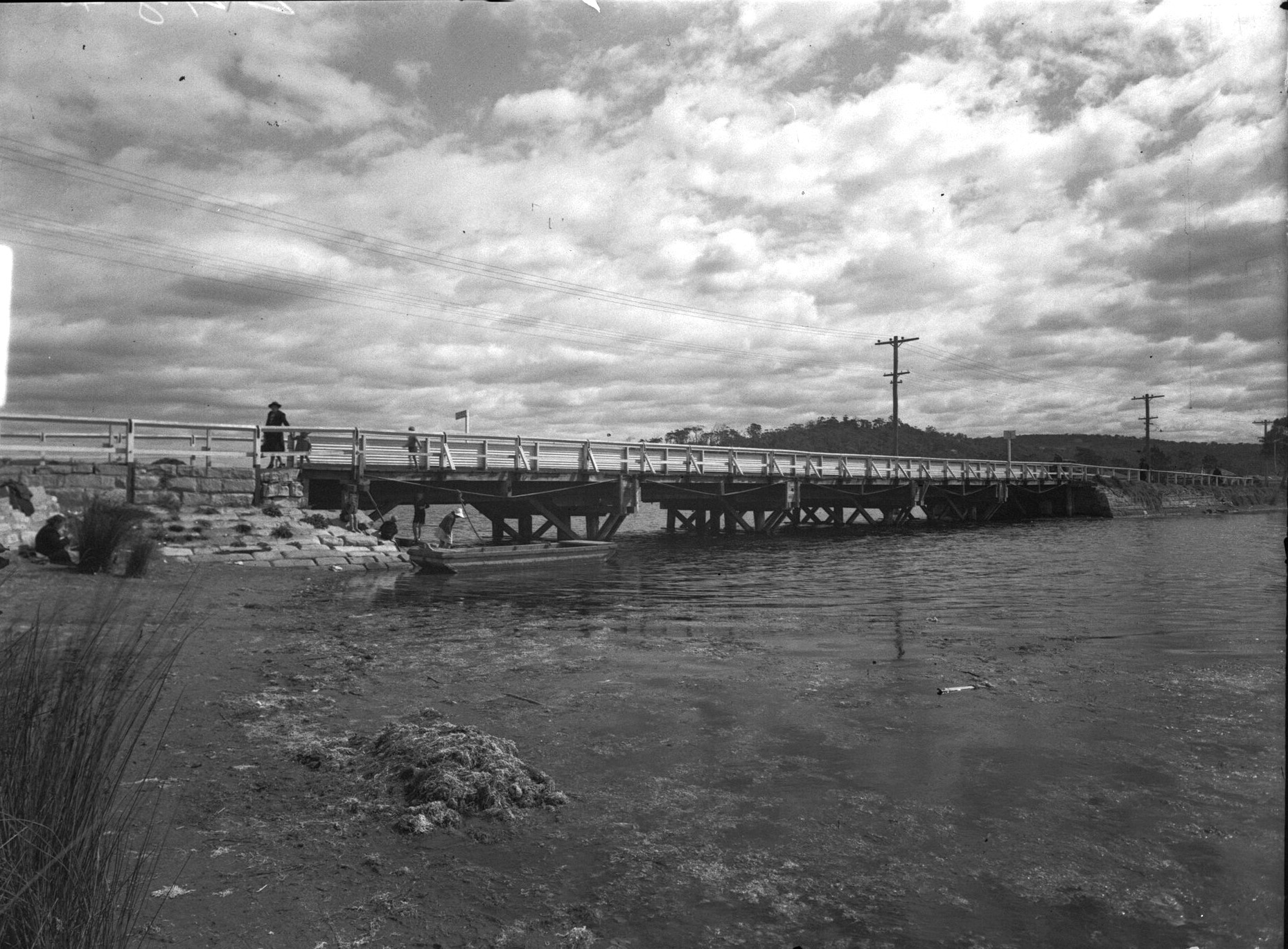

Curiosity Rover Finds New Evidence Of Ancient Mars Rivers, A Key Signal For Life

Exhibition Spotlights Film Behind And Beyond The Front Line
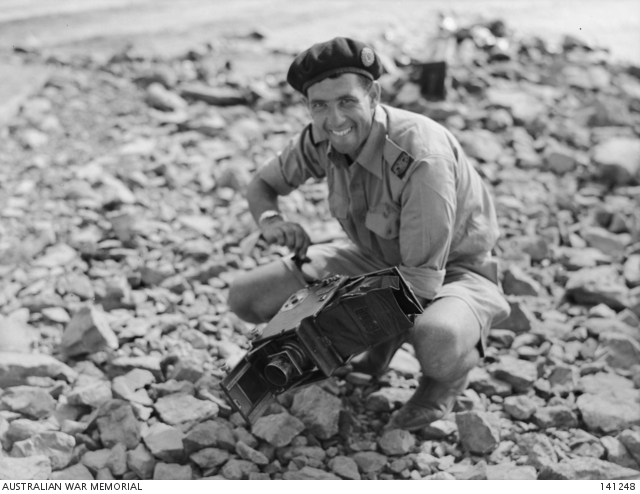 A new touring exhibition from the Australian War Memorial, Action! Film and War, opened in Sydney at the State Library of New South Wales on Friday 6 October.
A new touring exhibition from the Australian War Memorial, Action! Film and War, opened in Sydney at the State Library of New South Wales on Friday 6 October.New Research By ReachOut Highlights Links Between Study Stress And Poor Sleep In The Lead Up To Year 12 Exams
- Lifeline – 13 11 14
- Kids Helpline – 1800 55 1800
- 13YARN – 13 92 76 to speak with an Aboriginal & Torres Strait Islander crisis supporter
- If you are in immediate danger dial 000
Links To ReachOut Support Content

8 Student-Backed Study Tips To Help You Tackle The HSC
By University of Sydney: Last updated 6 July 2023
Our students have been through their fair share of exams and learned a lot of great study tactics along the way. Here they share their top study tips to survive and thrive during exam time.
1. Start your day right
Take care of your wellbeing first thing in the morning so you can dive into your day with a clear mind.
“If you win the morning, you can win the day,” says Juris Doctor student Vee Koloamatangi-Lamipeti.
An active start is a great way to set yourself up for a productive day. Begin your morning with exercise or a gentle walk, squeeze in 10 minutes of meditation and enjoy a healthy breakfast before you settle into study.
2. Schedule your study
“Setting up a schedule will help you organise your time so much better,” says Master of Teaching student Wesley Lai.
Setting a goal or a theme for each study block will help you to stay focused, while devoting time across a variety of subjects will ensure you've covered off as much as possible. Remember to keep your schedule realistic and avoid over-committing your time.
Adds Wesley, “Make sure to schedule in some free time for yourself as well!”
3. Keep it consistent
“Make studying a habit,” recommends Alvin Chung, who is currently undertaking a Bachelor of Arts and Bachelor of Laws.
With enough time and commitment, sitting down to study will start to feel like second nature rather than a chore.
“Do it every day and you’ll be less likely to procrastinate because it’s part of your life’s daily motions,” says Alvin.
4. Maintain motivation
Revising an entire year of learning can seem like an insurmountable task, which is why it’s so important to break down your priorities and set easy-to-achieve goals.
“I like to make a realistic to-do list where I break down big tasks into smaller chunks,” says Bachelor of Arts and Advanced Studies student Dannii Hudec.
“It’s also really important to reward yourself after you complete each task to keep yourself motivated.”
Treat yourself after each study block with something to look forward to, such as a cup of tea, a walk in the park with a friend or an episode of your latest Netflix obsession.
5. Minimise distractions
With so many distractions at our fingertips, it can be hard to focus on the task at hand. If you find yourself easily distracted, an “out of sight, out of mind” approach might do the trick.
“What helps me is to block social media on my laptop. I put my phone outside of my room when I study, or I give it to my sister or a friend to hide,” says Bachelor of Commerce and Bachelor of Laws student Caitlin Douglas.
While parting ways with your phone for a few hours may seem horrifying, it can be an incredibly effective way to stay on task.
“It really helps me to smash out the work and get my tasks done,” affirms Caitlin.
6. Beware of burnout
Think of the HSC period as a marathon rather than a sprint. It might be tempting to cram every single day but pacing out your study time will help to preserve your endurance.
“Don’t do the work for tomorrow if you finish today’s work early,” suggests Daniel Kim, who is currently undertaking a Bachelor of Commerce and Advanced Studies.
“Enjoy the rest of your day and save the energy for tomorrow,” he recommends.
Savouring your downtime will help you to avoid burning out before hitting the finish line.
7. Get a good night's sleep
Sleep is one of your greatest allies during exam season.
“I’ve found that a good night’s sleep always helps with concentration and memory consolidation,” says Bachelor of Science (Medical Science) student Yasodara Puhule-Gamayalage.
We all know we need to be getting around 8 hours of sleep a night to perform at our best, but did you know the quality of sleep also matters? You can help improve the quality of your sleep with some simple tweaks to your bedtime routine.
“Avoid caffeine in the 6 hours leading up to sleep, turn off screens an hour before going to bed, and go to bed at the same time every night,” suggests Yasodara.
8. Be kind to yourself
With exam dates looming and stress levels rising, chances are high that you might have a bad day (or a few!) during the HSC period.
According to Bachelor of Arts and Advanced Studies student Amy Cooper, the best way to handle those bad days is to show yourself some kindness.
“I know that if I’m in a bad state of mind or having a bad day, I’m not going to be able to produce work that I’m proud of,” she says.
For Amy, the remedy for a bad day is to take some time to rest and reset.
“It’s much more productive in the long run for me to go away, do some things I love, and come back with a fresh mind.”
Immerse yourself in a mentally nourishing activity such as going for a bushwalk, cooking your favourite meal, or getting stuck into a craft activity.
If you feel completely overwhelmed, know you're not alone. Reach out to a friend, family member or teacher for a chat when you need support.
There are also HSC Help resources available at: education.nsw.gov.au/student-wellbeing/stay-healthy-hsc
Wednesday 11 October, 2023: HSC written exams start. Friday November 3, 2023: HSC exams finish.
School Leavers Support
- Download or explore the SLIK here to help guide Your Career.
- School Leavers Information Kit (PDF 5.2MB).
- School Leavers Information Kit (DOCX 0.9MB).
- The SLIK has also been translated into additional languages.
- Download our information booklets if you are rural, regional and remote, Aboriginal or Torres Strait Islander, or living with disability.
- Support for Regional, Rural and Remote School Leavers (PDF 2MB).
- Support for Regional, Rural and Remote School Leavers (DOCX 0.9MB).
- Support for Aboriginal and/or Torres Strait Islander School Leavers (PDF 2MB).
- Support for Aboriginal and/or Torres Strait Islander School Leavers (DOCX 1.1MB).
- Support for School Leavers with Disability (PDF 2MB).
- Support for School Leavers with Disability (DOCX 0.9MB).
- Download the Parents and Guardian’s Guide for School Leavers, which summarises the resources and information available to help you explore all the education, training, and work options available to your young person.
School Leavers Information Service
- navigate the School Leavers Information Kit (SLIK),
- access and use the Your Career website and tools; and
- find relevant support services if needed.
Word Of The Week: Halloween
Noun
The word hallowe[']en comes from the Scottish form of All Hallows' Eve (the evening before All Hallows' Day): even is the Scots term for "eve" or "evening", and is contracted to e'en or een; (All) Hallow(s) E(v)en became Hallowe'en.
The word Halloween or Hallowe'en ("Saints' evening") is of Christian origin; a term equivalent to "All Hallows Eve" is attested in Old English.
Etymology: 1781, in a Scottish context, a Scottish shortening of Allhallowe'en, All Hallows even, etc., 1550s, "the evening before All-Hallows." This is from otherwise-obsolete hallow (n.), in Middle English halwe, "holy person, saint," from Old English halga, which is from the source of hallow (v.).
All-Hallows is Middle English al-halwe, late Old English ealra halgan "all saints, the saints in heaven collectively," also the name of the feast day and of individual churches. The date Oct. 31 is described as alle halwe eue by c. 1300. Hallow-day for "All-Saints Day" is from 1590s; earlier was halwemesse day (late 13c.). Hallowtide (15c.) was the first week of November.
The last night of the year in the old Celtic calendar, where it was Old Year's Night, a night for witches or OE; wiccans (wiccan is 'wise woman'; these women originally held knowledge of which herbs and roots could be used for treating illnesses. They were later persecuted by Christian religions who wish to displace their places in communities by installing a patriarch led society).
The word and the magical lore about the date were popularised by Burns' poem (1785, and he attached a footnote explaining it), but it probably dates to 17c. in Scotland and is the name of a tune in 1724. The tune is mentioned again in an English-Scots songbook ("The Chearful Companion") in 1783, and Burns was not the first to describe the customs in print.
Hallow-E'en, or Holy Eve, is the evening previous to the celebration of All Saints. That it is propitious to the rites of divination, is an opinion still common in many parts of Scotland. [John Main, footnote to his poem "Hallow-E'en," Glasgow, 1783]

Illustration to Robert Burns' poem Halloween by John Masey Wright (1777–1866, artist) Edward Scriven (1775–1841, engraver)
Compare Hallow - verb: honour as holy. noun, Archaic: a saint or holy person. 1. to make holy or sacred; sanctify; consecrate. 2. to regard as holy; honour as sacred; venerate. 3. devote, dedicate, consecrate, hallow mean to set apart for a special and often higher end.
The night of 31 October, the eve of All Saints' Day, often celebrated by children dressing up in frightening masks and costumes. Halloween is thought to be associated with the Celtic festival Samhain, when ghosts and spirits were believed to be abroad.
Halloween or Hallowe'en (less commonly known as Allhalloween, All Hallows' Eve, or All Saints' Eve) is a celebration observed in many countries on 31 October, the eve of the Western Christian feast of All Saints' Day. It begins the observance of Allhallowtide, the time in the liturgical year dedicated to remembering the dead, including saints (hallows), martyrs, and all the faithful departed.
Celebrated in Ireland and Scotland for centuries, Irish and Scottish immigrants took many Halloween customs to North America in the 19th century, and then through American influence various Halloween customs spread to other countries by the late 20th and early 21st century.
Popular Halloween activities include trick-or-treating (or the related guising and souling), attending Halloween costume parties, carving pumpkins or turnips into jack-o'-lanterns, lighting bonfires, apple bobbing, divination games, playing pranks, visiting haunted attractions, telling scary stories, and watching horror or Halloween-themed films. Some people practice the Christian observances of All Hallows' Eve, including attending church services and lighting candles on the graves of the dead, although it is a secular celebration for others. Some Christians historically abstained from meat on All Hallows' Eve, a tradition reflected in the eating of certain vegetarian foods on this vigil day, including apples, potato pancakes, and soul cakes.
Samhain ( Irish: sˠəunʲ, Scottish Gaelic: s̪ãũɪɲ; Manx: Sauin ) is a Gaelic festival on 1 November marking the end of the harvest season and beginning of winter or "darker half" of the year. It is also the Irish language name for November. Celebrations begin on the evening of 31 October, since the Celtic day began and ended at sunset. This is about halfway between the autumnal equinox and winter solstice. It is one of the four Gaelic seasonal festivals along with Imbolc, Bealtaine, and Lughnasa. Historically it was widely observed throughout Ireland, Scotland, and the Isle of Man (where it is spelled Sauin). A similar festival is held by the Brittonic Celtic people, called Calan Gaeaf in Wales, Allantide in Cornwall and Noz an Anaon in Brittany.
Samhain is believed to have Celtic pagan origins and some Neolithic passage tombs in Ireland and Britain are aligned with the sunrise at the time of Samhain. It is mentioned in the earliest Irish literature, from the 9th century, and is associated with many important events in Irish mythology. The early literature says Samhain was marked by great gatherings and feasts and was when the ancient burial mounds were open, which were seen as portals to the Otherworld. Some of the literature also associates Samhain with bonfires and sacrifices.
The festival was not recorded in detail until the early modern era. It was when cattle were brought down from the summer pastures and livestock were slaughtered. Special bonfires were lit, which were deemed to have protective and cleansing powers. Like Bealtaine, Samhain was a liminal or threshold festival, when the boundary between this world and the Otherworld thinned, making contact with the aos sí (the 'spirits' or 'fairies') more likely. Most scholars see them as remnants of pagan gods. At Samhain, they were appeased with offerings of food and drink, to ensure the people and livestock survived the winter. The souls of dead kin were also thought to revisit their homes seeking hospitality, and a place was set at the table for them during a meal. Mumming and guising were part of the festival from at least the early modern era, whereby people went door-to-door in costume reciting verses in exchange for food. The costumes may have been a way of imitating, and disguising oneself from, the aos sí. Divination was also a big part of the festival and often involved nuts and apples.
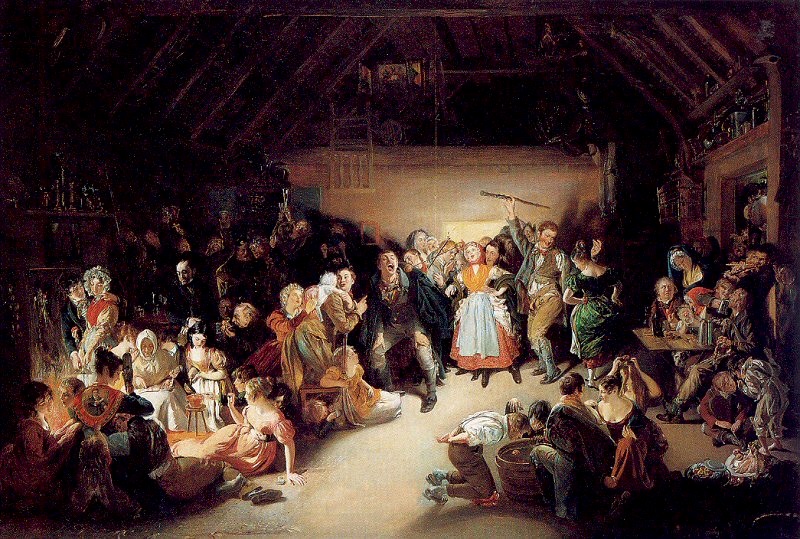
Snap-Apple Night, painted by Irish artist Daniel Maclise in 1833. It was inspired by a Halloween party he attended in Blarney, Ireland, in 1832. The caption in the first exhibit catalogue: There Peggy was dancing with Dan While Maureen the lead was melting, To prove how their fortunes ran With the Cards could Nancy dealt in; There was Kate, and her sweet-heart Will, In nuts their true-love burning, And poor Norah, though smiling still She'd missed the snap-apple turning. On the Festival of Hallow Eve.
While Irish mythology was originally a spoken tradition, much of it was eventually written down in the Middle Ages by Christian monks. The tenth-century tale Tochmarc Emire ('The Wooing of Emer') lists Samhain as the first of the four seasonal festivals of the year. The literature says a peace would be declared and there were great gatherings where they held meetings, feasted, drank alcohol, and held contests. These gatherings are a popular setting for early Irish tales. The tale Echtra Cormaic ('Cormac's Adventure') says that the Feast of Tara was held every seventh Samhain, hosted by the High King of Ireland, during which new laws and duties were ordained; anyone who broke the laws established during this time would be banished. - Info from Wikipedia.
NB: throwing eggs at people, property and passing cars this Halloween, as happened last year, is NOT a trick; it is a dangerous practice that may cause accidents and at least will cause damage to property for which you may be prosecuted. Have a dress-up, have a dance, and treat yourself to some fruit, lollies and chocolates instead. Just have some fun with it if you're going to get involved, and as always, please look out for and after each other. Remember; we are not here to tear each other down, we are here to lift each other up. Thanks darlings.
How much time do kids spend on devices – playing games, watching videos, texting and using the phone?


Curious Kids is a series for children of all ages. If you have a question you’d like an expert to answer, send it to curiouskidsus@theconversation.com.
How many hours does the average American spend on devices each year? – Maxwell P., age 10
Think about your favorite devices – your smartphone, laptop, tablet, computer or console – the things you use to play cool games, watch hilarious videos and connect and chat with friends.
Many young people spend a lot of free time looking at them. Turns out that teens spend an average of 8½ hours on screens per day, and tweens – that’s ages 8 to 12 – are not far behind, at 5½ hours daily.
Keep in mind those numbers are for only social media, gaming and texting. They do not include the time that kids used screens for schoolwork or homework.
What’s more, much of the time taken up by social media and texting is apparently not even enjoyable, much less productive. A 2017 study of teens ages 13 to 18 suggests they spend most of those hours on the phone in their bedroom, alone and distressed.
These lonely feelings correlate with the rise in the use of digital media. In 2022, 95% of teens had smartphones compared with only 23% in 2011. And 46% of today’s teens say they use the internet almost constantly, compared with 24% of teenagers who said the same in 2014 and 2015.
Our team of psychiatrists who treat young people with digital addiction have many patients who spend over 40 hours per week on screens – and some, up to 80 hours.
Think about it: If you spend “just” an average of 50 hours per week on devices from ages 13 to 18 – the total time you will spend on screens equates to more than 12 years of school!
Find The Right Balance
All this is not to say that everything about devices is bad. In this digital age, people embark on exciting journeys through the screens of their devices. Sometimes, screens are the windows to a magical adventure.
But too much screen time can lead to problems. As human beings, we function best when we’re in a state of balance. That happens when we eat well, exercise regularly and get enough sleep.
But spending too much time using digital devices can cause changes in the way you think and behave. Many teens and tweens developed the “fear of missing out” – known as FOMO. And one study shows some people develop nomophobia, which is the fear of being without your phone, or feeling anxious when you can’t use it.
Moreover, digital addiction in high school may predict serious depression, anxiety and sleep disruption in college.
Rates of depression and anxiety are skyrocketing among college students. The fear of missing out is pervasive, resulting in sleep disruption; too many college students sleep with smartphones turned on and near their bed – and wake up to respond to texts and notifications during the night. Sleep disruption itself is a core symptom of both depression and anxiety.
How To Avoid Device Addiction
A 2016 poll indicated that half of teens felt they were addicted to their mobile devices.
Getting hooked on screens means missing out on healthy activities. To achieve a better balance, some experts recommend the following: Turn off all screens during family meals and outings. Don’t complain when your parents use parental controls. And turn off all the screens in your bedroom 30 to 60 minutes before bedtime – this step will improve sleep.
You may be a “screen addict” if you:
- Feel uneasy or grumpy when you can’t use your device.
- Don’t take breaks while spending hours on your device.
- Ignore other fun activities you enjoy, like going outside or reading a book.
- Have trouble sleeping, or falling asleep, because your screen time is too close to bedtime.
- Experience eye, lower back and neck strain.
- Struggle with weight gain or obesity because you’re inactive.
- Have difficulty with real-life, face-to-face social interactions.
If you notice these signs, do not dismiss them. But also realize you’re not alone and help is out there. You can find balance again.
A Healthy Approach
Exercise – riding a bike, playing sports, lifting weights or going for a jog or walk – keeps your brain healthy and protects it against depression and anxiety, as well as limiting your screen time.
Another way to be happier and healthier is to spend time with people – face to face, not via a screen. Seeing people live and in person is the best way to bond with others, and it may be even better for life span than exercise.
Creative hobbies are good, too. Cooking, playing an instrument, dancing, any arts and crafts, and thousands of other fun things make people happier and more creative. What’s more, hobbies make you well rounded and more attractive to others – which leads to more face-to-face interactions.
It’s also critical for parents to practice healthy screen habits. But about one-third of adults say they use screens “constantly.” This is not exactly a great example for kids; when adults take responsibility to minimize their own screen time, the whole family gets better.
Our research team used magnetic resonance imaging, also known as MRI, to scan the brains of teens who had digital addiction. We found impairment in the brain’s decision-making, processing and reward centers. But after a digital fast – meaning the addicted teens unplugged for two weeks – those brain abnormalities reversed, and the damage was undone.
Our findings also showed that kids with a desire to overcome digital addiction did better with a digital fast than those who were less willing or who denied their addiction.
A balanced lifestyle in the digital age is all about finding joy in screenless activities – being active, connecting with others and exploring your offline interests.
Hello, curious kids! Do you have a question you’d like an expert to answer? Ask an adult to send your question to CuriousKidsUS@theconversation.com. Please tell us your name, age and the city where you live.
And since curiosity has no age limit – adults, let us know what you’re wondering, too. We won’t be able to answer every question, but we will do our best.![]()
David Rosenberg, Professor of Psychiatry and Neuroscience, Wayne State University and Natalia Szura, Research Assistant in Psychiatry, Wayne State University
This article is republished from The Conversation under a Creative Commons license. Read the original article.
Is TikTok right – will eating three carrots a day really give me a natural tan?

A beauty trend gaining popularity on TikTok, dubbed the “carrot tan”, claims eating three carrots a day will give you a natural tan.
But can this really give you a natural glow? And is it healthy?
Why Would Carrots Affect Your Skin Tone?
Carotenoids are natural pigments that give red, orange and yellow colours to fruits and vegetables. Think of them as nature’s paint.
There are many carotenoids including lutein, lycopene, alpha-carotene and beta-carotene. Beta-carotene is the carotenoid responsible for a carrot’s vibrant orange colour.
Once a beta-carotene containing food is digested, special cells in the gut break it into two molecules of retinol (also known as vitamin A). This vitamin A is then used in various critical bodily functions such as vision, reproduction, immunity and growth.
The body controls the conversion of beta-carotene into vitamin A based on what it needs. So, when the body has enough vitamin A, it slows down or stops converting beta-carotene into vitamin A.
Any extra beta-carotene is then either stored in the liver and fat tissue, excreted through poo, or removed via sweat glands in the outer layer of the skin. This is when the orange skin “tan” can happen. In medicine, this is called carotenoderma.
Carotenoderma gives your skin a yellow/orange pigment that is not the same colour you’d turn from a sun tan. It is concentrated in the palms of the hands, the soles of the feet and smile lines near the nose.
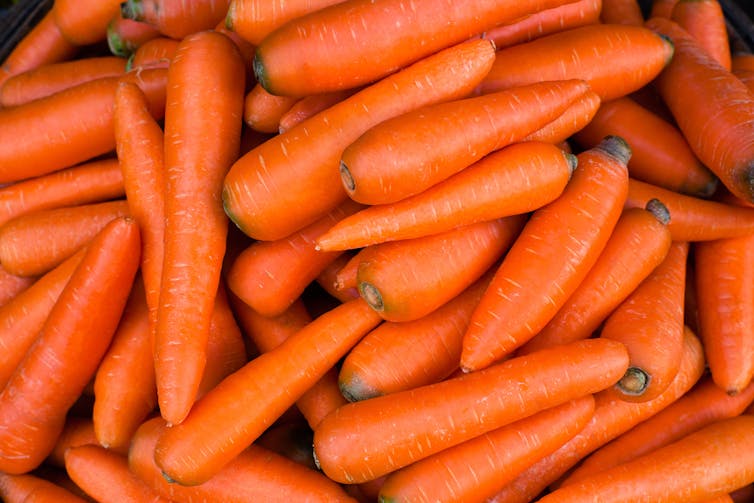
Carrots are not the only food that contains beta-carotene. Dark-green leafy vegetables, some (not all) other yellow- and orange-coloured vegetables and fruits also contain high amounts. Beta-carotene is also found in parsley, basil, chives, chilli powder, sun-dried tomatoes and some dietary supplements.
How Many Carrots Are We Talking?
A few days of high carrot intake will unlikely result in a change in skin colour.
No high quality trials have been conducted to test the relationship between number of carrots eaten per day and skin colour changes or other outcomes. However, there is evidence that carotenoderma appears when blood levels get higher than 250-500 µg/dL.
One published case report (where researchers talk about one patient’s case) found eating around 3 kilograms of carrots per week (about seven large carrots a day) induced skin colour changes.
Other experts suggest you would need to eat at least ten carrots per day, for at least a few weeks, for colour changes to occur. Most people would find this carrot intake challenging.
The amount of carrots needed to change skin colour will also depend on the variety of carrot, its size and ripeness, the way the carrot is prepared (raw or cooked) and whether or not the carrot is eaten with a source of fat. A person’s weight and gastrointestinal health will also impact the amount of beta-carotene absorbed.
Is It Dangerous To Eat Too Much Beta-Carotene?
Vitamin A comes in two main forms, preformed vitamin A and provitamin A.
Preformed vitamin A is the active form of vitamin A found in animal-based foods including liver, fish liver oil, egg yolks and dairy products. When you eat these foods the preformed vitamin A is already ready to be used by the body.
Provitamin A compounds (including beta-carotene) are the precursors to vitamin A. Provitamin A compounds need to be converted into active vitamin A once inside the body.
Preformed vitamin A can be toxic if consumed in large amounts. However, provitamin A compounds don’t cause vitamin A toxicity in humans because the body tightly regulates the conversion of provitamin A compounds to vitamin A. For this reason, there are no recommended limits on how much beta-carotene a person can safely consume each day.
There is, however, some evidence that taking high-dose beta-carotene supplements (20 mg per day or more) increases lung cancer risk in people who smoke cigarettes or used to smoke. This may be due to changes to chemical signalling pathways.
The Cancer Council therefore recommends avoiding high doses of beta-carotene supplements (more than 20 mg per day), especially if you smoke. This does not relate to wholefoods though, so people who smoke should still consume fruits and vegetables that have beta-carotene.
Why You Should Aim For A Variety Of Vegetables
You can still use food to look great without focusing on eating carrots. Incorporating various colourful vegetables, particularly those high in carotenoids, into your diet may promote a natural radiance and a gentle enhancement in skin tone.
Rather than processed foods, a high variety of fresh vegetables provide various nutrients, and some may have what others lack. So it’s important to have a balanced diet that doesn’t depend on a single type of vegetable.
No matter how many carrots you eat in a day, it’s important to protect your skin with sunscreen when going outside.![]()
Lauren Ball, Professor of Community Health and Wellbeing, The University of Queensland and Emily Burch, Dietitian, Researcher & Lecturer, Southern Cross University
This article is republished from The Conversation under a Creative Commons license. Read the original article.
Royal Charter storm of 1859: how an almighty tempest led to the birth of the UK’s shipping forecast
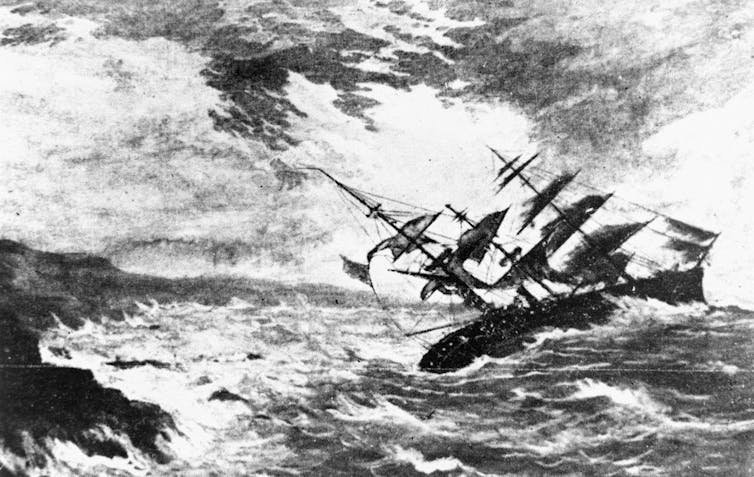
You can read this article in Welsh.
In British weather history, one storm stands out as a catalyst for change – the Royal Charter Storm of 1859. This devastating tempest off the west coast of Britain played a pivotal role in the founding of the shipping forecast and has had an enduring impact on weather forecasting in the UK and beyond.
Winds gusted at 100 miles per hour between October 25 and 26 that year – higher than any previously recorded in the Mersey, in north-west England. And it’s considered to be the most severe Irish Sea storm of the 19th century. More than 800 lives were lost and the storm sank or badly damaged more than 200 ships. But it also paved the way for the creation of the shipping forecast.
The storm is named after the most famous of the ships lost to the waves, a steam and sailing ship called the Royal Charter. After a two-month journey from Melbourne in Australia, the Royal Charter was heading towards Liverpool with its valuable cargo of gold. The ship was caught in the full fury of the storm off the coast of Anglesey, Wales.
Despite the crew’s valiant efforts to anchor the ship and cut its sails, the Royal Charter was driven onto the rocks in the early hours of October 26. With the help of villagers onshore, they succeeded in saving around 40 passengers. Other passengers had tried to swim to shore but were weighed down by the gold in their pockets and drowned. The ship eventually split in two and the waves claimed the lives of more than 450 passengers and crew members, including all the women and children aboard.
The tragic loss of life and property made the storm headline news. It even came to the attention of Charles Dickens, who was working as a journalist in London at the time and visited the site of the wreck soon after the storm.
The Shipping Forecast And The Met Office
Weather observations had been collected from around the British coast since 1854 by a part of the UK Met Office known then as the Meteorological Department of the Board of Trade. The Royal Charter Storm, however, highlighted a need for more accurate weather forecasting and a national storm warning system.
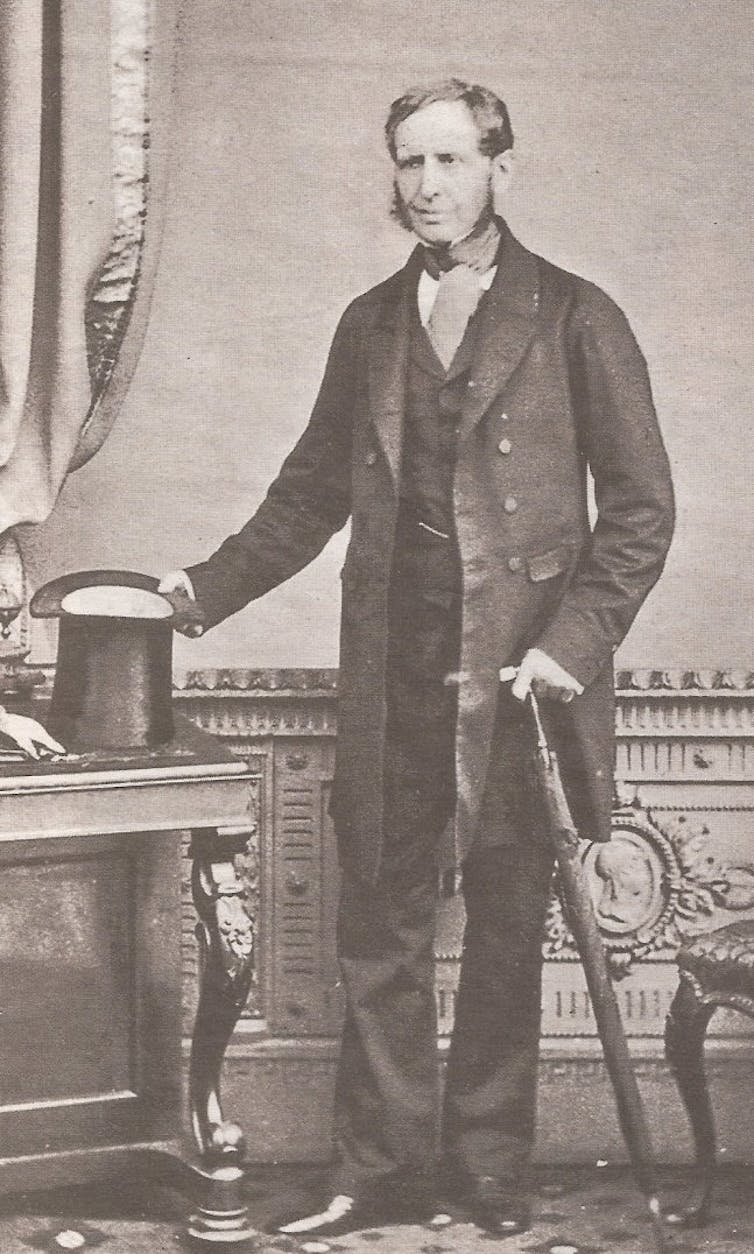
Vice Admiral Robert Fitzroy, founder of the Met Office, had been lobbying for the creation of such a storm warning system since the summer of 1859. Following the Royal Charter storm, Fitzroy was able to demonstrate that it could have been predicted.
In December of that year, the new storm warning system was approved and the first warning was issued in February 1861. This was delivered by telegraph to harbour towns, who then hoisted cones and drums on a mast to warn vessels in harbours and along the coast of the incoming storm.
The UK’s storm warning service – which later became known as the shipping forecast – is the longest running national forecasting service in the world. Today, the Met Office provides the shipping forecast on behalf of the Maritime and Coastguard Agency, and issues a forecast four times a day for the 31 areas of sea around the British Isles.
A Lasting Legacy
In addition to its meteorological legacy, the effects of the storm can still be seen around the Welsh coastline to this day. On Anglesey, the graves of those who died in the wreck can be found in many churches along the coast. Gold nuggets have also washed ashore in recent years.
Further south, in Cwmyreglwys, Pembrokeshire, stand the remains of Saint Brynach’s church, which was partially destroyed by the storm.

Since 1859, the Met Office has made significant strides in the field of meteorology. In August 1861, the first public weather forecast was printed in The Times, then broadcast on the radio in 1922 and was eventually seen on television for the first time in 1936.
Step by step, the Met Office has pioneered new technologies by launching the world’s first meteorological satellite in 1960 and using the first forecast by a computer in 1965. It has continued to invest in state-of-the-art supercomputers to improve severe weather and climate forecasting since then.
Today, the Met Office is a globally recognised authority in meteorology and climate science. Its expertise is invaluable for numerous sectors, from aviation and agriculture to emergency services and infrastructure planning. The Met Office is now responsible for providing the National Severe Weather Warning Service, which includes warnings for wind, rain, thunderstorms, lightning, ice, fog, snow and extreme heat.
Through the Met Office’s dedication to scientific research and accurate forecasting, the UK and the world have benefited from improved weather predictions and increased preparedness for extreme weather events. The legacy of the Royal Charter Storm lives on in the Met Office’s ongoing mission to provide essential weather and climate services, safeguarding lives and livelihoods in an ever-changing climate.![]()
Cerys Jones, Geography Lecturer, Aberystwyth University
This article is republished from The Conversation under a Creative Commons license. Read the original article.
Are ghosts real? A social psychologist examines the evidence


Curious Kids is a series for children of all ages. If you have a question you’d like an expert to answer, send it to curiouskidsus@theconversation.com.
Is it possible for there to be ghosts? – Madelyn, age 11, Fort Lupton, Colorado
Certainly, lots of people believe in ghosts – a spirit left behind after someone who was alive has died.
In a 2021 poll of 1,000 American adults, 41% said they believe in ghosts, and 20% said they had personally experienced them. If they’re right, that’s more than 50 million spirit encounters in the U.S. alone.
That includes the owner of a retail shop near my home who believes his place is haunted. When I asked what most convinced him of this, he sent me dozens of eerie security camera video clips. He also brought in ghost hunters who reinforced his suspicions.
Some of the videos show small orbs of light gliding around the room. In others, you can hear faint voices and loud bumping sounds when nobody’s there. Others show a book flying off a desk and products jumping off a shelf.
It’s not uncommon for me to hear stories like this. As a sociologist, some of my work looks at beliefs in things like ghosts, aliens, pyramid power and superstitions.
Along with others who practice scientific skepticism, I keep an open mind while maintaining that extraordinary claims require extraordinary evidence. Tell me you had a burger for lunch, and I’ll take your word for it. Tell me you shared your fries with Abraham Lincoln’s ghost, and I’ll want more evidence.
In the “spirit” of critical thinking, consider the following three questions:
Are Ghosts Possible?
People may think they’re experiencing ghosts when they hear strange voices, see moving objects, witness balls or wisps of light or even translucent people.
Yet no one describes ghosts as aging, eating, breathing or using bathrooms – despite plumbers receiving many calls about toilets “ghost-flushing.”
So could ghosts be made of a special kind of energy that hovers and flies without dissipating?
If that’s the case, that means when ghosts glow, move objects and make sounds, they are acting like matter – something that takes up space and has mass, like wood, water, plants and people. Conversely, when passing through walls or vanishing, they must not act like matter.
But centuries of physics research have found nothing like this exists, which is why physicists say ghosts can’t exist.
And so far, there is no proof that any part of a person can continue on after death.
What’s The Evidence?
Never before in history have people recorded so many ghost encounters, thanks in part to mobile phone cameras and microphones. It seems there would be great evidence by now. But scientists don’t have it.
Instead, there are lots of ambiguous recordings sabotaged by bad lighting and faulty equipment. But popular television shows on ghost hunting convince many viewers that blurry images and emotional reactions are proof enough.
As for all the devices ghost hunters use to capture sounds, electrical fields and infrared radiation – they may look scientific, but they’re not. Measurements are worthless without some knowledge of the thing you’re measuring.
When ghost hunters descend on an allegedly haunted location for a night of meandering and measurement, they usually find something they later deem paranormal. It may be a moving door (breeze?), a chill (gap in the floorboards?), a glow (light entering from outside?), electrical fluctuations (old wiring?), or bumps and faint voices (crew in other rooms?).
Whatever happens, ghost hunters will draw a bull’s-eye around it, interpret that as “evidence” and investigate no further.
Are There Alternative Explanations?
Personal experiences with ghosts can be misleading due to the limitations of human senses. That’s why anecdotes can’t substitute for objective research. Alleged hauntings usually have plenty of non-ghostly explanations.
One example is that retail establishment in my neighborhood. I reviewed the security camera clips and gathered information about the store’s location and layout, and the exact equipment used in the recordings.
First, the “orbs”: Videos captured many small globes of light seemingly moving around the room.
In reality, the orbs are tiny particles of dust wafting close to the camera lens, made to “bloom” by the camera’s infrared lights. That they appear to float around the room is an optical illusion. Watch any orb video closely and you’ll see they never go behind objects in the room. That’s exactly what you’d expect with dust particles close to the camera lens.
Next, voices and bumps: The shop is in a busy corner mini-mall. Three walls abut sidewalks, loading zones and parking areas; an adjacent store shares the fourth. The security camera mics probably recorded sounds from outdoors, other rooms and the adjacent unit. The owner never checked for these possibilities.
Then, the flying objects: The video shows objects falling off the showroom wall. The shelf rests on adjustable brackets, one of which wasn’t fully seated in its slot. The weight of the shelf caused the bracket to settle into place with a visible jerk. This movement sent some items tumbling off the shelf.
Then, the flying book: I used a simple trick to recreate the event at home: a hidden string taped inside a book’s cover, wrapped around the kitchen island, and tugged by my right hand out of camera range.
Now I can’t prove there wasn’t a ghost in the original video. The point is to provide a more plausible explanation than “it must have been a ghost.”
One final consideration: Virtually all ghostly experiences involve impediments to making accurate perceptions and judgments – bad lighting, emotional arousal, sleep phenomena, social influences, culture, a misunderstanding of how recording devices work, and the prior beliefs and personality traits of those who claim to see ghosts. All of these hold the potential to induce unforgettable ghostly encounters.
But all can be explained without ghosts being real.
Hello, curious kids! Do you have a question you’d like an expert to answer? Ask an adult to send your question to CuriousKidsUS@theconversation.com. Please tell us your name, age and the city where you live.
And since curiosity has no age limit – adults, let us know what you’re wondering, too. We won’t be able to answer every question, but we will do our best.![]()
Barry Markovsky, Distinguished Professor Emeritus of Sociology, University of South Carolina
This article is republished from The Conversation under a Creative Commons license. Read the original article.
Dressing up for Halloween? You could be in breach of copyright law, but it’s unlikely you’ll be sued

Love it or loathe it, it’s almost Halloween.
While it’s traditionally seen as an American holiday, more Australians are preparing to celebrate it this year.
Many jump at the chance to dress up as their favourite fictional character, but have you ever stopped to wonder whether you could be breaking copyright law?
Here’s what we know about costumes, cosplay and copyright.
What Is Copyright?
Copyright is a legal right that grants the creator of an original creative work exclusive rights over the way their work is used or distributed.
The idea of the author holding exclusive rights is to encourage the creation of new works.
Importantly, copyright does not exist in the idea of a character, but in its expression in tangible form.
For example, copyright cannot exist in the general idea of a young wizard who attends a magical school and embarks on adventures.
However, copyright can exist in the expression of the specific details, characters and descriptions J.K. Rowling used to bring Harry Potter to life in her books.
Whether copyright exists depends on two things: the expression of the character, and the type of work that has been created.
Under the Copyright Act 1968, copyright applies to various categories of original authored works, provided they meet specific criteria. These works include:
a literary, artistic, or dramatic work
a sound recording
a film.
Taking Harry Potter films as an example, Warner Bros. could assert copyright in several aspects of their films as separate works.
These could be the original written screenplay as a literary work, the musical score as a musical work, the recorded music as sound recordings and the films as cinematographic works.
The initial design sketches and photographs of costumes in the Harry Potter films could qualify as artistic works.
In 2011, a UK court case considered whether a Star Wars stormtrooper helmet was a sculpture (artistic work) for the purposes of copyright protection.
The case involved one of the craftsmen who helped design the stormtrooper costume. He used his original tools to make stormtrooper helmets and sold them to the general public. Lucasfilm alleged infringement on the basis the helmets were copyrightable sculptures.
However, the UK court rejected this argument. It found that while the helmets had practical functionality, they didn’t have an artistic purpose and therefore were not covered by copyright.
While this issue has not been tested under Australian law, the ruling might be similar.

How Can Copyright Be Infringed?
Infringement is found when a person uses either the entire or a “substantial part” of an original copyrighted work.
The Australian courts have found the idea of a “substantial part” to be a significant, important or distinctive part of the copyrighted material.
That part doesn’t have to be big. Even a tiny part can infringe copyright if it’s distinctive enough.
How Does This All Apply To Costumes?
Along with Halloween dress-ups, cosplay – the hobby of replicating and embodying a wide range of characters through detailed costumes – is another increasingly popular activity.
For cosplayers if the expression of the character is distinctly reproduced, then this might be deemed a “substantial part” of an original work and could therefore be a breach of copyright.
Whether a cosplay costume infringes copyright will require examination in the courts, something that hasn’t happened in Australia yet.
However, the greater the differences between the costume and the original work, the less likely a finding of infringement.
This means relatively small differences in costume elements and features could make a big difference to the outcome.
Costumes As Promotional Material
But even if a costume is technically infringing copyright, are you really going to get sued? Is J.K. Rowling really going to sue a fan for making a Harry Potter costume at Halloween?
This is highly unlikely, particularly when there is no commercial activity involved.
Many authors and artists are proud of the fact their characters are so celebrated through costumes, cosplay and fandom. Homage to creative works plays a vital part of modern pop culture.
For example, as seen with the Game of Thrones, fandom can have a significant influence on the success and longevity of the work.
And ultimately, this can help to promote sales of the original work.
If, however, a person engages in commercial activity, they are more likely to be sued for infringement.
In 2016, an Australian Federal Court case addressed copyright infringement of J.R.R. Tolkien’s “one ring” inscription from Lord of the Rings. Over eight years, the respondent’s jewellery websites sold about 1,300 rings with this inscription.
The court ruled the inscription was an artistic work and was therefore protected by copyright. Through the respondent’s commercial activity, they had reproduced and sold a substantial part of the inscription, without licence or consent and were found liable.
So if you create your favourite character’s costume this Halloween, even if you are technically infringing copyright, the chances of you being sued are low.
If, however, you engage in commercial activities, your chances of being sued are much higher.![]()
Wellett Potter, Lecturer in Law, University of New England
This article is republished from The Conversation under a Creative Commons license. Read the original article.
What to wear for a climate crisis
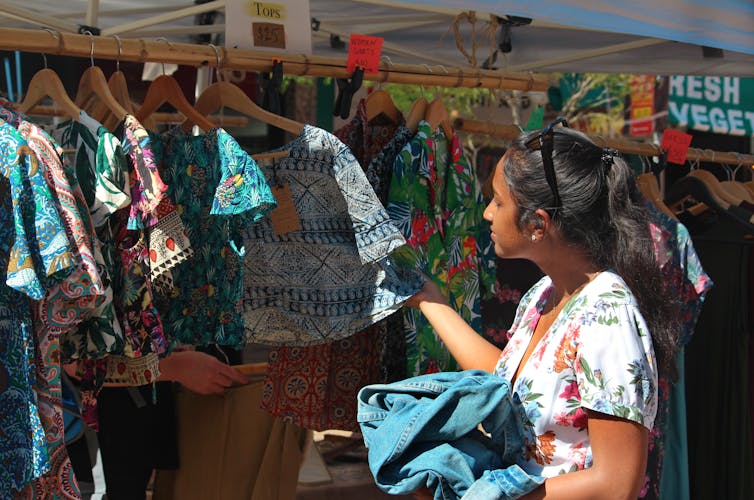
When people move to the country from the city, they need to change their wardrobes, my research on tree-changers in Australia found. The new context of their lives means the clothes they wore for the city no longer work for their new lives. This is also true in the climate crisis.
Our context has changed. When we decide what clothes to buy, we now need to bring into play a wider range of values than the appearance of a garment, its newness and novelty and whether we like it or not. As the Intergovernmental Panel on Climate Change (IPCC) states, if we are to have any hope of avoiding a world that is too hot and unpredictable to live in, we need to do everything we possibly can, right now, to cut greenhouse gas emissions into the atmosphere.
The fashion industry contributes up to 10% of global emissions – more than international aviation and shipping combined. It also contributes to biodiversity loss, pollution, landfill issues, unsafe work practices and more.
Australia’s carbon footprint from the consumption and use of fashion is the world’s biggest, a dubious distinction in a materialistic world.
So this is an area where the choices we make can have big impacts. While individual action will not solve all of the above problems, it will help as we move towards the structural and systemic change needed to live sustainably.
If we are concerned about these issues, responding thoughtfully means we will live our lives according to our values. And that’s an important factor in living well, flourishing and being happy.
Lessons From Wartime
It’s not the first time people have adapted their clothing in response to the demands of a crisis.
During the second world war, clothing styles changed in the United Kingdom and Australia. To conserve precious resources, shorter skirts, minimal detailing and a focus on utility became the norm.
People adapted their personal aesthetics and appearance because the situation was grave and they wanted to “do their bit” to help with the war effort. This was a collective necessity in dire times.
This wartime response reflected the priorities and values of society as a whole as well as most people in that society. In other words, buying less (rationing meant this was not just a choice), mending and making do with what was already there was part of a value system that contributed to the Allied victory.
In novels and other writing from the era, it is clear that at times it was not easy and it could be frustrating. There was, however, a public consensus that it was necessary. This shared commitment to the war effort became a value that made personal sacrifices worthwhile and satisfying.

So What Can We Do Today?
In our current context, the most helpful thing we can do is to buy fewer new clothes and wear them for longer.
Australians buy a lot of clothes, about 56 items per year on average. That makes Australians the second highest textiles consumers in the world after the USA , and is 60% more than we bought even 15 years ago. The price of clothes has dropped significantly over the past couple of decades, and the number of clothes people have in their closets has grown.
If we begin to shift away from our slavish devotion to newness and novelty – following the dictates of fashion – to a mindset of value-led sufficiency, we can appreciate more fully the feel of lived-in, mended or altered clothes. There is a feeling of comfort in pulling on an old garment that is soft with age and repeated washing. There is joy in extending a garment’s life through creative mending, especially when that aligns with our values.
The Berlin-based Hot or Cool Institute suggests a wardrobe of 74 garments (including shoes but excluding undergarments) is typically sufficient for people who live in a two-season climate (in the tropics) and 85 pieces for those who live in a four-season climate, as most Australians do. If we buy ten to 12 new items a year, we can replace our entire wardrobe in about seven years.
Buying second-hand instead of new is even better because it doesn’t add to current production emissions. If we buy second-hand, it still doesn’t mean we should buy more than we need.
Choosing Clothes To Fit Our Values
To live authentic lives that are fulfilling and satisfying in deep and meaningful ways, we need to be true to our selves. In the case of clothing, we should evaluate our choices in relation to the values we hold. And if we do care about living sustainably, that means changing those choices we feel are no longer suited to the climate crisis.
Clothes need to reflect a person’s situation as well as their identity to “work” well. This may mean that what we wear changes as we make different buying decisions, just as people did in the second world war and as tree-changers do. We may start to look different, but that change signifies our values in action.
Best of all, clothing choices that align with keeping global warming to less than 1.5 degrees will have a long-term impact as significant as winning the war.![]()
Rachael Wallis, Research Assistant, Youth Community Futures, University of Southern Queensland
This article is republished from The Conversation under a Creative Commons license. Read the original article.
Pumpkin waste: three ways to stop your leftover lantern becoming a Halloween horror story

This Halloween, around 18,000 tonnes of pumpkins will go to waste in the UK alone. That’s because, of the 30 million purchased each year, about half go entirely uneaten. That’s £27 million worth of edible food. The global costs will be far higher, once we add in the waste in the US and other countries where pumpkin carving is also a Halloween tradition.
The money spent on buying pumpkins is only a fraction of the true cost. When a pumpkin is wasted, the water, energy and labour used to grow and distribute it is also wasted.
For every kilo produced, around 260 grams of carbon dioxide equivalent greenhouse gases are emitted. Then when a pumpkin decomposes in a landfill it emits methane, which is a more potent greenhouse gas than carbon dioxide.
Growing pumpkins also requires plenty of water. When pumpkin leftovers are discarded, the freshwater used in their production is also wasted. The importance of freshwater reserves was well recognised in summer 2022 when much of the UK had hosepipe bans.
In a world where 2 billion people are malnourished, despite the fact that food systems could sustainably feed the total world population, and where families turn to food banks even in wealthy countries, wasting perfectly edible pumpkin is immoral.
Despite all this, we can still make a difference this Halloween. As an academic expert in circular food supply chains, I know how important it is to avoid wasted food, and I have studied how to ensure leftover food is put to use. So I know that people can eliminate these negative impacts of pumpkin waste by simply using leftover pumpkins. Here are the three practical methods.
Cakes, Bread, Soups And Coffee
According to a survey of 3,000 Britons, only 42% knew that the inside of a pumpkin is edible. Repurposing leftovers in cooking and beverages can be one of the simplest ways to use up leftovers.

There are numerous recipes on the internet for cupcakes, bread, puree or soup. There are tasty coffee and mocktail recipes, or you can use your creativity to build your pumpkin cocktails with your favourite ingredients. However, it is crucial to remember that leftover pumpkin should be stored in the fridge and will last for a few days.
Masks, Scrubs And Soap
Not everyone feels comfortable using leftovers in food, and luckily, leftover pumpkins can be used for other purposes, such as do-it-yourself projects at home. Pumpkin is high in iron, potassium, and copper, as well as vitamins A, B2, C, and E, making it an excellent beauty ingredient.
You can use the leftover pumpkins for face masks, body scrubs and soap as do-it-yourself projects. You can even use it to make candles as well.
Feed Some Plants Or Animals
If you don’t want to hassle with the leftover and carved pumpkins, you can always donate them – zoos, farms and community gardens often welcome pumpkin donations. They can use it as compost material or animal snacks.

A recent study showed that if a person is aware that their actions will have a negative impact on the environment, they will try to adopt pro-environmental behaviour. Similarly, sharing the pro-environmental behaviour on social media sets examples and influences others to be more sustainable.
In this case, the pro-environmental behaviour will be using the leftover and carved pumpkins. You can adopt one of the above-mentioned practical ways and post the result on social media.
As I found in my own research, creating and using hashtags, as well as publicising your efforts on social media, will motivate your family and friends to join you. The more the better. Because, in the end, every attempt to eliminate waste is worthwhile.

Don’t have time to read about climate change as much as you’d like?
Get a weekly roundup in your inbox instead. Every Wednesday, The Conversation’s environment editor writes Imagine, a short email that goes a little deeper into just one climate issue. Join the 20,000+ readers who’ve subscribed so far.![]()
Ebru Surucu-Balci, Assistant Professor in Circular Supply Chains, University of Bradford
This article is republished from The Conversation under a Creative Commons license. Read the original article.
What makes a film score frightening? Expert explains the techniques that build tension and make us jump
David Ireland, University of LeedsThink of the scariest film you’ve ever seen. Beyond any blood-curdling screams or pounding heartbeats, there’s sure to be another sound that sticks in your memory – the score.
Perhaps that’s the shrieking strings of Psycho (1960), or the pulsing piano melody and ominous bass of the Halloween franchise (1971-2022). Maybe it’s the eclectic score for Suspiria (1997) – which combined instruments including synthesizers, Greek bouzouki, Indian tabla and whispering voices. Or does The Shining’s (1980) unsettling quotations of music by avant-garde composers like Ligeti and Penderecki still haunt your nightmares?
Horror films incorporate varied musical influences. But there are some devices that they share with successful scary or tension-inducing scores in other genres, including thrillers and contemporary action films. These devices help the creation of an ambiguous musical atmosphere.
This feeling of uncertainty is frequently achieved through a lack of conventional melody and dissonant (clashing) harmonies that do not readily resolve. Repeated short melodies instead convey tension, as do tremolo techniques (sounds that are literally trembling or quivering), involving rapid reiteration of a pitch or alternation between two pitches.
These features shape audience expectations through repetition, creating unease when anticipated development fails to emerge. The entry of additional instruments, increasing volume or regularity of the repetitions, or sequential rising of pitch with each iteration, can all escalate the tension – partly by not promoting substantial melodic evolution.
The Science Of A Scary Score
Composer Bernard Herrmann’s music for Psycho’s shower sequence is a quintessential example. It shuns melody for repeated high-register violin pitches and builds by gradually adding strings to expand the dissonant underlying chord.
Similar techniques are also commonplace in more recent thriller scores by composers like Hans Zimmer. Take Inception (2010), for example, with its recurring guitar motif and building, dissonant, string stabs.
Researching Scary Scores
Drones (sustained notes or repeated figures) also effectively help shape tense atmospheres. These often appear in the bass, sometimes alongside low frequency rumbling. This can be heard in the recent Oppenheimer film (2023), during scenes surrounding the Trinity Test. These drones convey space and ambiguity, given the void between them and any high melodic fragments.
Music researcher K.J. Donnelly sees a connection between these pitch extremities in horror film soundtracks and bodily sounds. The high string lines in soundtracks to film such as Psycho acoustically imitate the “roughness” or harsh qualities of screams. Whispered or shouting voices often feature in horror scores, as do sounds emulating the human heartbeat.
Yet, while these sounds emphasise the physical and vulnerable, the frequent use of electronic instruments and blurring of music and sound design also creates ambiguity which evokes technology and the inhuman. This can be heard in Oppenheimer’s use of ticking sounds from the Geiger counter, a device used to detect radiation.
Contrasting these ambiguous sonic atmospheres, sudden loud bursts of sound or music (stingers) that work like jump scares also often feature. Donnelly describes these sounds as “primal”, mirroring psychological work that lists brainstem reflex (instinctive responses to sudden sonic events), as one musical means of inducing emotion.
Strong musical bursts alongside, and prior to, visual shocks in horror films have been shown to increase stress responses in viewers. Sudden silence can work similarly, as in Oppenheimer during the test-detonation of a nuclear bomb. Likewise, the piercing violin entry in Psycho’s shower scene is heightened by the preceding lack of music.
Using musical features in unfamiliar settings also subverts expectations – and in horror films juxtaposes the innocent and familiar against dark content.
References to religion and childhood are invoked through instruments like the organ and music box, and allusions to hymns and lullabies. Similarly, incongruent lively or nostalgic preexisting music can be used to engage or distance audiences. One example is when Olivia Newton-John’s Over the Rainbow accompanies a gunfight in the action-thriller Face/Off (1997).
Such musical techniques impact us physically and psychologically. Film music scholars have noted this for many years, but in recent decades psychology researchers have started to empirically explore how.
While these devices may not feature in every tension-inducing scene, chances are at least some have contributed to any increased heart rate, goosebumps, or startle responses you have experienced. Such reactions are one key reason why we keep returning to scary films and clearly demonstrate the emotional impact of film music.

Looking for something good? Cut through the noise with a carefully curated selection of the latest releases, live events and exhibitions, straight to your inbox every fortnight, on Fridays. Sign up here.![]()
David Ireland, Associate Professor in Film Music Studies and Music Psychology, University of Leeds
This article is republished from The Conversation under a Creative Commons license. Read the original article.
Most data lives in the cloud. What if it lived under the sea?
Paul Haskell-Dowland, Edith Cowan University and Kathryn McMahon, Edith Cowan UniversityWhere is the text you’re reading, right now? In one sense, it lives “on the internet” or “in the cloud”, just like your favourite social media platform or the TV show you might stream tonight.
But in a physical sense, it’s stored and transmitted somewhere in a network of thousands of data centres across the globe. Each of these centres is whirring, buzzing and beeping around the clock, to store, process and communicate vast amounts of data and provide services to hungry consumers.
All this infrastructure is expensive to build and run, and has a considerable environmental impact. In search of cost savings, greater sustainability and better service, data centre providers are looking to get their feet wet.
Tech giant Microsoft and other companies want to relocate data centres into the world’s oceans, submerging computers and networking equipment to take advantage of cheap real estate and cool waters. Is this a good thing? What about the environmental impact? Are we simply replacing one damaging practice with another?
Which Companies Are Doing This?
Microsoft’s Project Natick has been pursuing the idea of data centres beneath the waves since 2014. The initial premise was that since many humans live near the coast, so should data centres.
An initial experiment in 2015 saw a small-scale data centre deployed for three months in the Pacific Ocean.
A two-year follow-up experiment began in 2018. A total of 864 servers, in a 12 by 3 metre tubular structure, were sunk 35 metres deep off the Orkney Islands in Scotland.
Microsoft is not the only company experimenting with moving data underwater. Subsea Cloud is another American company doing so. China’s Shenzhen HiCloud Data Center Technology Co Ltd has deployed centres in tropical waters off the coast of Hainan Island.
Why Move Data Centres Under The Waves?
Underwater data centres promise several advantages over their land-locked cousins.
1) Energy efficiency
The primary benefit is a significant cut in electricity consumption. According to the International Energy Agency, data centres consume around 1–1.5% of global electricity use, of which some 40% is used for cooling.
Data centres in the ocean can dissipate heat in the surrounding water. Microsoft’s centre uses a small amount of electricity for cooling, while Subsea Cloud’s design has an entirely passive cooling system.
2) Reliability
The Microsoft experiment also found the underwater centre had a boost in reliability. When it was brought back to shore in 2020, the rate of server failures was less than 20% that of land-based data centres.
This was attributed to the stable temperature on the sea floor and the fact oxygen and humidity had been removed from the tube, which likely decreased corrosion of the components. The air inside the tube had also been replaced with nitrogen, making fires impossible.
Another reason for the increased reliability may have been the complete absence of humans, which prevents the possibility of human error impacting the equipment.
3) Latency
More than one third of the world’s population lives within 100 kilometres of a coast. Locating data centres close to where people live reduces the time taken for data to reach them, known as “latency”.
Offshore data centres can be close to coastal consumers, reducing latency, without having to pay the high real-estate prices often found in densely populated areas.
4) Increased security and data sovereignty
Moving data centres into the ocean makes them physically more difficult for hackers or saboteurs to access. It can also make it easier for companies to address “data sovereignty” concerns, in which certain countries require certain data to be stored within their borders rather than transmitted overseas.
5) Cost
Alongside savings due to reduced power bills, fewer hardware failures, and the low price of offshore real estate, the way underwater data centres are built may also cut costs.
The centres can be made in a modular, mass-produced fashion using standardised components, and shipped ready for deployment. There is also no need to consider the comfort or practicality for human operators to interact with the equipment.
What About The Environmental Impact?
At present there is no evidence placing data centres in the world’s oceans will have any significant negative impact. Microsoft’s experiments showed some localised warming, but “the water just metres downstream of a Natick vessel would get a few thousandths of a degree warmer at most”.
The Microsoft findings also showed the submerged data centre provided habitat to marine life, much like a shipwreck:
[…] crabs and fish began to gather around the vessel within 24 hours. We were delighted to have created a home for those creatures.
If underwater data centres go ahead, robust planning will be needed to ensure their placement follows best practise considering cultural heritage and environmental values. There are also opportunities to enhance the environmental benefits of underwater data centres by incorporating nature-positive features in the design to enhance marine biodiversity around these structures.
What’s Next?
Several companies are actively exploring, or indeed constructing, underwater data centres. While the average end-user will have no real awareness of where their data are stored, organisations may soon have opportunities to select local, underwater cloud platforms and services.
Companies with a desire to shout about their environmental credentials may well seek out providers that offer greener data centres – a change that is likely to only accelerate the move to the ocean.
So far, it looks like this approach is practical and can be scaled up. Add in the environmental and economic savings and this may well be the future of data centres for a significant proportion of the planet.![]()
Paul Haskell-Dowland, Professor of Cyber Security Practice, Edith Cowan University and Kathryn McMahon, Deputy Director, Centre for Marine Ecosystems Research, and Associate Dean of Research, Edith Cowan University
This article is republished from The Conversation under a Creative Commons license. Read the original article.
Bringing a shark to a knife fight: 7,000-year-old shark-tooth knives discovered in Indonesia

Excavations on the Indonesian island of Sulawesi have uncovered two unique and deadly artefacts dating back some 7,000 years – tiger shark teeth that were used as blades.
These finds, reported in the journal Antiquity, are some of the earliest archaeological evidence globally for the use of shark teeth in composite weapons – weapons made with multiple parts. Until now, the oldest such shark-tooth blades found were less than 5,000 years old.
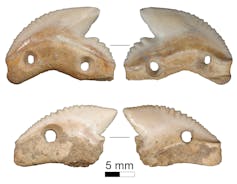
Our international team used a combination of scientific analysis, experimental reproduction and observations of recent human communities to determine that the two modified shark teeth had once been attached to handles as blades. They were most likely used in ritual or warfare.
7,000-Year-Old Teeth
The two shark teeth were recovered during excavations as part of a joint Indonesian-Australian archaeological research program. Both specimens were found in archaeological contexts attributed to the Toalean culture – an enigmatic foraging society that lived in southwestern Sulawesi from around 8,000 years ago until an unknown period in the recent past.
The shark teeth are of a similar size and came from tiger sharks (Galeocerda cuvier) that were approximately two metres long. Both teeth are perforated.
A complete tooth, found at the cave site of Leang Panninge, has two holes drilled through the root. The other – found at a cave called Leang Bulu’ Sipong 1 – has one hole, though is broken and likely originally also had two holes.
Microscopic examination of the teeth found they had once been tightly fixed to a handle using plant-based threads and a glue-like substance. The adhesive used was a combination of mineral, plant and animal materials.
The same method of attachment is seen on modern shark-tooth blades used by cultures throughout the Pacific.
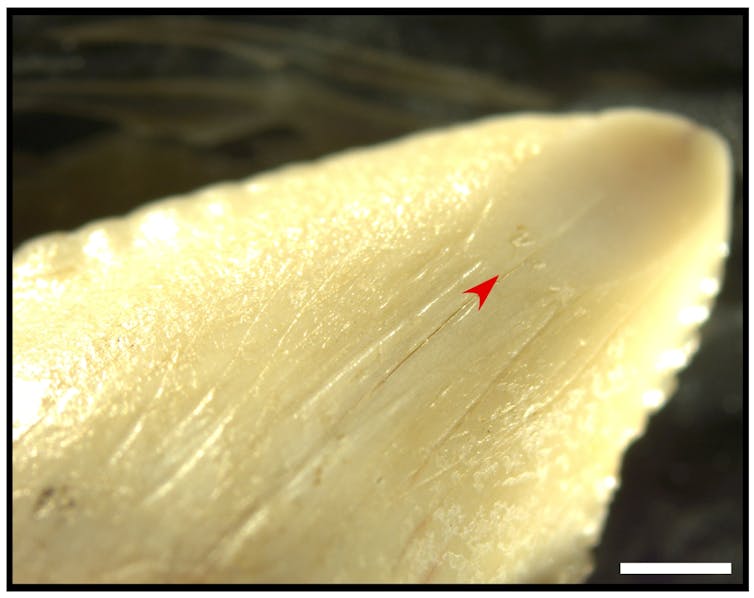
Examination of the edges of each tooth found they had been used to pierce, cut and scrape flesh and bone. However, far more damage was present than a shark would naturally accrue during feeding.
While these residues superficially suggest Toalean people were using shark-tooth knives as everyday cutting implements, ethnographic (observations of recent communities), archaeological and experimental data suggest otherwise.
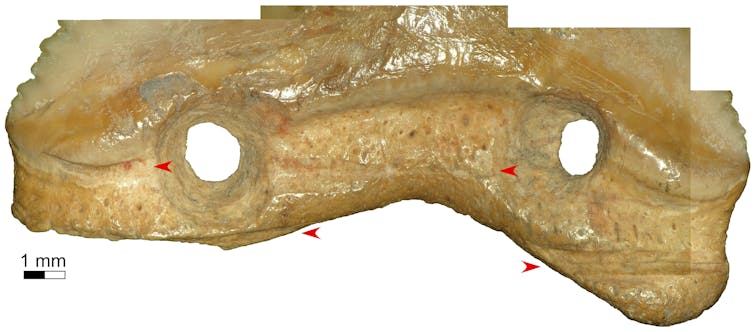
Why Use Shark Teeth?
Not surprisingly, our experiments found tiger shark-tooth knives were equally effective in creating long, deep gashes in the skin when used to strike (as in fighting) as when butchering a leg of fresh pork.
Indeed, the only negative aspect is that the teeth blunt relatively quickly – too quickly to make their use as an everyday knife practical.
This fact, as well as the fact shark teeth can inflict deep lacerations, probably explains why shark-tooth blades were restricted to weapons for conflict and ritual activities in the present and recent past.
Shark-Tooth Blades In Recent Times
Numerous societies across the globe have integrated shark teeth into their material culture. In particular, peoples living on coastlines (and actively fishing for sharks) are more likely to incorporate greater numbers of teeth into a wider range of tools.

Observations of present-day communities indicate that, when not used to adorn the human body, shark teeth were almost universally used to create blades for conflict or ritual – including ritualised combat.
For example, a fighting knife found throughout north Queensland has a single long blade made from approximately 15 shark teeth placed one after the other down a hardwood shaft shaped like an oval, and is used to strike the flank or buttocks of an adversary.
Weapons, including lances, knives and clubs armed with shark teeth are known from mainland New Guinea and Micronesia, while lances form part of the mourning costume in Tahiti.
Farther east, the peoples of Kiribati are renowned for their shark-tooth daggers, swords, spears and lances, which are recorded as having been used in highly ritualised and often fatal conflicts.
Shark teeth found in Maya and Mexican archaeological contexts are widely thought to have been used for ritualised bloodletting, and shark teeth are known to have been used as tattooing blades in Tonga, Aotearoa New Zealand, and Kiribati.
In Hawai‘i, so-called “shark-tooth cutters” were used as concealed weapons and for “cutting up dead chiefs and cleaning their bones preparatory to the customary burials”.
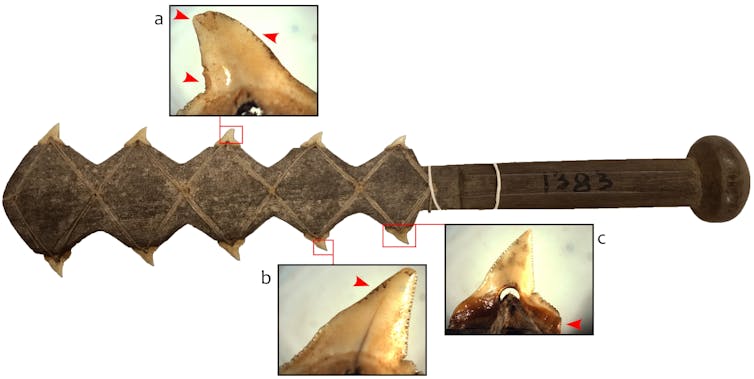
Other Shark Tooth Archaeological Finds
Almost all shark-tooth artefacts recovered globally have been identified as adornments, or interpreted as such.
Indeed, modified shark teeth have been recovered from older contexts. A solitary tiger shark tooth with a single perforation from Buang Merabak (New Ireland, Papua New Guinea) is dated to around 39,500–28,000 years ago. Eleven teeth with single perforations from Kilu (Buka Island, Papua New Guinea) are dated to around 9,000–5,000 years ago. And an unspecified number of teeth from Garivaldino (Brazil) is dated to around 9,400–7,200 years ago.
However, in each of these cases the teeth were likely personal ornaments, not weapons.
Our newly described Indonesian shark tooth artefacts, with their combination of modifications and microscopic traces, instead indicate they were not only attached to knives, but very likely linked to ritual or conflict.
Whether they cut human or animal flesh, these shark teeth from Sulawesi could provide the first evidence that a distinctive class of weaponry in the Asia-Pacific region has been around much longer than we thought.![]()
Michelle Langley, Associate Professor of Archaeology, Griffith University; Adam Brumm, Professor, Griffith University; Adhi Oktaviana, PhD Candidate, Griffith University; Akin Duli, Professor, Universitas Hasanuddin, and Basran Burhan, PhD candidate, Griffith University
This article is republished from The Conversation under a Creative Commons license. Read the original article.
Brown, red, black, riceberry – what are these white rice alternatives, and are they actually healthier?

Throughout history, rice has remained an important food staple. It supports the nutritional needs of more than half of the global population.
While you might be familiar with a handful of types, there are more than 40,000 different varieties of cultivated rice – a testament to the diversity and adaptability of this staple crop.
Rice, much like other grains, is the edible starchy kernel of a grass plant. In fact, the vast majority of rice varieties (although not all) belong to just one species – Oryza sativa.
If you have ever found yourself at the supermarket, overwhelmed by the number of rice options available, you are not alone. From aromatic Thai “jasmine” rice used in curries, to the “basmati” rice of India and the sticky “arborio” for making creamy Italian risotto, each variety, or cultivar, is distinguished by its grain length, shape and colour.
Each cultivar also has its own flavour, texture and unique nutrient properties. To make things more complicated, some varieties are higher in anthyocyanins – antioxidants that protect the body’s cells from damage. These rice varieties are known by their colour – for example, red or black rice.
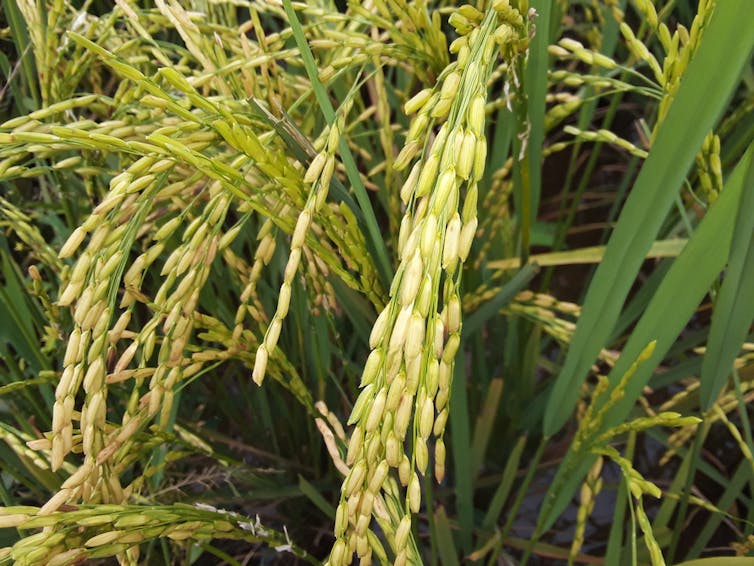
What Is Brown Rice?
Compared to white rice, brown rice is a whole grain with only the inedible outer hull removed. It is largely grown in India, Pakistan and Thailand.
To make white rice, the bran (outer shell) of the grains is removed. In brown rice, the bran and germ (core of the grain) are still intact, giving this type of rice its tan colour and high fibre content. Brown rice naturally contains more nutrients than white rice, including double the amount of dietary fibre and substantially higher magnesium, iron, zinc and B group vitamins, including folic acid.
Brown rice also contains polyphenols and flavonoids – types of antioxidants that protect the body from stress.
It is often sold as a longer grain option and has a similar nutty flavour to black and red rice cultivars, though some chefs suggest the texture is slightly chewier.

Fancy Black Rice
While not as common as other varieties, black rice – also called purple rice due to its colouring – is high in anthocyanins. In fact, black rice contains the same antioxidant type that gives “superfoods” like blueberries and blackberries their deep purple colour.
The Oryza sativa variant of black rice is grown primarily in Asia and exported globally, while the Oryza glaberrima variant is native to and grown only in Africa. Among black rices there are also different shades, from japonica black rice, Chinese black rice, Thai black rice through to Indonesian black rice.
With its antioxidant properties, some would argue black rice is one of the healthiest choices due to its protective effects for heart health and metabolic diseases.
Black rice can be a short, medium or long grain and has only the outermost layer (inedible hull) removed for consumption. The bran and germ remain intact, similar to brown rice, making it a high fibre food. Black rice has been described by some foodies to have a mild nutty and even slightly sweet flavour.

Iron-Rich Red Rice
Similar to black rice, red rice, or Oryza rufipogon, is a medium or long grain variety coloured by its anthocyanin content. Interestingly, it is considered an edible weed growing alongside other rice varieties and primarily grown in Asia as well as Northern Australia.
The difference in colour compared to black rice types is due to the amount and type of anthyocyanins (specifically catechins and epicatechins) in red rice.
Red rice also contains more iron and zinc compared to white, black or brown varieties. The anthocyanins found in red rice are used as a pigment for colouring other foods such as liquor, bread and ice cream.
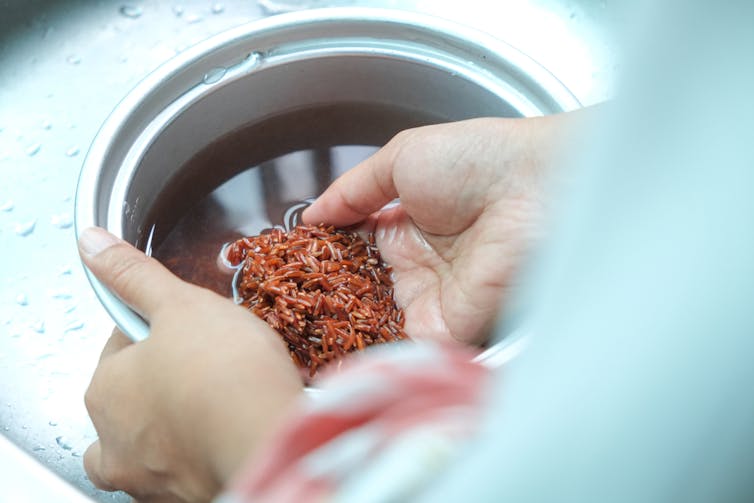
Is Riceberry A Type Of Rice, Too?
Despite the slightly confusing name, riceberry rice was originally developed in Thailand as a cross between a local jasmine rice and local purple rice variety, creating a lighter, purple-coloured grain.
Increasingly available in Asian grocers across Australia, this type of rice has a more favourable nutrient profile than brown rice and has a shorter cooking time similar to that of white jasmine rice.
Rice Is Not Just Another Carb
Rice has many nutritional benefits besides providing the body with carbohydrates – its primary fuel source. Rice contains more than 15 essential vitamins and minerals including folic acid, magnesium, iron and zinc and is naturally gluten free, making it an appropriate substitute for people living with coeliac disease.
Brown, red and black rices are also whole grains, recommended as part of a healthy eating pattern.
In addition, different cultivars of rice have a low glycaemic index or GI – a measure of the speed at which carbohydrates raise blood sugar levels.
Generally speaking, the more colourful the rice variety, the lower its GI. This is a particularly important consideration for people living with diabetes.
Less frequently consumed rice varieties have nutritional benefits, including their anthocyanin and fibre content. However, they can be harder to find and are often pricier than more common white and brown varieties.
If you enjoy trying foods with unique flavours, try experimenting with black or red rice varieties. Whatever the colour, all types of rice have a place in a balanced diet.![]()
Yasmine Probst, Associate professor, University of Wollongong; Karen Zoszak, Accredited Practising Dietitian, PhD Candidate, University of Wollongong, and Olivia Wills, Accredited Practising Dietitian, PhD candidate, University of Wollongong
This article is republished from The Conversation under a Creative Commons license. Read the original article.
‘Now I am become Death, the Destroyer of Worlds’ – the Bhagavad Gita explained
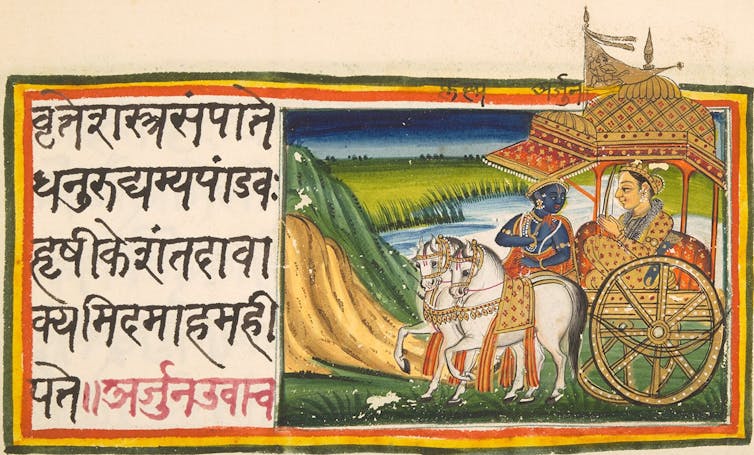
In our Guide to the Classics series, experts explain key works of literature.
There is a striking photo, taken in 2015, of a deactivated nuclear missile at an air and space museum in Tucson, Arizona. Written in dust on this missile are the words, “Now I am become Death, the Destroyer of Worlds”. These words, from the Sanskrit scriptural text the Bhagavad Gita, are famously attributed to J Robert Oppenheimer, the architect of the atom bomb.
In Christopher Nolan’s grand biopic, Oppenheimer, the physicist recites these lines not during the Trinity blast (the first detonation of this nuclear weapon) but in a scene with his lover Jean Tatlock.
Oppenheimer later referenced another verse from the Bhagavad Gita when recalling his state of mind as he witnessed the Trinity explosion in the New Mexico desert on 16 July, 1945:
If the radiance of a thousand suns were to burst at once into the sky, that would be like the splendour of the mighty one.
These verses refer to the sublime form, “Vishwarupa”, Lord Krishna takes in the Bhagavad Gita when he reveals his divine nature to the warrior prince, Arjuna.
“Who are you?” asks Arjuna.
“I am Time,” replies Krishna, “powerful destroyer of worlds, grown immense here to annihilate these men”.
Arjuna is blinded by Krishna’s radiance even as he quakes with fear at God’s capacity to destroy evil with the fire emanating from his ferocious visage.
Philosophical Insights
The Bhagavad Gita consists of 700 verses (shlokas) and appears in Book Six of the Sanskrit epic, The Mahabharata. At 100,000 verses and seven times the combined length of the Iliad and the Odyssey, the Mahabharata is the longest poem in the world. Written between 400 BCE and 200 BCE, the epic acquired its written form around the fourth century AD, during the Gupta Empire.
The Bhagavad Gita dramatises a meditative exchange between Arjuna and Lord Krishna, who appears as his charioteer during the momentous battle between two clans, the Pandavas and the Kauravas.
The battlefield is located in Kurukshetra, a town close to New Delhi. Each clan stakes its claim to be the mightiest ruling dynasty of erstwhile Bharat (present day India).

Poets, philosophers, scientists, public intellectuals and political leaders have been enthralled by the Bhagavad Gita since its first English translation appeared in 1785. Wherein lies Gita’s popular appeal across oral and performative cultures?
The Gita is more than just a sacred text of the Hindus. It distils insights from several schools of philosophy in classical India. Wilhelm von Humboldt, the renowned 19th century German scholar and philologist, called the Bhagavad Gita “the most beautiful, presumably the only real philosophical poem of all known literatures.”

The Indian nationalist leader Mahatma Gandhi revered the Bhagavad Gita as an “infallible guide to conduct,” a beacon to an ethical life combining political pragmatism with devotion to a spiritual cause higher than the self.
The American transcendentalists Ralph Waldo Emerson and Henry David Thoreau admired the Bhagavad Gita’s non-doctrinal universal humanism, and what they perceived as the text’s unity of spirit and matter.
Thoreau famously carried a copy of the text to Walden Pond where he imagined himself communing with a Hindu priest on the banks of the Ganges. The Bhagavad Gita inspired the theosophist Annie Besant and an array of insurgent poets, novelists, and intellectuals at the turn of the 20th century including EM Forster, Christopher Isherwood, WB Yeats, Aldous Huxley, and TS Eliot.
A Recurring Predicament
The Oxford philosopher and president of India from 1962-1967, Sarvapalli Radhakrishnan, once remarked the trauma of the two world wars spurred thinkers to turn to Gita for “its dramatization of a perpetually recurring predicament.” Radhakrishnan’s treatise on the Bhagavad Gita continues to be a revered scholarly source.
Th “recurring predicament” at the heart of the Bhagavad Gita is this: what constitutes righteous action in the face of moral ambiguity and the inevitability of violence?
Arjuna is fighting to restore the honour and glory of the Pandavas. The Kaurava princes are malevolent usurpers and sadistic rulers. They are also Arjuna’s first cousins.
Fighting on their side are Arjuna’s uncles and mentors. Halfway through the battle, Arjuna is paralysed by anxiety at the prospect of killing his kin. He contemplates throwing away his mighty weapons and fleeing the battlefield.
This is when Krishna, his charioteer and brother-in-law, counsels him with these immortal words:
Your obligation is to the action, and never to its fruits.
Do not be motivated by the fruit of your actions.
But do not become attached to non-action either.
Abandon your attachment and engage in
worldly action, Arjuna, while standing firm in discipline
(yoga). Consider success and failure to be equal.
This equanimity is called discipline, Arjuna, since the
action itself is much less important than the discipline.
Krishna in the Gita is none other than Vishnu, Lord of the Hindu trinity who preserves the world.
Krishna exhorts Arjuna to fulfil his duty (dharma) as a Kshatriya (warrior) in a spirit of detachment and with steadfast discipline (sthitaprajna). In classical India, these warriors had a monopoly on legitimate violence to preserve social and political order.
The greater good, Krishna tells Arjuna, lies far beyond earthly desires and attachments. The body dies but the soul is immortal. The noblest action is that which recognises the immortal value of the soul and ceases to lament loss and frustrated desire. This action, known as “Nishkama Karma” is taken without any anticipation of a fruitful outcome; action that abjures the myth of control.
Fear of consequences cannot be a justification for inaction. Duty toward the preservation of the moral order is far more important.
Self-knowledge, action without attachment and devotion to Krishna as the supreme soul that contains the entire universe is the path to salvation (moksha). This constitutes the essence of Krishna’s message to Arjuna.
Discipline
Oppenheimer referred to the Gita in a note to his brother in 1932 when he wrote about the importance of discipline and detachment in the fulfilment of obligations to one’s country and to humanity at large.
At the time, Oppenheimer was engaged in a serious study of Sanskrit texts with his Berkeley mentor and professor of Sanskrit, Arthur W Ryder.
He seemed obsessed with terms such as “sthitaprajna” (disciplined stillness) and “karma yoga” (disciplined action) that recur in the Gita. He was beginning to confront the moral conundrum of unleashing the force of the split atom on an increasingly strife-torn world.
Project Y, the secret laboratory in Los Alamos where the atom bomb was created, was somewhere on the horizon and would take concrete shape in a few years. Gita’s message offered a salve to Oppenheimer’s existential angst.
“I believe that through discipline,” Oppenheimer writes his brother Frank, “[…] we can achieve serenity…”
I believe that through discipline we learn to preserve what is essential to our happiness in more and more adverse circumstances […] Therefore, I think that all things which evoke discipline: study, and our duties to men and to the commonwealth, war […] ought to be greeted by us with profound gratitude.
Popular Appeal
The Gita “burst out of its confinement” in the 20th century, writes the Cambridge historian Christopher Bayly,
precisely because it spoke to contemporary global concerns on the following issues: violence and nonviolence, the individual’s duties to society, the boundary between the spiritual and the social, the significance of individual action as compared with fate, the role of the founders of nations in history.
The popular appeal of Bhagavad Gita lies in its dual message of dispassionate action and devotion to Krishna as the embodiment of universal soul-force. Temples across India offer discourses on Gita as part of their evening prayers, a practice popularised by Gandhi in his ashrams.
The Hare Krishna and Chinmaya movements have been inspired by the Gita’s philosophical teachings, as has the Ramakrishna Mission, one of the largest philanthropic and spiritual congregations in India, with branches across the globe.
The Gita has inspired a rich poetic and performative culture. Oral musical and theatrical traditions in South and Southeast Asia enact the exchange between Krishna and Arjuna. “Pieces of the Gita and Krishna float through international musical culture”, writes Richard Davis:
In his posthumous album titled Om (released in 1968), John Coltrane and fellow musicians open and close their improvised free jazz composition by chanting a translated passage from the Gita.
In 1980, the composer Philip Glass staged an opera, Satyagraha, in which he blended Sanskrit chants from the Gita with Gandhian philosophy of non-violence.
While the popular appeal of the Gita lies in its recognition of God-like qualities in the human, the text warns us against the dangers of man as the “herd animal” and men who aspire to dominate the world.
When men deem themselves to be gods on earth […] when they are this deluded by ignorance, they develop a satanic perversity that proclaims both in knowledge and power.
These words have deep relevance for our time as we confront existential threats posed by atomic weapons, artificial intelligence and climate change.
The quest for mastery over human and nonhuman worlds has made our planet fragile. We might do well to heed Gita’s warning even as we dwell on its philosophy of righteous action and devotion to a cause beyond the self.![]()
Debjani Ganguly, Professor of Literature, Australian Catholic University
This article is republished from The Conversation under a Creative Commons license. Read the original article.
More Bluey, less PAW Patrol: why Australian parents want locally made TV for their kids
Liam Burke, Swinburne University of TechnologyAustralian kids today have greater access to screen entertainment than any generation before. Across smartphones, tablets, laptops and the old-school TV set, streaming services mean there is an endless supply of kids’ content from around the globe.
But as our new research shows, many Australian parents still want Australian-made content for their kids because it reflects local experiences. It also tends to balance fun with education.
What Is Happening To Australian Kids’ Content?
In 2020, the federal government removed quotas for local children’s television on free-to-air commercial networks. This has had a significant impact on what is available on our screens.
In August, the Australian Communications and Media Authority found Australian children’s content on commercial broadcasters had dropped by 84% between 2019 and 2022.
Meanwhile, with Network 10 now a subsidiary of global media conglomerate Paramount, pay TV children’s channel Nickelodeon moved from cable to free-to-air in August this year.
So at a time when Australian kids’ content is disappearing from TV screens, hit overseas shows like PAW Patrol (a program about cartoon rescue dogs), SpongeBob SquarePants and Blaze and the Monster Machines are more available to Australian families than ever before.

Our Research
We surveyed Australian parents as part of a broader research project on Australian children’s television cultures.
The national survey involved 333 parents of children 14 years and under between August and October 2022.
We asked about how Australian families find, watch and value local kids’ TV in an era of streaming services and global distribution.
Our Findings
Our research suggests Australian parents strongly value local TV content for their kids. Of those surveyed, 83% say it is important their children see Australian-made programs. As a New South Wales dad-of-one explained:
[local TV] leans into our unique heritage without alienating those who have other experiences. Teaching about what it means to be Australian without creating a firm definition.
When asked what characteristics make “good” Australian children’s shows, parents said relatability, positive messages and humour were key. A Queensland father described how local shows instil
Australian values like fair play and helping your mate as opposed to the US-style ‘look out for number one’.
Parents also explained how humour was relaxed but not crude. As a mother-of-two remarked “poop jokes are fine” – a reference to how rude moments from Bluey have been cut by international distributors.
Showing Australian Reality On TV
Perhaps unsurprisingly, parents identified Bluey as the show most watched by their youngest (65%) and oldest child (39%).
Most parents also highlighted education as an important feature of Australian children’s TV. Many drew contrasts with international content to make the point that Australian children’s television tends to pair education with fun and does not “talk down” to children.
Highlighting Little J & Big Cuz – an animated series about two Indigenous Australian children living with their Nanna – a Tasmanian father celebrated how local kids TV
doesn’t shy away from the reality that kids experience and incorporates the wide variety of ‘real Australia’ without being cliched.
A mum from a Canadian-Australian household noted how, unlike overseas content, local shows such as Kangaroo Beach highlight things that are important to Australian life, such as water and sun safety. Similarly, a Melbourne mum emphasised how local specificity is important for young children.
it can be hard to explain why we can’t get snow in the winter in Australia.
Kids Are Still Watching TV On TV
In an era of seemingly endless streaming services, we asked about the devices parents use to access children’s television.
A huge 95% of surveyed households still use television sets to watch children’s shows and content. But the most popular “channels” are almost exclusively streaming services, such as ABC’s video-on-demand services (93%), Netflix (73%), YouTube (66%) and Disney+ (60%). The next most popular devices were tablets (53%) and smartphones (30%), while older children often used computers (21%).
Streaming services without clearly demarcated “kids” sections or that are not well-known for “all-ages” entertainment were less frequently used than those with prominently placed areas for children’s programming.
Four times as many parents identified Disney+ as a service their children use compared to Prime Video, despite Prime Video having a similar number of Australian subscribers.
Safety Is Key
We also asked parents about what features and functionality they value in streaming services.
They are concerned about safety, with participants identifying parental settings and controls as the most important feature of streaming services so their children don’t end up watching inappropriate content.
Parents also emphasised the importance of streaming services having content that can be watched together, with nine out of ten parents watching TV with their kids (usually at weekends).
Bluey was the show parents were most eager to watch with their children (60%) Other programs parents were happy to watch with their kids included time-tested Disney movies like The Lion King and Frozen and Australian favourites like Play School and Little Lunch – a program set in a suburban primary school.
What Now?
At a time when audiences have access to shows from across the globe on multiple devices, the Australian parents in our research still value content that communicates local experiences and culture.
However, with protections for the Australian children’s television sector removed it remains to be seen how long can locals such as Bluey fend off overseas rivals like PAW Patrol.
If you’re a parent or guardian with children up to 14 you can participate in our current research on the role of local children’s TV by taking this short survey.
Australian Children’s Television Cultures is a Swinburne University of Technology project in collaboration with RMIT University.![]()
Liam Burke, Associate Professor and Cinema and Screen Studies Discipline Leader, Swinburne University of Technology
This article is republished from The Conversation under a Creative Commons license. Read the original article.
Research To Unlock Secrets Of Muscle Loss In Ageing

We believe our innovative approach has the potential to lead to new therapeutic approaches to promote muscle strength and resilience, to ultimately enhance the well-being and vitality of ageing individuals. - Associate Professor Andy Philp

Aged-Care Funding Must Be Overhauled To Stop Beds Sitting Empty: CEDA
- Recruit personal-care workers directly by introducing a new “essential skills visa” to allow workers to migrate with long-term residency opportunities. This visa would only be for areas of critical need such as aged care, childcare, disability and healthcare.
- Introduce a user-pays system for aged-care clients who meet certain income or asset thresholds, to help ensure the long-term viability of the sector.
- Prioritise key worker housing in regional areas under the national Housing Accord and look at options for rental assistance such as the National Rental Affordability Scheme.
Aged Care Design Ideas Competition Now Open
- quality of life for older people
- the working environments of the people who care for them.
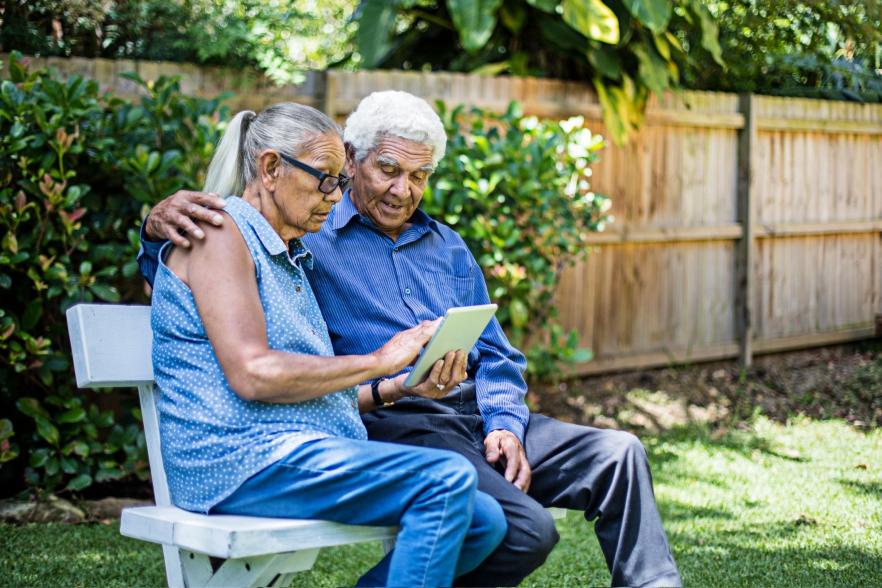
National Immunisation Program – Changes To Shingles Vaccination From 1 November 2023
- people aged 65 years and older
- First Nations people aged 50 years and older
- immunocompromised people aged 18 years and older with medical conditions including:
- haemopoietic stem cell transplant
- solid organ transplant
- haematological malignancy
- advanced or untreated HIV.
AMA And Private Healthcare Sector Leaders Agree On Need For Reform
If you’re 65 or over and want to work, you’re far better off in New Zealand than Australia

Want to keep working after you’ve reached pension age?
The Australian government has just made it a little bit easier, increasing the amount you can earn per year from work before losing some of your pension by A$4,000 on an ongoing basis.
Late last year, it temporarily upped the so-called work bonus from $7,800 per year to $11,800 to “incentivise pensioners into the workforce”. It was part of the government’s response to its September jobs and skills summit.
It meant pensioners could earn an underwhelming $227 per week from work without harming their pension, up from the previous $150.
The rules for older workers are very different in New Zealand. In fact, if Australia adopted New Zealand’s approach, we could have an extra 500,000 willing workers – a fair chunk of them paying tax.
What’s NZ Doing Differently For Older Workers?
Last month, as part of his employment white paper, Australian Treasurer Jim Chalmers made the increase to $227 per week permanent.
Chalmers headlined the announcement: Getting more Australians back into work.
But it’s doing an underwhelming job. In Australia, 15.1% of the population aged 65 and older are in some kind of paid work, up from 14.7% a year earlier.
In contrast, in New Zealand the proportion has just hit 26%. That’s right: more than one-quarter of New Zealanders aged 65 and older are employed.
It’s a similar story if we look at how Australia and New Zealand compared to others internationally on labour force participation (which covers those in paid work plus people actively looking for it).
New Zealand wants to see that number rise further. It has been talking about 33.1% of its population aged 65 or more in paid work, which is what Iceland has.
What is New Zealand doing for over-65s that Australia is not?
You won’t find it mentioned in either treasury’s employment white paper (released in September) or intergenerational report (released in August) – even though National Seniors Australia pointed it out in submissions.
One crucial thing New Zealand is not doing is annoying pensioners who work.
Australian pensioners in paid work get called in for discussions with Centrelink, if it looks as if they are at risk of doing too many hours and going over the $227 per week limit.
The More You Work, The More Your Pension Is Cut
Pensioners who do go over the $227 per week limit lose half of every extra dollar they earn in a cut to their pension.
Plus tax, this means they lose a total of 69% of what they earn over the limit where their tax rate is 19%, and 82.5% on the portion of earnings taxed at 32.5%.
And this is after the boost designed to “incentivise pensioners into the workforce”.
Last year’s jobs summit also set up a Women’s Economic Equality Taskforce. It reported this week, drawing attention to the “disincentive rates” facing second earners (usually women) who return to work after caring for children.
It said that taking the loss of benefits, tax and childcare costs together, the penalty for returning to work was more than half of what was earned on the first three days of the week, and up to 110% of what was earned on the fourth and fifth days.
My point here is that the losses facing age pensioners who attempt to work are of a similar order – in Australia but not in New Zealand.
Australia’s rules aren’t just stopping pensioners from taking on extra hours. They seem to stop them taking up paid work at all.
There were 2.6 million Australians on the age pension in June this year. Only 83,925 reported income from working. That’s just 3.2%.
NZ Pensioners Keep Their Pensions
What’s different about New Zealand is that New Zealand’s pensioners don’t face a penalty if they work. They simply face income tax.
In New Zealand, the age pension (which is called superannuation, making it confusing for Australians) is paid to everyone of pension age. There’s no income test or assets test. You get it because you are a citizen or permanent resident.
Australia wouldn’t need to go as far as New Zealand to get the same benefit. We would simply need to ditch the pension income test in cases where that income came from paid work, leaving the assets test in place.
Then there would be no concern about working.
Half A Million Reasons For Change
If we made that change – and if the same proportion of older Australians chose to work as New Zealanders – we would soon have an extra half a million older Australians able to step into fields such as teaching, where there are 15,500 vacancies, and health care and social assistance, where there are 68,100 vacancies.
It would cost the federal government money because it’d put more Australians of pension age on the pension.
But it’d cost less if we abolished the special tax concession for seniors and pensioners, known as the seniors and pensioners tax offset. In New Zealand, senior citizens face the same tax rates as everyone else.
And it would cost less as more pensioners earned wages and paid income tax.
Calculations prepared for National Seniors Australia by Deloitte suggest that beyond a certain point, the change would become revenue-positive – actually boosting federal coffers – as the extra income tax revenue outweighed the cost of the extra pensions.
National Seniors is calling its campaign “let pensioners work”.

Tapping Into The Cash Economy
Importantly – and here’s where we get to a fact National Seniors might not like me mentioning – that would happen not only because more senior Australians were employed, but also because more senior Australians were employed legitimately.
It’s hard to get a handle on how many senior Australians are working and being paid in cash, which they store rather than bank to avoid tripping the income test. But we do know this.
At the end of March, there were 18 Australian $100 notes in circulation for each Australian resident, an astonishingly high proportion given the use of cash for transactions is collapsing.
In New Zealand at the end of March, there were just five New Zealand $100 notes in circulation for each New Zealand resident.
That may be just a coincidence.
But New Zealand is certainly making it easier for retirees to work legitimately, rather than stay at home or accept cash in hand.![]()
Peter Martin, Visiting Fellow, Crawford School of Public Policy, Australian National University
This article is republished from The Conversation under a Creative Commons license. Read the original article.
A New Men's Table At Narrabeen

Government Continues Significant COVID-19 Support For Aged Care
AER Alleges Breach Of Retail Law By CAM Engineering
Federal Government’s Incentives For Older People To Work Good Step Forward For Every Generation: COTA
Mimics Human Tissue, Fights Bacteria: New Biomaterial Hits The Sweet Spot

UTS: How To Slow The Spread Of Deadly 'Superbugs'
- Establishing a national One Health antimicrobial resistance surveillance programme incorporating genomics
- Increase antimicrobial resistance awareness and education and foster collaboration
- Enhancing laboratory capacity in lower and middle-income countries
- Encouraging research and innovation
- Strengthening regulation and oversight in agriculture
- Improving antibiotic stewardship
Consumers Urged To Use And Store Lithium-Ion Batteries Safely To Prevent Deadly Fires: ACCC
- Monitor charging times of lithium-ion products and disconnect products from chargers once they are fully charged. Consider setting timers as a reminder to unplug products.
- Keep lithium-ion batteries out of household garbage or recycling bins and kerbside hard waste collections.
- Charge lithium-ion batteries and products away from combustible materials such as beds, sofas or carpet.
- Store batteries and lithium-ion products in cool, dry places and out of direct sunlight, including while charging.
- Do not use batteries, products or chargers that are overheating or showing signs of failure such as swelling, leaking or venting gas.
- Check the charger you are using is suitable for the product being charged.
- Allow time for batteries to cool after use and before charging.
- In the event of a fire, consumers should contact 000 immediately. For more information on what to do in case of fire or explosion contact your state or territory fire department.
Young Australians increasingly get news from social media, but many don’t understand algorithms

Adults might assume young people are not engaged in current affairs.
But our survey reveals most Australian children and teenagers have a significant interest in the news. There has, however, been a drop in interest from our 2020 survey, done at the start of COVID.
Our research also shows children and teenagers increasingly get news from social media but many do not understand how algorithms select the news they see.
This suggests there needs to be more focus on teaching media literacy in schools.
Our Study
In June, we asked 1,064 children and teens (aged eight to 16) from around Australia how they access and consume news media. This repeats earlier surveys we did in 2017 and 2020.
When asked about the news they accessed yesterday, most young people (83%) said they had received it from at least one source. One third (33%) used three or more sources.
There has been a drop in young people’s news engagement since the 2020 survey, which was conducted at the end of the Black Summer bushfires and the start of COVID. In 2020, 88% of young people had consumed news from at least one source and they were getting news more frequently from family, friends, teachers and television.
This decline mirrors a 2023 survey on Australian adults, which suggests people increase their news consumption during major national events.
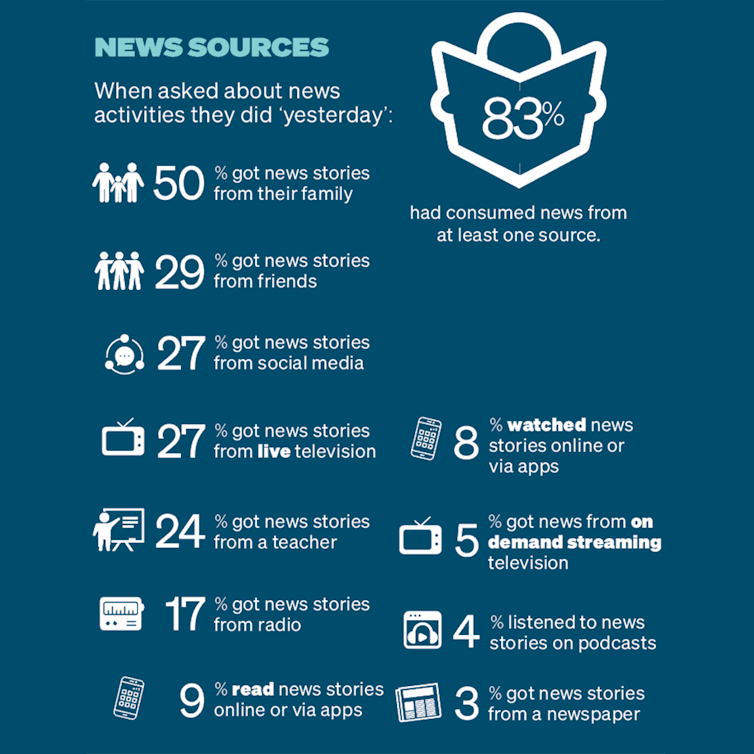
Where Do Children And Teens Get Their News From?
Family and friends were the top sources of news for young people, with survey respondents also reporting high levels of trust in these sources.
But social media is an increasingly important source of news, moving ahead of television for the first time for teenagers. Almost four in ten children (37%) and more than six in ten teens (63%) say they often or sometimes get news from social media. This compares to 39% of children and 41% of teens who often or sometimes get news from live TV.
Interestingly, when young people were asked about getting news on social media, only a small proportion (4-20% depending on the platform used) said they intentionally use social media to find or get news. Instead, they mostly report encountering news while they are using social media for other purposes.
When using social media to get news, half the children in our survey said they preferred YouTube, followed by TikTok (21%) and Facebook (13%). Teenagers preferred YouTube (31%), TikTok (24%) and Instagram (19%).
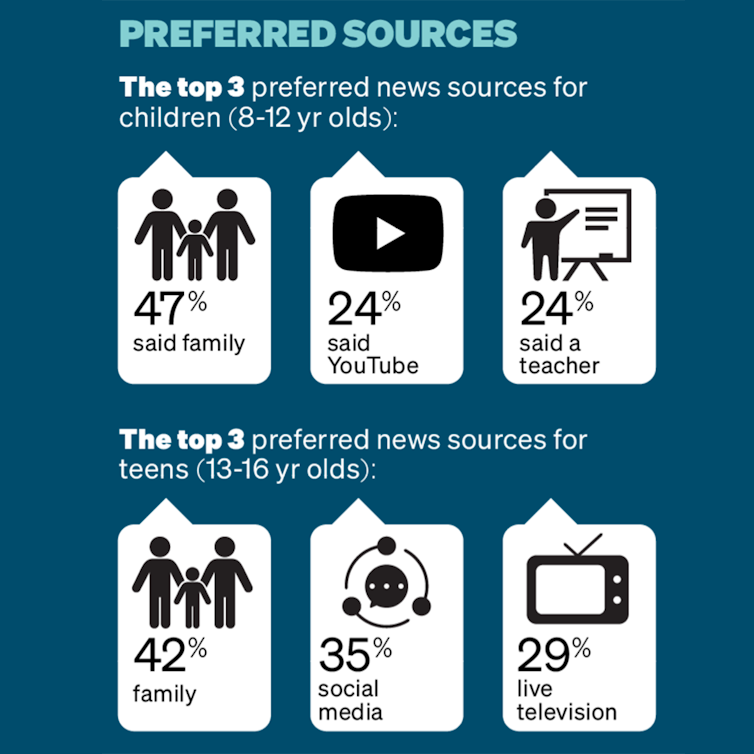
Knowledge Of Algorithms
Given so many young people regularly get news on social media – and this increases sharply as they enter their teen years — it is surprising only 40% of young people aged 12-16 years are familiar with the term “algorithm” in relation to news.
Technology companies – such as Google and TikTok – use algorithms to select news based on what they think users will like. This can skew the news people consume.
Just over half (56%) of the group who had heard of the term algorithm in relation to news viewed algorithms as a helpful tool that enhances the relevance of news to them. However, only 27% of this group trusted algorithms to curate balanced and accurate news.
This suggests there is an important opportunity for parents, educators and news organisations to increase young people’s understanding of how algorithms are used to deliver news online.
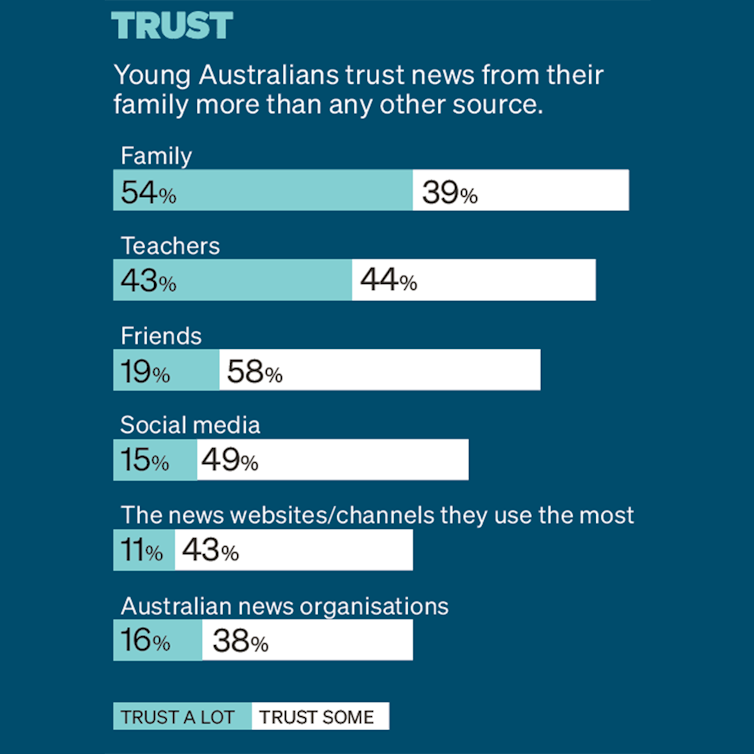
What About School?
The lack of awareness about the role algorithms play in delivering online news suggests children are not getting sufficient media literacy education in school.
Only one in four young people (24%) said they’d had a lesson at school in the past year to help them work out if news stories are true and can be trusted – and this is the same for children and teenagers.
Less than one third (29%) of respondents reported they had been taught how to create their own news story in the past year
What Happens When Young People Are Engaged?
We divided our respondents into five groups based on their level of engagement with news.
Young people with the highest level of engagement with news were four times more likely to report they often or sometimes ask critical questions about the news they consume than those with the lowest level of interest in news (76% versus 18%).
These critical questions include “how are different groups of people likely to respond to this news story?”, “how are people, places or ideas being presented in this news story?” and “what technologies were used to produce and share this news?”
Young people with a high level of engagement with news are also more likely to take actions that will help them to avoid misinformation. For example, they are six times more likely to report checking multiple sources to verify news when compared with young people with a low level of interest in news (63% versus 10%).
This suggests news engagement is linked to many positive outcomes that may help young people to avoid misinformation.
What Now?
The shift in young people’s news engagement toward social media highlights the need for consistent media literacy education across Australia.
This can help young people learn more about social media business models, visual modes of communication (particularly video), methods for identifying misinformation, privacy settings and how algorithms work.
This kind of education will help young people to grow up being engaged but critical news consumers and citizens. ![]()
Tanya Notley, Associate Professor in Digital Media, Western Sydney University; Michael Dezuanni, Professor, Queensland University of Technology, and Sora Park, Professor of Communication, News & Media Research Centre, University of Canberra
This article is republished from The Conversation under a Creative Commons license. Read the original article.
Some kids with reading difficulties can also have reading anxiety – what can parents do?

Australian children are facing some big challenges. NAPLAN data shows about one in three students in years 3 to 9 are behind in reading-related skills. It is also estimated about one in seven children have poor mental health.
Until recently, most people assumed these were separate problems. However, there is growing evidence difficulties with reading and mental health may be related in some children.
What Is Reading Anxiety?
Recent studies suggest reading anxiety may be the mental health problem most closely related to reading difficulty.
Reading anxiety is an excessive fear of reading that interferes with everyday life. For example, a child may be so anxious about reading they refuse to go school.
Like maths anxiety, reading anxiety can affect both children and adults. In one of our very recent studies (not yet published), we discovered 50% of children with reading difficulties appeared to have reading anxiety. That equates to around one in ten children at primary school.
How Does Reading Anxiety Happen?
Why might a child who struggles with reading also develop reading anxiety? Current evidence suggests the following hypothesis:
When a child first starts school, many children in their class will not read well. However, after a few months of reading lessons, most will start to improve. A few will not. Many of those children will get negative feedback about their reading from others (such as their teachers, parents and other students) or even from themselves.
They will then start to believe they are poor readers. Researchers call this a “poor reading self-concept”.
If a child believes they are bad at reading, they may start to feel worried or scared about reading, particularly in front of other people.
This anxiety can make it hard for them to concentrate in reading classes. Or they find a way to avoid going to reading classes at all, such as playing up in class so they get kicked out of the room.

A Negative Cycle
It is important to note these avoidance behaviours are an entirely reasonable response to reading anxiety.
Anxiety is a fight or flight response that evolved to keep humans alive. If you are facing a lion who wants to eat you (or you need to read in front of the class), the last thing you need to do is concentrate hard on learning how the lion’s growl sounds correspond to his paw movements (or how different letters correspond to different speech sounds).
What you really need to do is run away.
The trouble is, when it comes to reading, running away means not attending, or concentrating in, reading classes. This will make everything worse: your reading, your reading self-concept and your reading anxiety. This sets up a cycle of failure that gets stronger over time.
Is It Possible To Break This Cycle?
A couple of recent studies suggest we can help reading anxiety.
In 2021, a case intervention study gave eight Australian primary-school children 12 weeks of very intensive and targeted reading and anxiety intervention. All children showed significant improvements in their targeted reading and anxiety symptoms.
A 2020 Australian study delivered reading self-concept training to 40 children with reading difficulties. As a group, these children showed significant reductions in their non-productive coping strategies (such as procrastination or avoidance).
These results suggest it is possible to improve the mental health of children with reading difficulties with intensive and targeted training. But many more studies are needed before we can be sure.

What Can Parents Do?
What can parents do if they suspect their child has problems with reading anxiety?
First, it is important to know both the reading and mental health problems need to be treated by experts. It is not something parents can do alone at home.
However, a parent can help identify if a child needs help. As a starting point, they could ask their child’s teacher, or a reading clinician, to screen their child for problems with reading and reading anxiety. A good free screen for reading is the CC2 word reading test. A good free screen for reading anxiety is the Reading Anxiety Test or RAT.
If the results suggest a child has problems with both reading and reading anxiety, then teachers and reading clinicians can help parents find people to help. Not many people are experts in both reading and anxiety. But good clinicians will happily work together to support the diverse needs of children.![]()
Genevieve McArthur, Professor at the Australian Centre for the Advancement of Literacy, Australian Catholic University
This article is republished from The Conversation under a Creative Commons license. Read the original article.
‘We are worn out and no one cares’: why ambulance staff in UK and Australia are ready to quit the profession
Julian Hunt, Swansea University; John Gammon, Swansea University, and Peter Holland, Swinburne University of TechnologyThe COVID-19 pandemic may be over, but its scars remain for those on the frontline of the health sector – not least in the ambulance services. And our research conducted separately in the UK and Australia shows things are getting worse across the globe.
Ambulance staff in many other countries, including Germany, France, Poland, Spain, USA, Japan, Israel and India, are also facing increased pressures. This is due to more people using ambulance services, more complex patient needs, not enough staff and resources, and unmanageable workloads. All these factors have made it difficult for many ambulance services to operate.
We studied two services similar in size and structure: the Welsh Ambulance Services NHS Trust in the UK, and Ambulance Victoria in Australia. We found that both services are close to a point where they may not be able to meet the needs of the people they serve. And we identified similar issues and problems in both locations which are causing many employees to consider leaving the profession.
We found that nearly 45% of ambulance staff in Wales and 29% in Victoria are considering quitting. And in Victoria, 16% of ambulance services staff said they were looking to leave the profession within the next year, while 23% of participants in Wales said the same.
Unmanageable Workloads
These are highly skilled healthcare professionals who are thinking about leaving their jobs for good. The main reason staff in both services gave us is unmanageable workloads, with many echoing the sentiments of one another.
“The workload is huge and continues to grow. I regularly work 50 plus hours per week to keep on top of everything and still struggle.” (Wales)
“We are consistently given demands that are impossible to achieve. We are worn out and no one cares.” (Wales)
“I’m falling out of love with a job that I have loved and excelled at for nearly a decade and a half. Managers are pushing [targets] and budgets and times, while on road staff are exhausted.” (Victoria)
“Morale is the lowest I have ever seen in the ambulance service.” (Wales)
“Listening to the distressing phone calls I receive from road colleagues who are struggling … There is no respite of this pressure … I am hugely concerned for my frontline colleagues’ welfare.” (Wales)
These comments feed into the issues of staff retention in both services as demands intensify. However, there is a perceived lack of understanding and support from management and more critically, a lack of resources. The real concern lies in how this will impact the quality of care provided to patients in both places.
Our findings are supported by other research which indicates that ambulance services staff were the most likely to say their mental health had deteriorated following the COVID-19 pandemic, and by default, their ability to work effectively in the longer term.
Our research also shows that ambulance workers in Wales and Victoria, Australia are highly engaged and passionate about their work. They identify strongly with the job that they do. But they are approaching a crisis point due to increasing workload, burnout and low morale.

Potential Solutions
The problems we found in our studies can be solved by ambulance management on either side of the globe. The most important thing is to provide more resources to support and retain this highly skilled workforce, which could help to reduce burnout and keep staff in this essential job.
Ambulance services must prioritise improving staff wellbeing, and efforts to do so should be inclusive, employee-led and proactive. Creating a stable and sustainable workforce could help in responding to changes in service and health needs. All levels of management should be given the appropriate training too. Taking these approaches could ensure that the work of ambulance services staff and other healthcare professionals is properly valued.
We hope that the findings from our studies will be used to create new ways to improve the workplace culture in Wales and Victoria. We also welcome other healthcare organisation using our findings to protect and support the wellbeing of their staff.![]()
Julian Hunt, Research Officer School of Health and Social Care, Swansea University; John Gammon, Deputy Head (Innovation and Engagement) of the School of Health and Social Care, Swansea University, and Peter Holland, Professor in Human Resource Management and Employee Relations, Swinburne University of Technology
This article is republished from The Conversation under a Creative Commons license. Read the original article.
A light touch, a feel for drama and a generous nature: author Alex Skovron wins the Patrick White Award

If you have ever been to the launch of a small-press poetry book at Collected Works bookshop (now defunct), or at one of the Readings bookstores, or at a bar or café in Melbourne, you may have seen a small, fit-looking, bespectacled man. He has a ready grin and eyes that invite you in – often to a conversation you’ll remember for its warmth, intelligence, wit and passion for literature.
You will have encountered Alex Skovron, who has this year won the Patrick White Literary Award for his achievements in poetry and prose and his lifelong support for writers and writing in Melbourne and beyond.
This prize is awarded to a writer who might not have received the recognition that is due when that writer’s full contributions and achievements are considered. Writers do belong to a community, even if it is fractured, fractious, garrulous and competitive at times. The community is best characterised, though, by acts of generosity towards each other, and Skovron has been a behind-the-scenes master of generosity towards other writers.
Author of seven books of poetry and three works of fiction, Skovron has previously won the Anne Elder and Mary Gilmore awards for a first book of poetry, the Wesley Michel Wright Prize for poetry (twice), John Shaw Neilson Poetry award (twice) and Australian Book Review (now Peter Porter) Prize for a single poem. His novella, The Poet, was co-winner of the Christina Stead Prize in 2005.

Skovron worked as an editor for two Australian encyclopedia projects during the 1970s, then from 1980 with publishers Macmillan, Hutchinson, Dent and finally, Houghton Mifflin. Alongside this work, his quiet and sustained impact on poets and poetry in Melbourne has been immense.
Hundreds of poets, especially the young and emerging, have been edited, mentored and encouraged by Skovron. It is common to pick up a new book of poetry in Melbourne and find his name there on the acknowledgements page. He has offered reliable and consistent support to others for decades.
Born in Poland in 1948 and arriving in Australia via Israel as a ten-year-old, Skovron’s cultural and intellectual reach has always been global.
His work has been translated into French, Chinese, Dutch, Polish, Spanish, Czech, Macedonian and German. He has worked with his Czech translator, Josef Tomáš on book-length translations into English of two 20th-century Czech poets and his latest book, Letters from the Periphery, includes his translation of the first canto of Dante’s Inferno.
It is a shame poetry is not more widely read, enjoyed and appreciated in Australia. Skovron’s poetry has been wonderfully enriching, entertaining and provocative to its readers since his first published book, The Rearrangement, in 1988. His poems work attentively with shifts in tone and attitude, surprising line endings, pauses and rushes of thoughts and connections always towards an elegance toughened by life experience.
One poem, chosen almost at random, showcases these qualities:
For Light
If one is to be awoken by a cliché
the clatter of breakfast dishes is as good
as any, or the aroma of coffee
freshly brewed, or that uncanny mood
of holiday immensity, when the world
was twelve, or a summer’s garden when the worldwas good. Worst is the midnight
phonecall, or the way the disentangled mind
can brood a black density into being –
in the darknesses before seeing, lusting for light.
(from Towards the Equator: New & Selected)
His touch is light, his material is the experiences he knows and we do too and his feel for the drama lying in store for the most ordinary of us (living our clichéd lives) is somehow both seriously disturbing and finally settling.
He has been a poet who appreciates the largely unappreciated and passed-over aspects of workplaces, homes, marriages, streets and minds. So it is perhaps fitting he has now been recognised with a national award at 75. Perhaps at that moment in a life when a poet might think he has already passed unrecognised from most people’s view.
His poetry and his fiction surprisingly often turn to the Kafkaesque figure of an isolated everyman living slightly desperately but with an almost limitless potential for irony and humour.
One more poem offers a witty glimpse of this figure:
Homo Singularis
He would drive his car on the wrong side
of the seat, tried to obtain a licence to kill
time, at work he displayed considerable skill
at incompetence, at home he had to hide
the dismissal notes under the mattress he screwed
to the carpeted floor with nails. Rudehe was to a fault, nosey to boot,
inconsiderate to snails, he locked himself into books
of stamps and common prayer, funnelled his looks
into singles bars and hardly ever stepped foot
inside a song. Even his poems were too long.
(from Infinite City: 100 Sonnetinas)
To add to the detailed fun Skovron has with his compositions, we might notice the last line of this poem is its eleventh – in a book devoted to ten-line poems.
I would like to read, one day, Alex’s poem about this man receiving an award such as this.![]()
Kevin John Brophy, Emeritus Professor of Creative Writing, The University of Melbourne
This article is republished from The Conversation under a Creative Commons license. Read the original article.
Curiosity Rover Finds New Evidence Of Ancient Mars Rivers, A Key Signal For Life

Disclaimer: These articles are not intended to provide medical advice, diagnosis or treatment. Views expressed here do not necessarily reflect those of Pittwater Online News or its staff.
